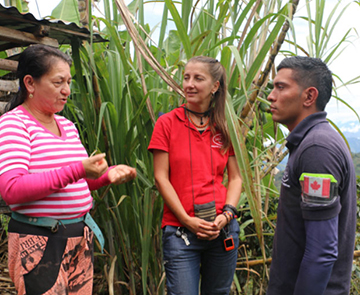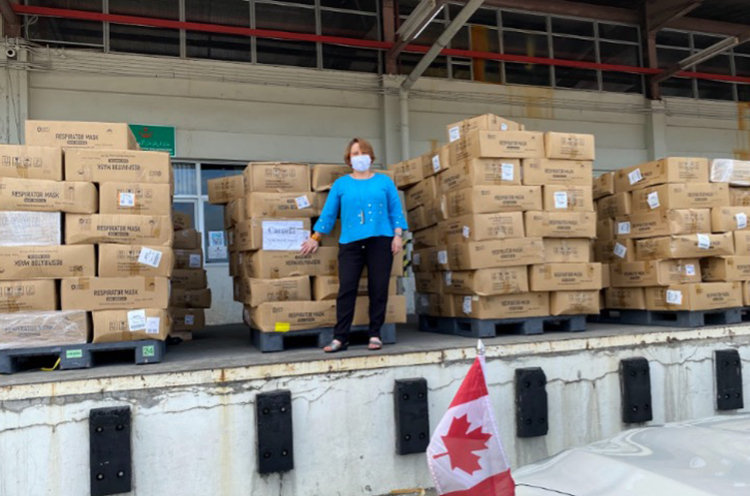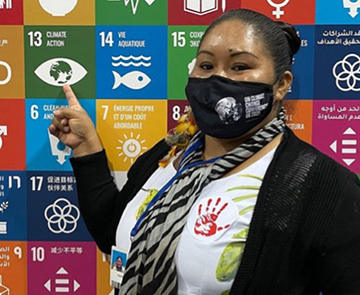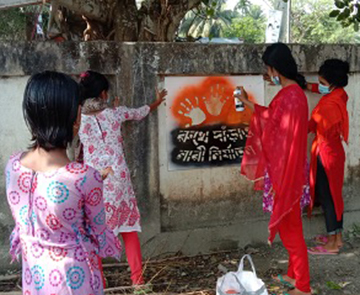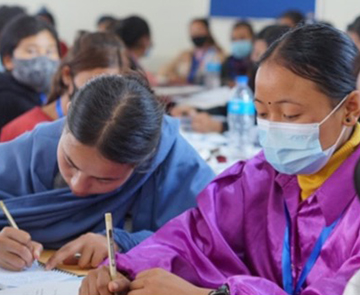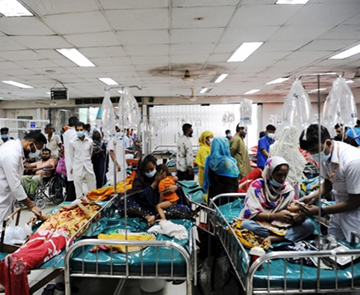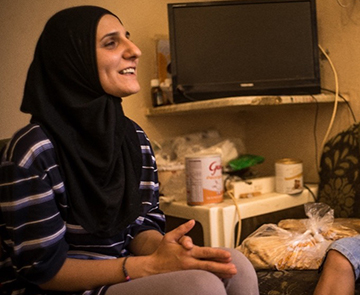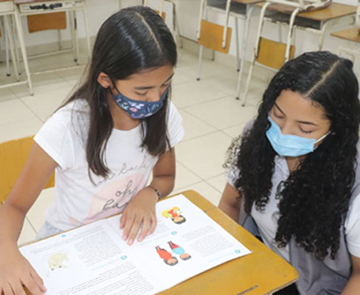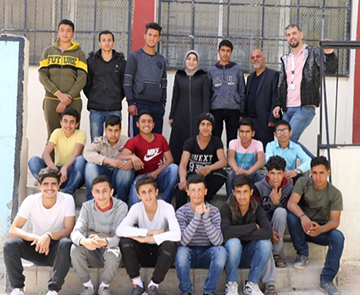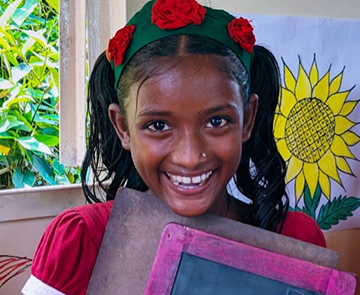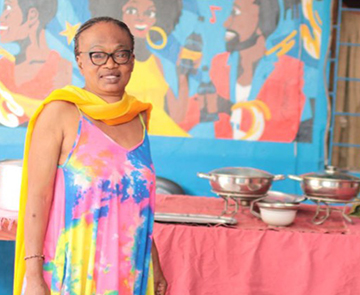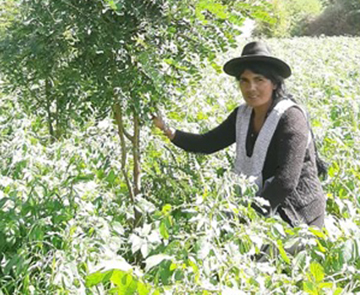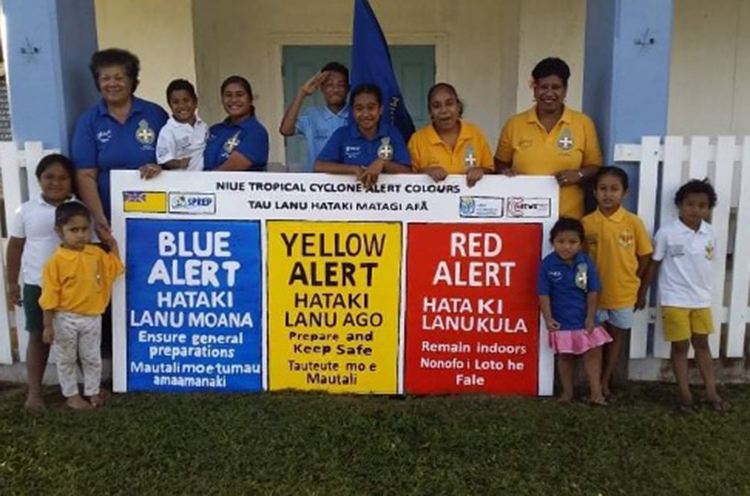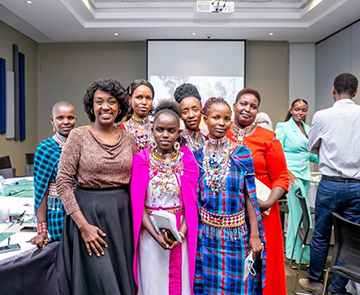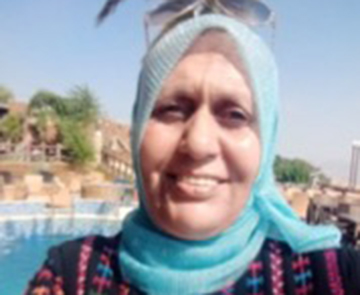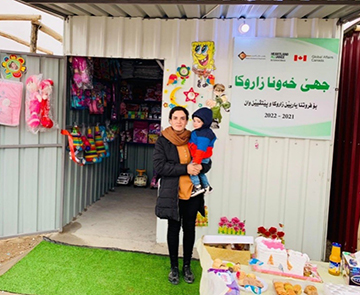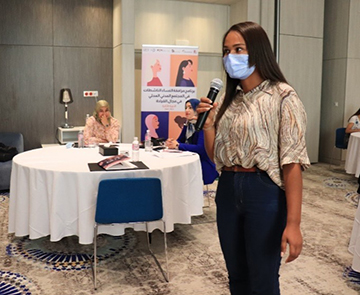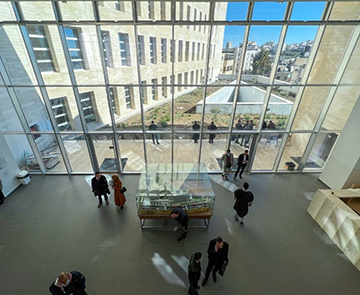Archived information
Information identified as archived is provided for reference, research or recordkeeping purposes. It is not subject to the Government of Canada Web Standards and has not been altered or updated since it was archived. Please contact us to request a format other than those available.
© BRAC
Report to Parliament on the Government of Canada’s International Assistance 2021-2022
ISSN #:
1926-3945Table of contents
- Volume 1
- Message from the Minister of International Development and Minister of Foreign Affairs
- Message from the Deputy Prime Minister and Minister of Finance
- Executive summary and Highlights
- Government of Canada’s International Assistance and Official Development Assistance Disbursements by Organization, 2021–2022
- 2030 Agenda and the SDGs
- Meeting the moment: Canada’s leadership in times of crisis
- Canada at work in the world: International assistance in action
- Moving forward: Partnerships and innovation
- Volume 2
- Introduction
- Section A: Canada’s engagement in World Bank Group operations
- Reporting requirements
- Governance and representation
- Canada’s financial contributions to the World Bank Group in 2021-2022
- Objectives and results of Canada’s WBG trust funds
- World Bank procurement from Canada
- Communiqués of the Development Committee of the Boards of Governors of the World Bank and IMF (as required under the Bretton Woods Act)
- Section B: Canada’s engagement in International Monetary Fund operations
- Governance and representation
- IMF resources, lending, and capacity development
- Communiqués of the International Monetary and Financial Committee of the Board of Governors of the IMF (as required under the Bretton Woods Act)
- Section C: Canada’s engagement in European Bank for Reconstruction and Development operations
- Footnotes
Volume 1
Message from the Minister of International Development and Minister of Foreign Affairs
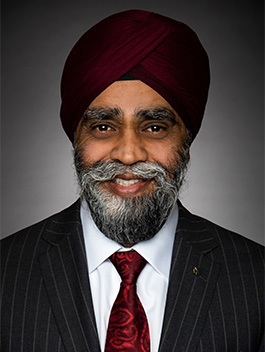

As the Ministers of Foreign Affairs and of International Development, we are pleased to present the 2021-2022 Report to Parliament on the Government of Canada’s International Assistance. This year, Canada responded to many extraordinary and ongoing challenges, including climate change and the pandemic recovery. Perhaps most importantly, and in partnership with allies and the international community, Canada responded to Russia’s aggression in Ukraine by providing economic, humanitarian, development and military assistance.
More broadly, Canada has supported the needs of the world’s poorest and most vulnerable, while upholding Canadian values. In doing so, Canada has relied on a range of partnerships to influence and empower change in the lives of others, and build a more just and sustainable world. This has included a commitment to the Triple Nexus approach that integrates humanitarian, development, and peace and security actions designed to more effectively respond to, and ultimately prevent, conflict.
Canada’s Feminist International Assistance Policy (FIAP) is a key pillar of Canada’s broader feminist foreign policy, and remains at the heart of all of Canada’s international assistance programming. Canada is committed to constantly improving how its international assistance is delivered using a feminist, human rights-based, and inclusive approach. This involves, above all, integrating the human rights principles of participation and inclusion, equality and non-discrimination, and transparency and accountability. We recognize this as necessary to achieve sustainable development for all.
Through the ongoing Grants and Contributions Transformation Initiative Canada is working to revamp, from start to finish, how it manages international assistance grants and contributions. The focus is on creating ways of working that are faster, more transparent and more flexible, enhancing Canada’s capacity to deliver results and sustainable impact that bring positive change in people’s lives.
Canada remains committed to the full implementation of the UN 2030 Agenda for Sustainable Development and to accelerating progress across the Sustainable Development Goals (SDGs) through the Decade of Action. In implementing the 2030 Agenda, our government aims to contribute to an inclusive and resilient global pandemic recovery, while building a more just and sustainable world where no one is left behind. We take pride in the contributions Canada made in 2021-2022 in advancing the SDGs.
In closing, we would like to thank our partners for their flexibility and adaptability. As illustrated in this report, these partnerships have allowed Canada to respond quickly and effectively to the multiple challenges facing our world today, and to prioritize the needs of vulnerable individuals and communities.
The Honourable Harjit S. Sajjan
Minister of International Development
The Honourable Mélanie Joly
Minister of Foreign Affairs
Thank you
Message from the Deputy Prime Minister and Minister of Finance

Canada contributes to making the world a better place by taking meaningful actions to promote human dignity and build a more just, inclusive, sustainable, and safe world for all.
This past year was marked by Russia’s illegal and barbaric full-scale invasion of Ukraine, killing thousands and forcing millions of Ukrainians to flee their homes and causing the greatest migration crisis in Europe since the Second World War. Canada continues to stand with Ukraine, and against Putin’s assault on the rules-based international order, by providing direct financial, military, and humanitarian assistance to Ukraine, and by imposing strict sanctions on Russia and Belarus.
I am particularly proud of the leading role Canada played in the creation of the International Monetary Fund’s (IMF) Administered Account for Ukraine. The Administered Account allows donor countries, including Canada, to provide grants or loans to directly assist Ukraine in meeting its urgent balance of payments and budgetary needs, and helping to stabilize its economy. Canada will continue to stand with the Ukrainian people—for as long as it takes—as they fight for their lives, their freedom, and their democracy.
I am also proud that Canada has now exceeded the Prime Minister’s commitment to channel 20% of Canada’s newly allocated IMF Special Drawing Rights to vulnerable and low-income countries, reaching a level of 30%. Canada’s new contribution to the IMF’s Poverty Reduction and Growth Trust and our support for the creation of the IMF’s new Resilience and Sustainability Trust enhanced access to concessional financing to countries that need it the most.
Canada’s feminist foreign policy is another significant achievement. This approach ensures that women and girls are at the centre of our international development work. Whether supporting sexual and reproductive health and rights, or delivering on gender-responsive climate-smart agriculture programs, Canada remains committed to implementing our Feminist International Assistance Policy—because investing in women and girls is the right thing to do and the smart way to reduce poverty and inequality.
As we reflect on the last year, Canada continued to help developing countries strengthen their response to the COVID-19 pandemic. This includes providing an accelerated and ambitious contribution to the 20th replenishment of the International Development Association (IDA20) of the World Bank, which represents a 44% increase in Canada’s international development assistance during the fiscal years covered by IDA20. This financial support has helped countries address the impact of COVID and food insecurity, and will enable a stronger recovery from the crisis.
Together with the Honourable Harjit S. Sajjan, Minister of International Development, and the Honourable Mélanie Joly, Minister of Foreign Affairs, I am pleased to present the Report to Parliament on the Government of Canada’s International Assistance 2021–2022.
The Honourable Chrystia Freeland
Deputy Prime Minister and Minister of Finance
© CFLI, Dominican Republic
Executive summary and highlights
The world is currently facing a series of complex and critical challenges: food and energy insecurity, the pandemic, the climate crisis, and threats to international peace. By working with its partners, Canada is leading the way in addressing these challenges through its international assistance programming. At the same time, it is advancing the 2030 Agenda for Sustainable Development in an effort to end poverty and inequality, build more prosperous and peaceful societies, and protect the planet.
Over the past year, Canada has continued to improve the lives of millions of people through its international development efforts, providing $7.9 billion dollars in 2021-2022 to meet global needs. This assistance has made a tangible difference in the lives of people around the world by supporting programs that tackle hunger and malnutrition, advance human rights, enhance global health, and promote gender equality.
Promoting gender equality and the empowerment of women and girls
At the heart of Canada’s international assistance is the belief that we can build a better world by advancing the rights and empowerment of women and girls. While progress has been made, gender inequality still persists, which leads women and girls to be disproportionately affected by poverty and other hardships and prevents sustainable development in all areas.
Canada’s efforts to address gender inequalities at the root of poverty and the unique challenges faced by women and girls are guided by our Feminist International Assistance Policy. In 2021-2022, the policy helped support transformational change in our partner countries and positioned Canada as a leader in gender equality. In fact, approximately 99% of Canada’s bilateral international development assistance this past year either targeted or integrated gender equality.
Canada’s funding has supported more than 1,800 women’s rights organizations that are promoting gender equality and advancing the rights of women and girls. This past year alone, Canadian-funded programs reached more than 42 million people through projects aimed at ending sexual and gender-based violence, including harmful practices such as child, early and forced marriage and female genital mutilation/cutting.
Preventing and responding to conflicts and crises around the world
Canada has a long history of working with international partners to prevent and respond to conflicts and crises abroad, including support for peace and stabilization operations. In 2021-2022, Canada’s Peace and Stabilization Operations Program provided $138.9 million to promote peace and stability in fragile and conflict-affected states including Ukraine, Cameroon, Colombia, Burkina Faso, Haiti, Iraq, Mali, Myanmar, and South Sudan. Canada has also supported the provision of high-quality, specialized peace operations training and capacity building that incorporates gender equality. This has strengthened the capability and credibility of military, police and civilian personnel deploying or already deployed to peace operations globally.
In 2021-2022, Canada’s humanitarian assistance contributed to addressing the needs of over 326 million people in need in 63 countries. This funding supported the work of trusted partners who provided life-saving assistance such as food, clean water and sanitation, and health care. In particular, Canada’s assistance helped respond to the growing global food crisis by reaching a record 128.2 million food insecure people—an impressive 11% increase over the previous year. In addition, we provided assistance and protection to almost 95 million refugees and internally displaced persons through the UNHCR. In fiscal year 2021-2022, Canada’s federal departments announced $145 million to respond to increased humanitarian needs in Ukraine and neighbouring countries. In addition, Canada sent 20 cargo flights with more than 377,000 essential relief items to the region.
Providing equal access to education and health care
It is estimated that 222 million crisis-affected children and adolescents around the world require educational support. Approximately 78 million children are out of school due to conflict, climate change and other protracted crises. In 2021-2022, Canada continued to focus on supporting children and youth experiencing forced displacement to access the education they deserve. In addition, Canada fulfilled its pledge to contribute $400 million over 3 years to the G7 Charlevoix Declaration on Quality Education, which has helped provide access to quality education and skills training for more than 4 million women and girls across Africa, Asia, Latin America and the Middle East.
In 2021-2022, Canada invested $1.3 billion in global health, including $561 million for sexual and reproductive health and rights. This funding provided family planning services to more than 3.3 million women in 28 countries and prevented more than 5.4 million unintended pregnancies.
Supporting the continued global response to COVID-19
While Canada has made progress in its efforts to build a world that is more peaceful and inclusive, the COVID-19 pandemic has hampered progress in many key areas. Throughout the pandemic, Canada has remained a leader in global efforts to address the pandemic’s devastating health, social, economic and security impacts.
From the onset of the pandemic and up to March 2022, Canada committed more than $2.7 billion in international assistance to address the effects of COVID-19. This includes approximately $1.4 billion for programming to meet the immediate humanitarian and development needs created by the pandemic. For instance, this past year, Canada’s support for the Access to COVID-19 Tools (ACT) Accelerator helped facilitate the shipment of more than 1.4 billion doses of vaccines to 145 countries and territories through the COVAX Facility.
Advancing the 2030 Agenda and the SDGs
Canada’s international development efforts over the past year have contributed to changing millions of lives for the better. But there is still much work to be done. Canada remains firmly committed to the United Nations’ (UN) 2030 Agenda for Sustainable Development, including its 17 sustainable development goals. The agenda provides a blueprint for achieving gender equality, protecting the planet, ensuring equal access to education and health care, and building resilient economies.
Supporting the most vulnerable adapt to climate change and mitigate its impacts
In support of the 2030 Agenda, Canada doubled its commitment to international climate finance, increasing it to $5.3 billion over the next 5 years. In 2021-2022, we were the seventh-largest donor to the Global Environment Facility. In addition, our contribution to the Green Climate Fund supported projects that are advancing the transition to low-carbon and climate-resilient economies in 67 developing countries.
In 2021-2022, Canada, along with other multilateral and global partners, contributed to delivering climate adaptation projects that benefited nearly 3 million people and an additional 18 million people through projects funded through Canada’s long-term support to multilateral and global partners. It also contributed to reducing or avoiding 2.99 metric megatons of greenhouse gas emissions, with Canada’s support to multilateral and global partners contributing to reducing an additional 151.51 megatons of gas emissions.
Working together to build a better future for all
Over the past year, Canada has remained steadfast in its commitment to supporting innovative solutions and initiatives that benefit and empower the world’s poorest and most vulnerable people. Our international assistance programming is one way we can contribute to ensuring that everyone has an opportunity to live a peaceful and prosperous life—regardless of gender, age, ethnicity, ability, sexual orientation or where they live in the world.
However, creating a safer and better world for all is not a simple task. We are constantly adapting and learning from the work we do. We are continuously looking for ways to improve how we provide international assistance and to strengthen our development partnerships so that Canada’s funding will have an even greater impact. By doing so, we hope to continue to accelerate progress toward building a more sustainable, resilient, peaceful and equitable future for all.
Top 10 recipient countries of federal international assistance
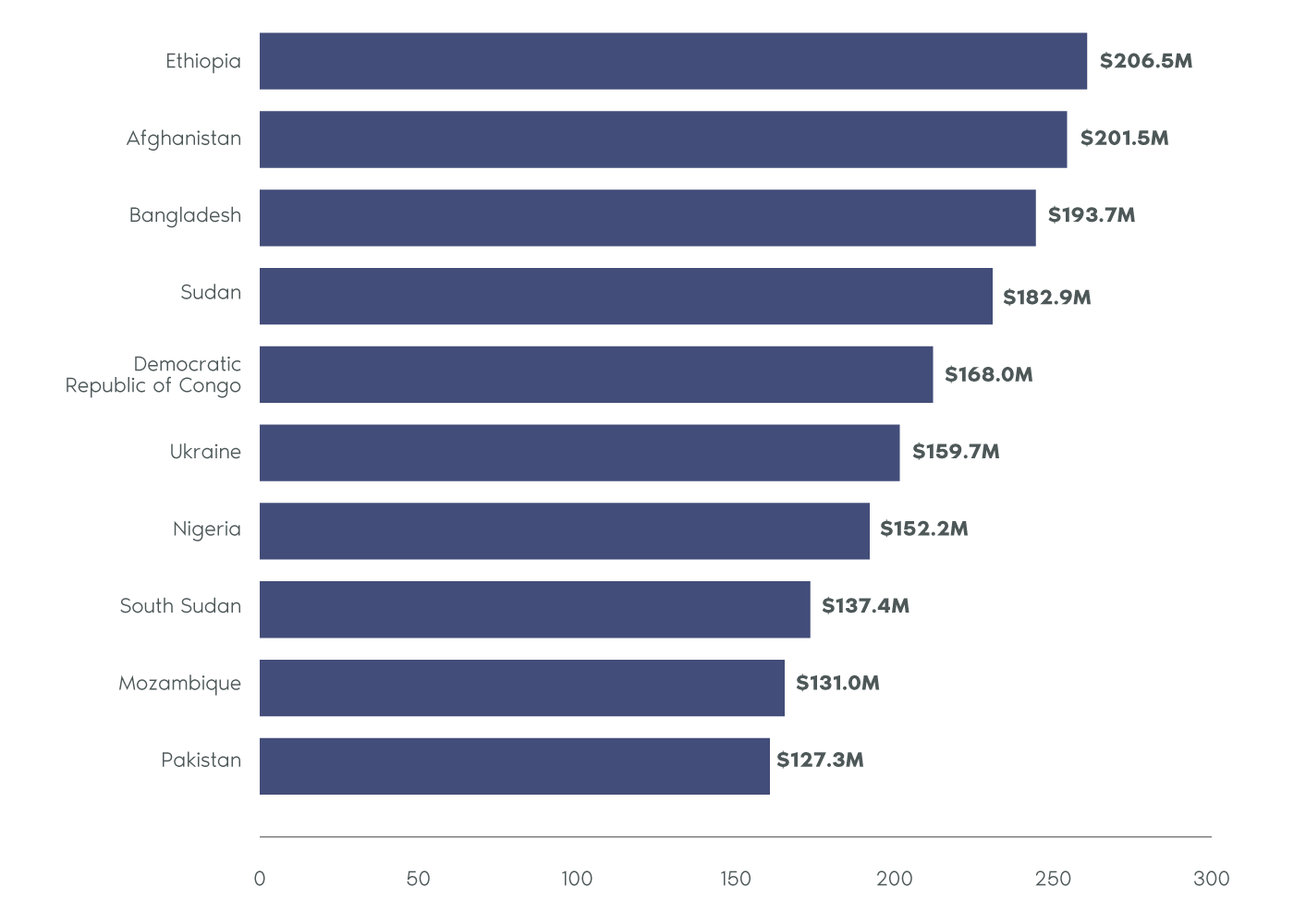
Text version
| Country | Total |
|---|---|
| 1 - Ethiopia | $206.5 million |
| 2 - Afghanistan | $201.5 million |
| 3 - Bangladesh | $193.7 million |
| 4 - Sudan | $182.9 million |
| 5 - Democratic Republic of Congo | $168.0 million |
| 6 - Ukraine | $159.7 million |
| 7 - Nigeria | $152.2 million |
| 8 - South Sudan | $137.4 million |
| 9 - Mozambique | $131.0 million |
| 10 - Pakistan | $127.3 million |
Federal disbursements by action area of the Feminist International Assistance Policy
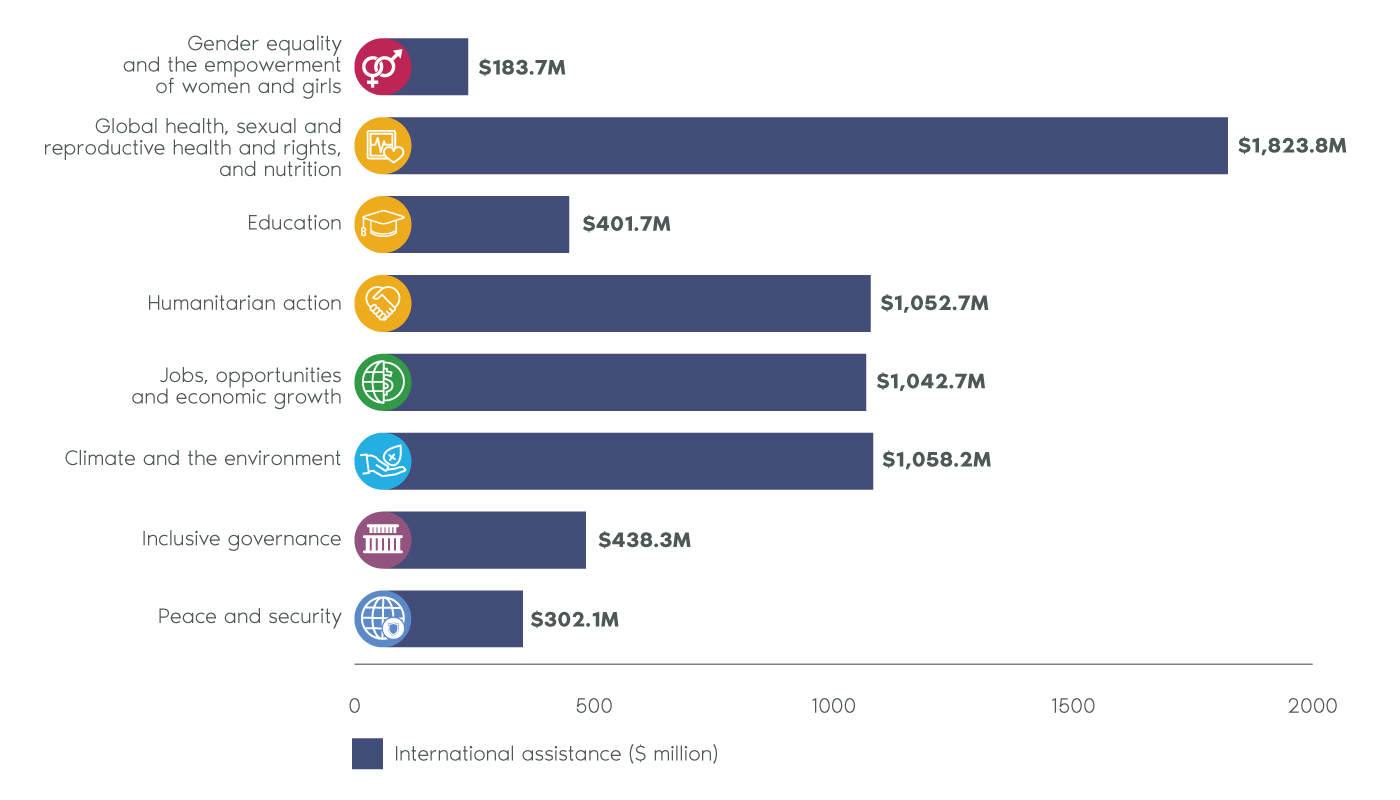
Text version
| Action area | International assistance |
|---|---|
| Gender equality and the empowerment of women and girls | $183.7 million |
| Global health, sexual and reproductive health and rights, and nutrition | $1,823.8 million |
| Education | $401.7 million |
| Humanitarian action | $1,052.7 million |
| Jobs, opportunities and economic growth | $1,042.7 million |
| Climate and environment | $1,058.2 million |
| Inclusive governance | $438.3 million |
| Peace and security | $302.1 million |
Government of Canada’s International Assistance and Official Development Assistance Disbursements by Organization, 2021–2022
The Government of Canada delivered international assistance through 19 federal organizations.
The Government of Canada disbursed $7.9 billion in international assistance in 2021-2022, of which official development assistance (ODA) made up 95% or $7.5 billion. The Statistical Report on International Assistance provides further details on international assistance and ODA expenditures.
Amount disbursed ($ million) by each of the 19 federal organizations:
| Department/Source | International assistance | of which | ||
|---|---|---|---|---|
| Programs funded by the IAE | ODA: ODAAA | ODA: OECD-DAC* | ||
| * OECD-DAC: Organization for Economic Co-operation and Development’s Development Assistance Committee. The “ODA: OECD-DAC” figures presented in this table are shown on a fiscal-year basis, in Canadian dollars, in order to compare and contrast reporting under the ODAAA versus the ODA reported to the OECD-DAC. When Canada reports to the OECD-DAC, figures are reported on a calendar-year basis in U.S. dollars. Their depiction in this table is for illustrative purposes only. The ODAAA reports on departments' gross disbursements, whereas the OECD-DAC reports on a grant equivalent basis. Reflows on repayable contributions and loans are disclosed in Table A as information items. | ||||
| **Includes costs of refugees in Canada (first year) and other projects. | ||||
| ***As part of Canada’s commitment to donate the equivalent of 200 million doses of COVID-19 vaccines, surplus doses are donated to developing countries and reported based on the OECD-DAC recommended valuation of US$6.72 for calendar year 2021 and US$6.66 for calendar year 2022. This recommended valuation does not reflect vaccine purchase price. | ||||
| ****Figures in this table are represented in millions, and as such contributions by Transport Canada display as 0. Their 2021-2022 contributions totalled $2,000. | ||||
| Departments reporting under the Official Development Assistance Accountability Act (ODAAA) | ||||
| Global Affairs Canada | 5,954.03 | 5,909.08 | 5,769.11 | 5,769.11 |
| Department of Finance Canada | 1,107.87 | 1,107.87 | 905.87 | 905.87 |
| Immigration, Refugees and Citizenship Canada** | 457.45 | - | 457.45 | 457.45 |
| International Development Research Centre | 141.34 | 141.34 | 141.34 | 141.34 |
| Public Health Agency of Canada—Vaccine donations*** | 130.03 | - | 130.03 | 130.03 |
| Environment and Climate Change Canada | 18.41 | 11.92 | 17.27 | 17.27 |
| Royal Canadian Mounted Police | 20.23 | 20.23 | 20.11 | 20.11 |
| Canada Revenue Agency | 7.06 | 5.18 | 7.06 | 7.06 |
| Department of National Defence | 6.01 | - | 6.01 | 6.01 |
| Employment and Social Development Canada— Labour Program | 6.78 | - | 6.78 | 6.78 |
| Parks Canada | 5.20 | - | 5.20 | 5.20 |
| Natural Resources Canada | 1.42 | 1.42 | 1.42 | 1.42 |
| Innovation, Science and Economic Development Canada | 0.92 | - | 0.92 | 0.92 |
| Canada Post—Universal Postal Union | 0.32 | - | 0.32 | 0.32 |
| Statistics Canada | 0.17 | - | 0.17 | 0.17 |
| Canadian Space Agency | 0.05 | - | 0.05 | 0.05 |
| Canadian Intellectual Property Office | 0.03 | - | 0.03 | 0.03 |
| Canadian Museum of Nature | 0.02 | - | 0.02 | 0.02 |
| Transport Canada**** | 0.00 | - | 0.00 | 0.00 |
| Services received without charge by Global Affairs Canada | 25.00 | 10.55 | 25.00 | 25.00 |
Subtotal—Departments reporting under the ODAAA | 7,882.34 | 7,207.6 | 7,494.16 | 7,494.16 |
| Percentage of international assistance | 91% | 95% | 95% | |
| Other departments, sources | ||||
| Cost of refugees in Canada (first year) —Provincial governments | 459.54 | - | - | 459.54 |
| Provinces, territories and municipalities | 56.54 | - | - | 56.54 |
Subtotal—Other departments, sources | 516.08 | - | - | 516.08 |
Total | 8,398.42 | 7,207.6 | 7,494.16 | 8,010.24 |
| Percentage of total international assistance | 86% | 89% | 95% | |
2030 Agenda and the SDGs
The 2030 Agenda for Sustainable Development provides a global framework for transforming the world we live in. It sets out concrete steps toward progress on sustainable development for:
- governments
- civil society
- the private sector
- academia
- communities
- individuals
The 2030 Agenda outlines 17 interconnected and indivisible Sustainable Development Goals (SDGs) that have accompanying targets and indicators. These goals balance the 3 elements of sustainable development:
- economic
- social
- environmental
Canada is working toward integrating the SDGs into all elements of its operations, including foreign policy, trade and international assistance. Moving Forward Together: Canada’s 2030 Agenda National Strategy outlines a whole-of-government and whole-of-society approach that guides Canada’s implementation of these goals. The Federal Implementation Plan articulates how Canada will achieve the objectives outlined in this strategy, while the Canadian Indicator Framework and the 2022 to 2026 Federal Sustainable Development Strategy add uniquely Canadian goals, ambitions, targets and indicators.
Prime Minister Trudeau’s role as co-chair of the UN Secretary General’s SDG Advocates (the other co-chair being the Prime Minister of Barbados Mia Mottley), gives Canada an opportunity to bring renewed focus on the SDGs going forward. In this position, the Prime Minister will work alongside the 17 SDG advocates identified by the UN Secretary General to inspire global leaders to work toward achieving the goals. This is particularly crucial during this Decade of Action (2021-2030) and at a time when the COVID-19 pandemic has created significant challenges for all aspects of sustainable development.
Sustainable Development Goals
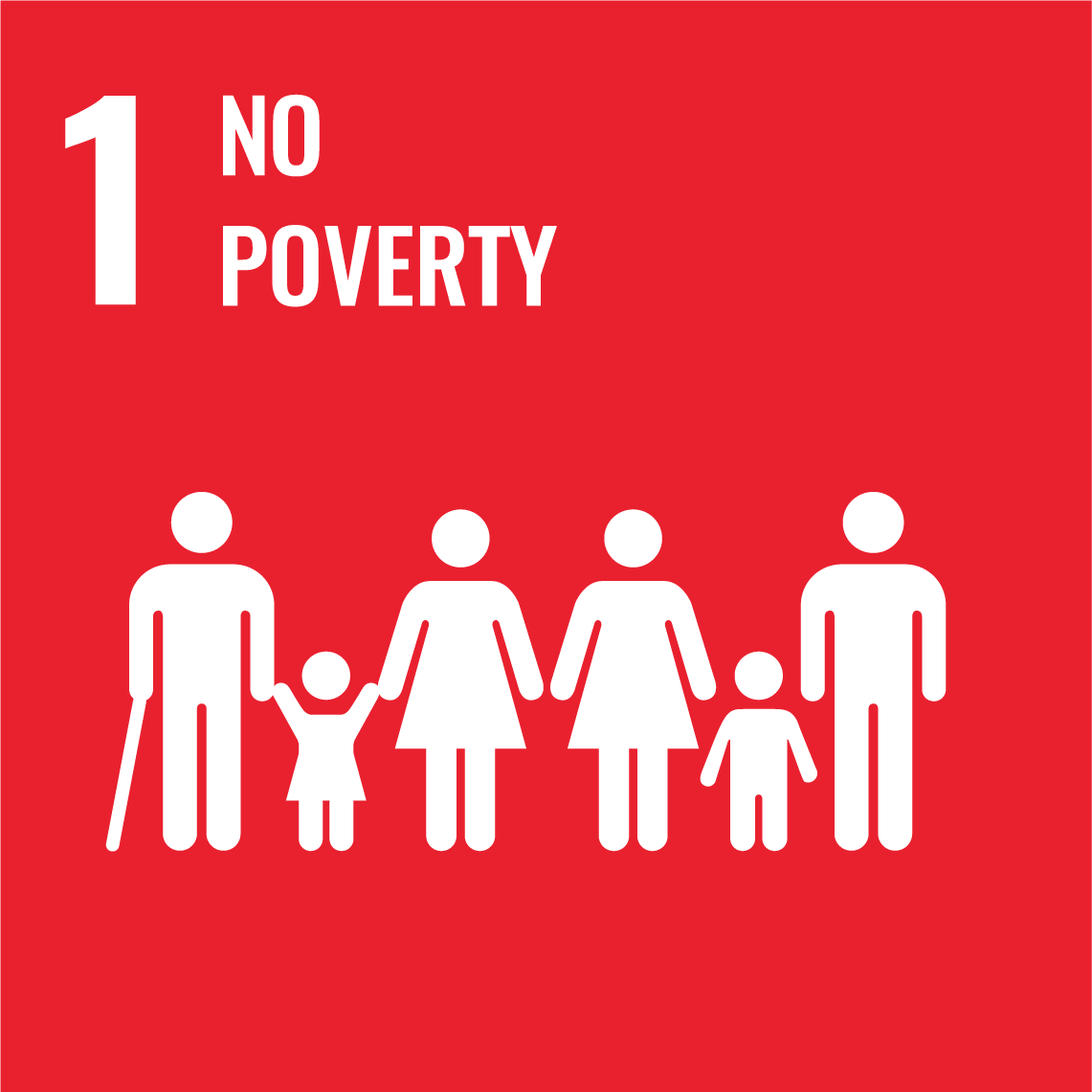
No poverty
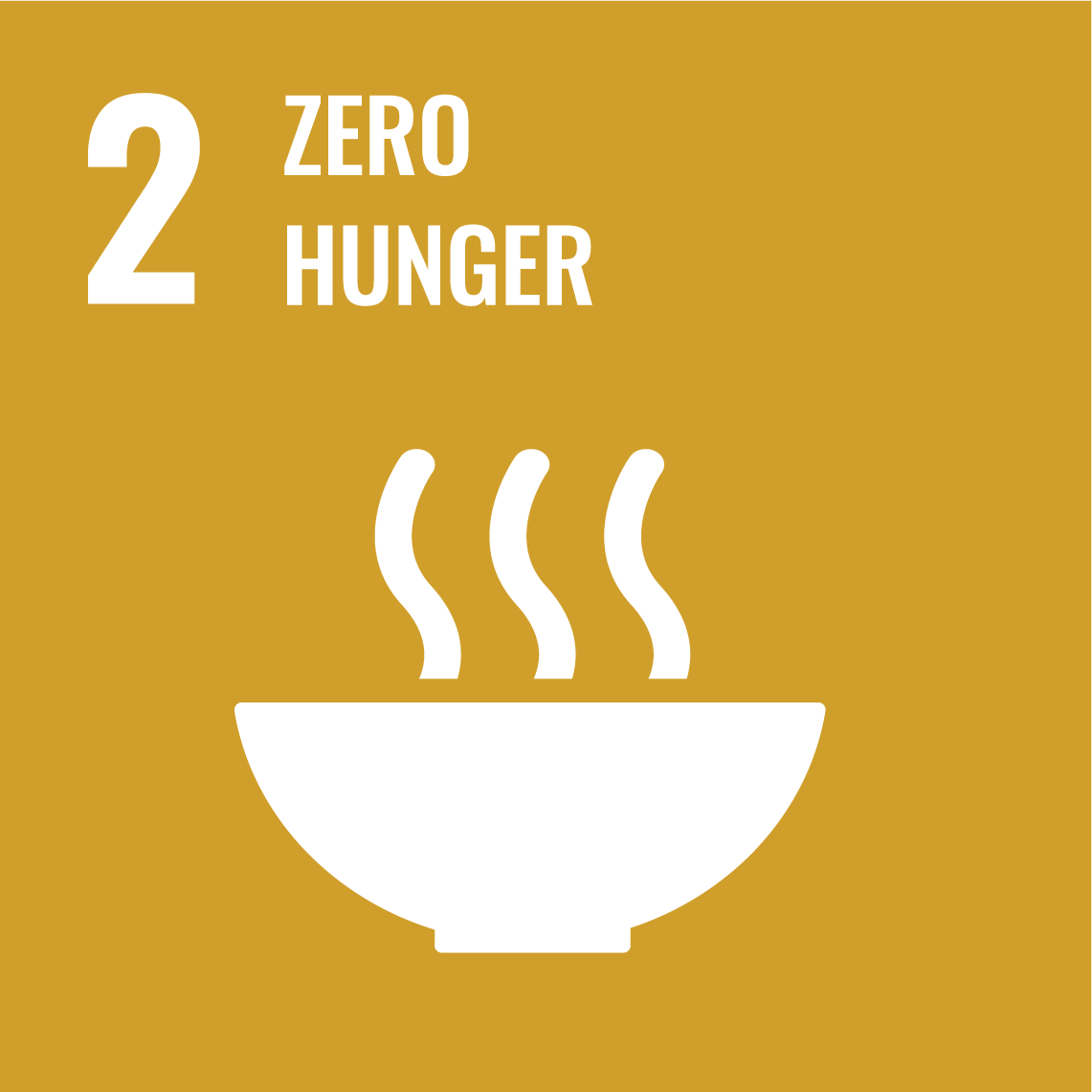
Zero hunger
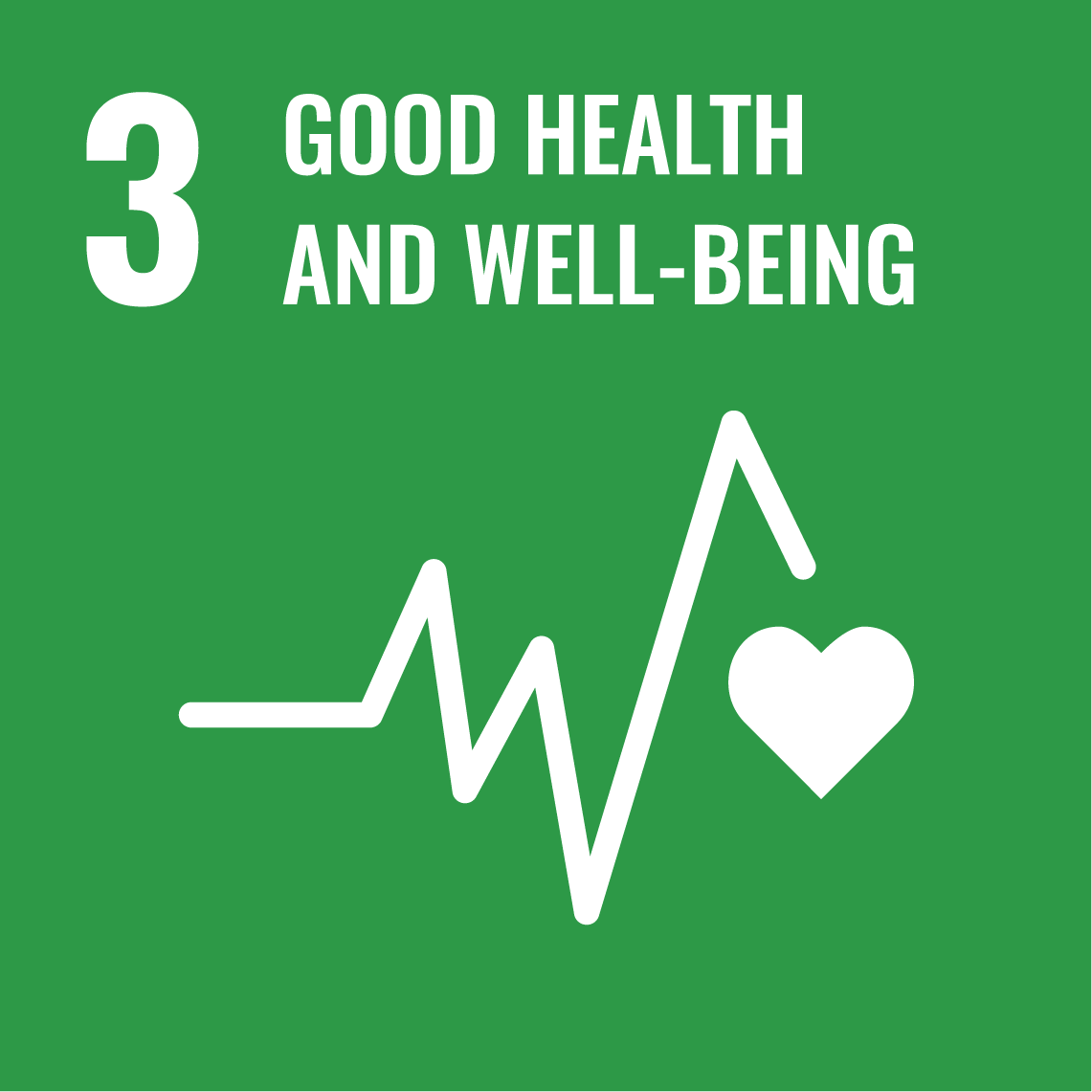
Good health and well-being
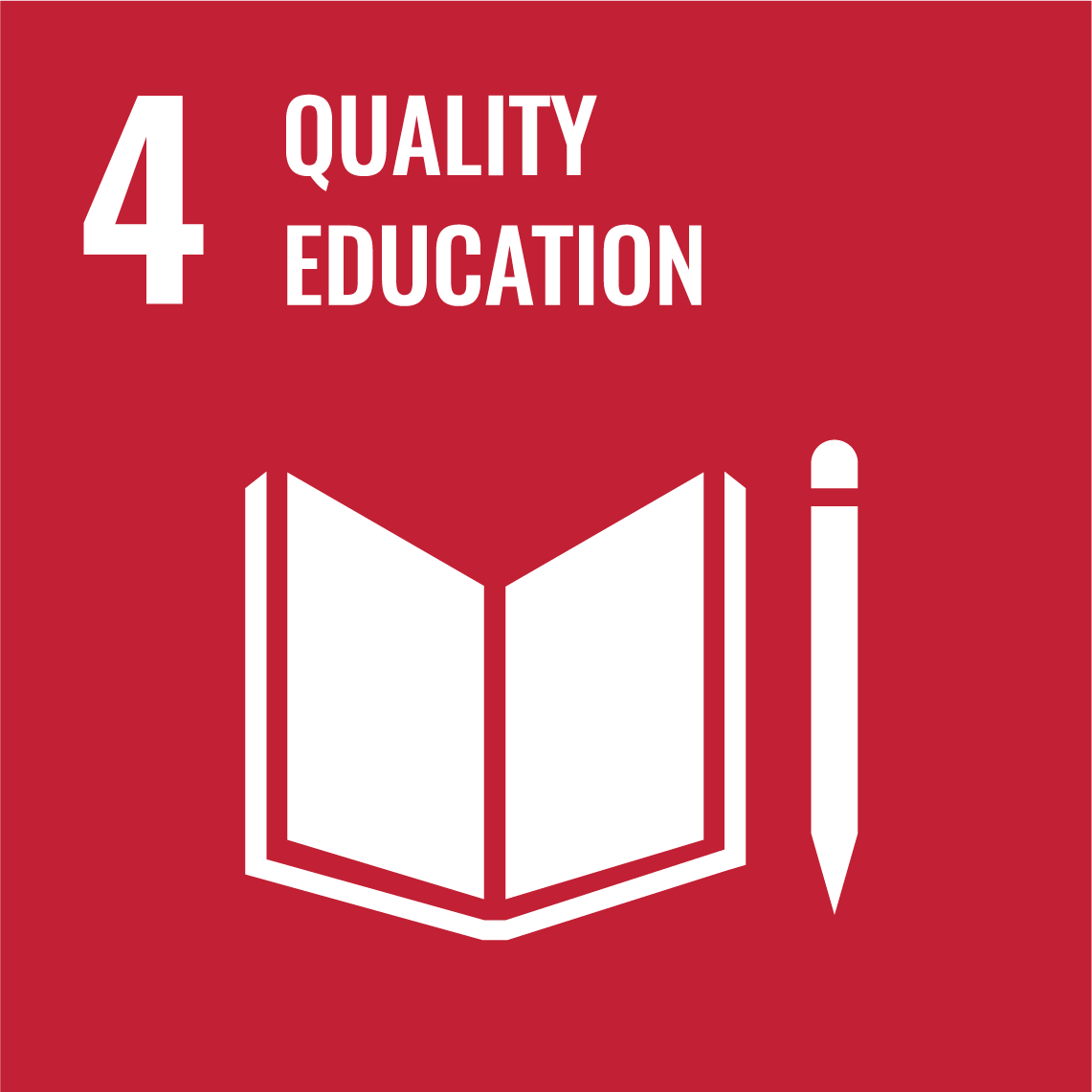
Quality education
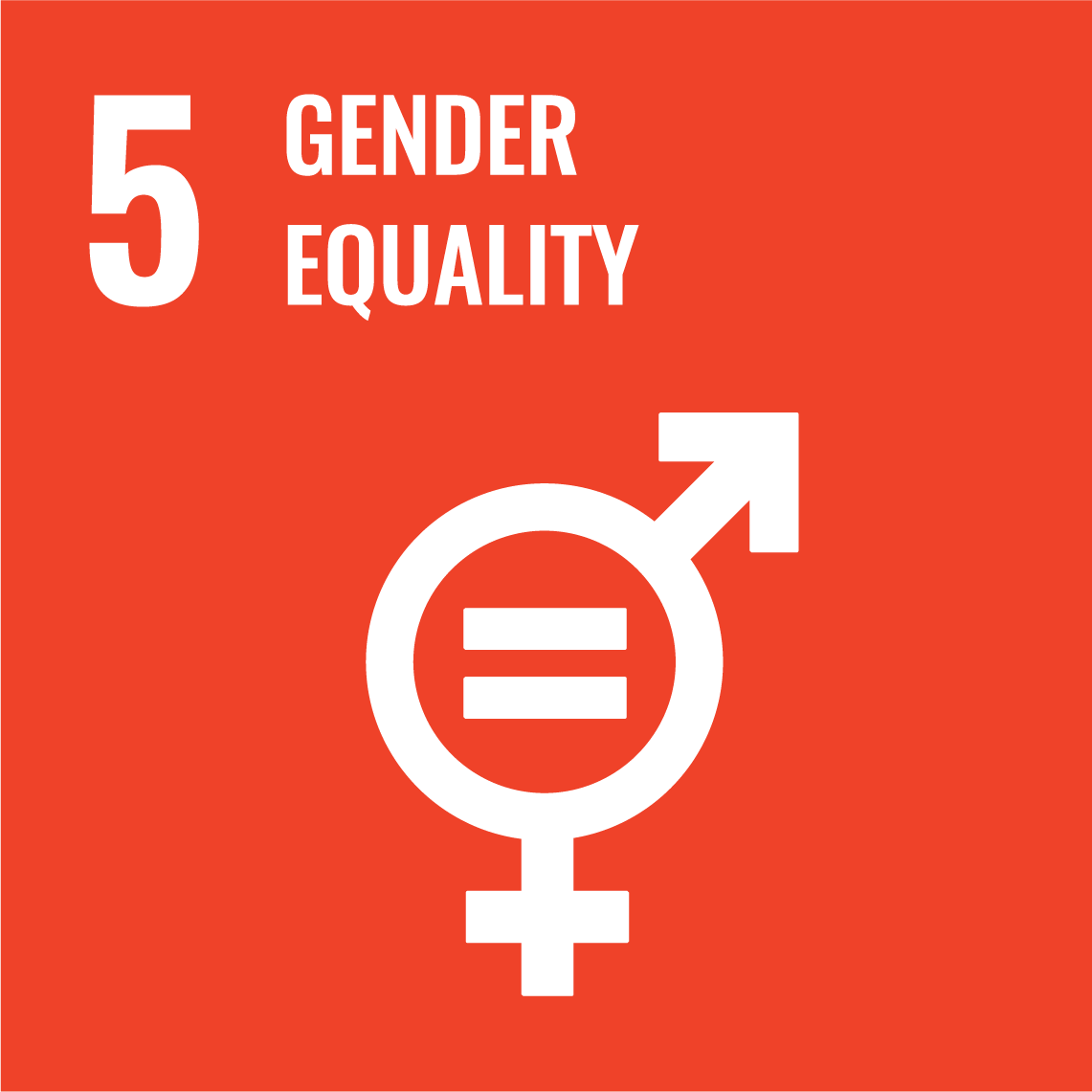
Gender equality
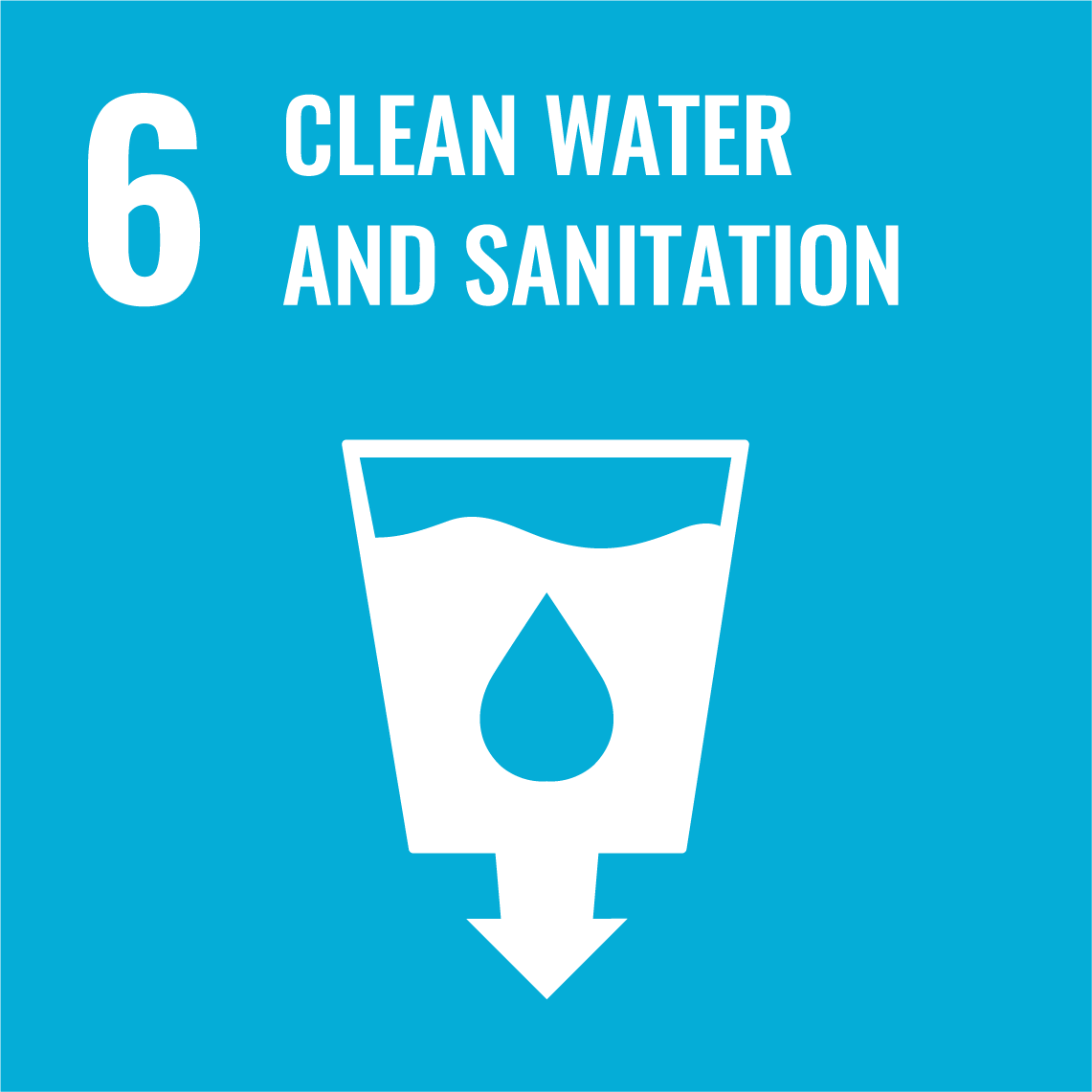
Clean water and sanitation
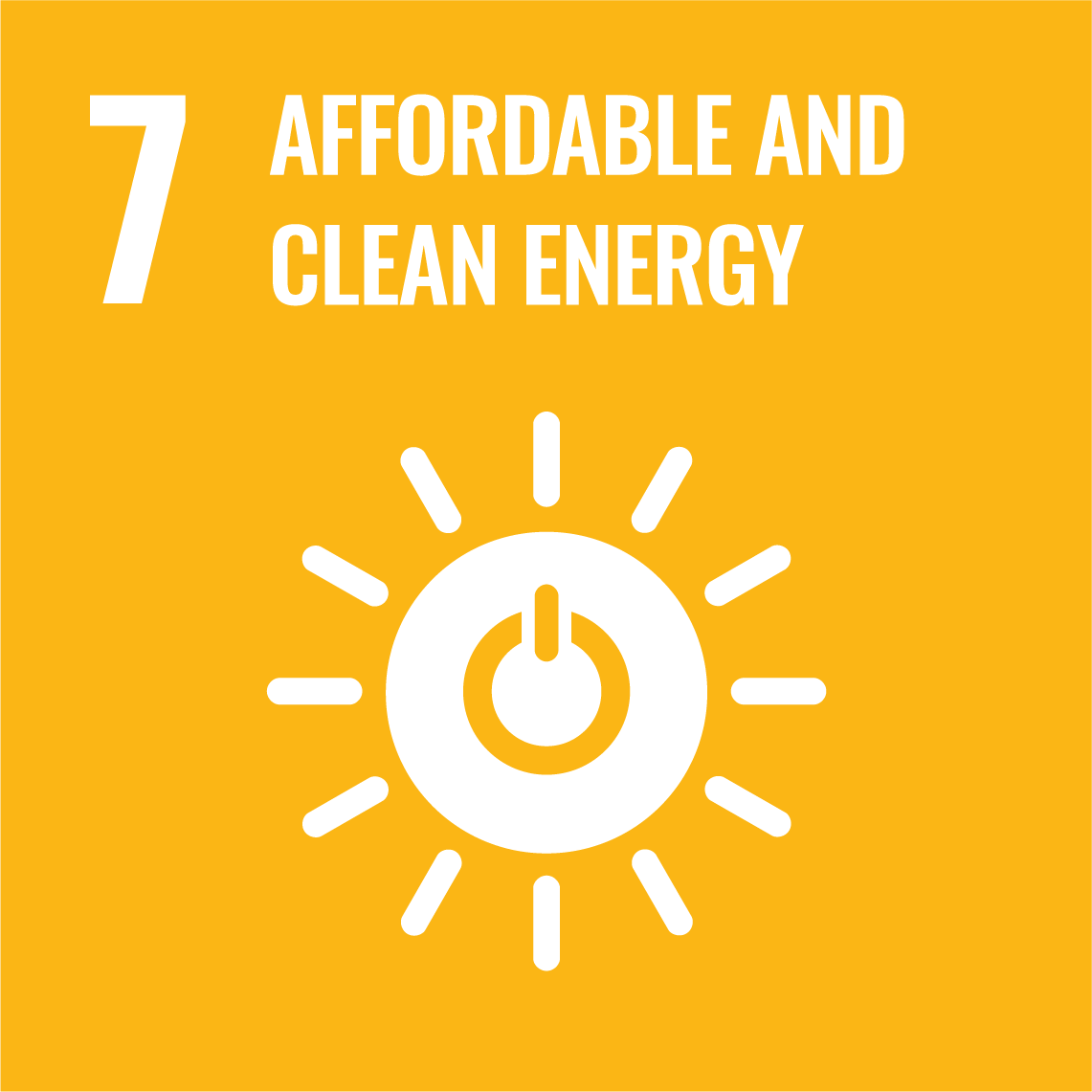
Affordable and clean energy
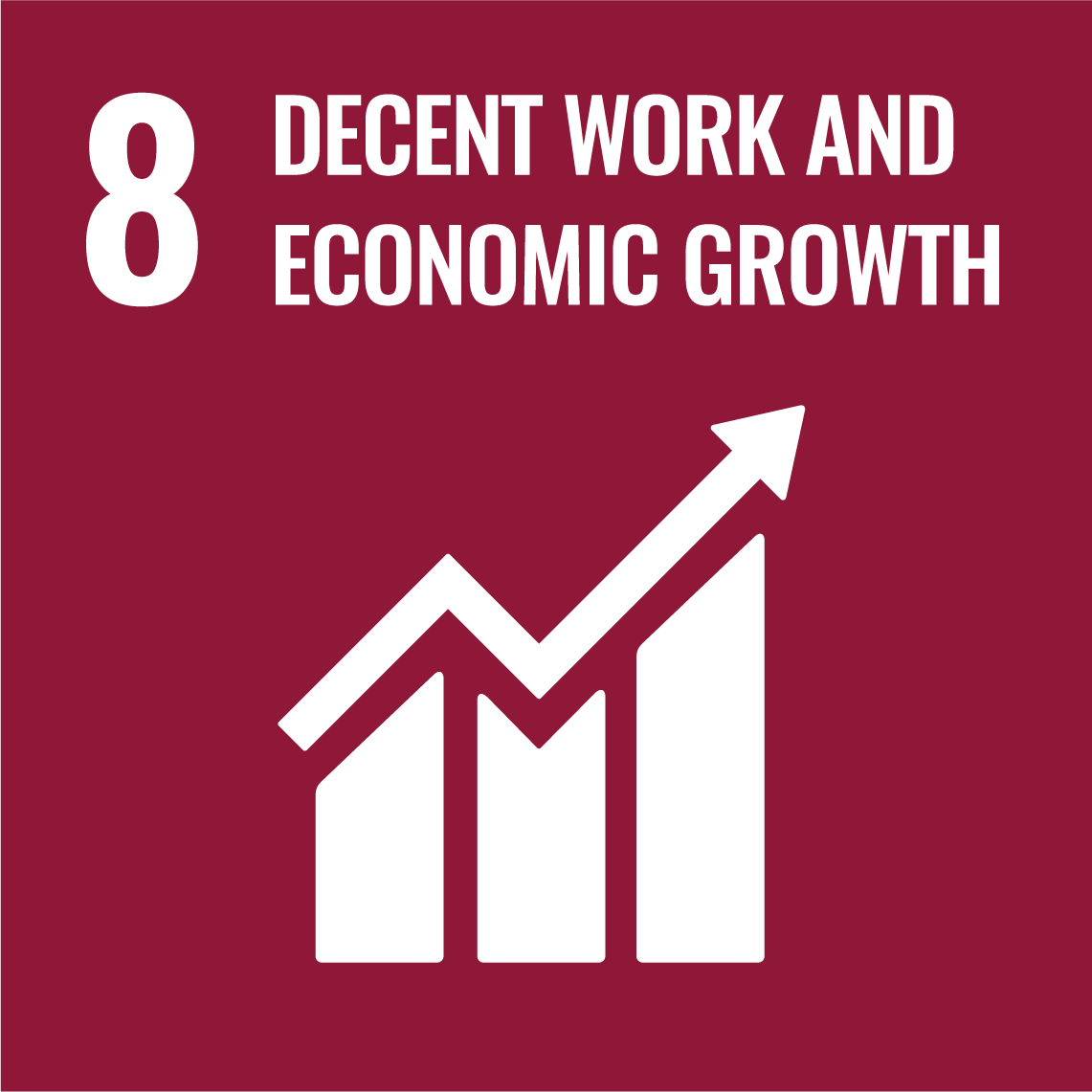
Decent work and economic growth
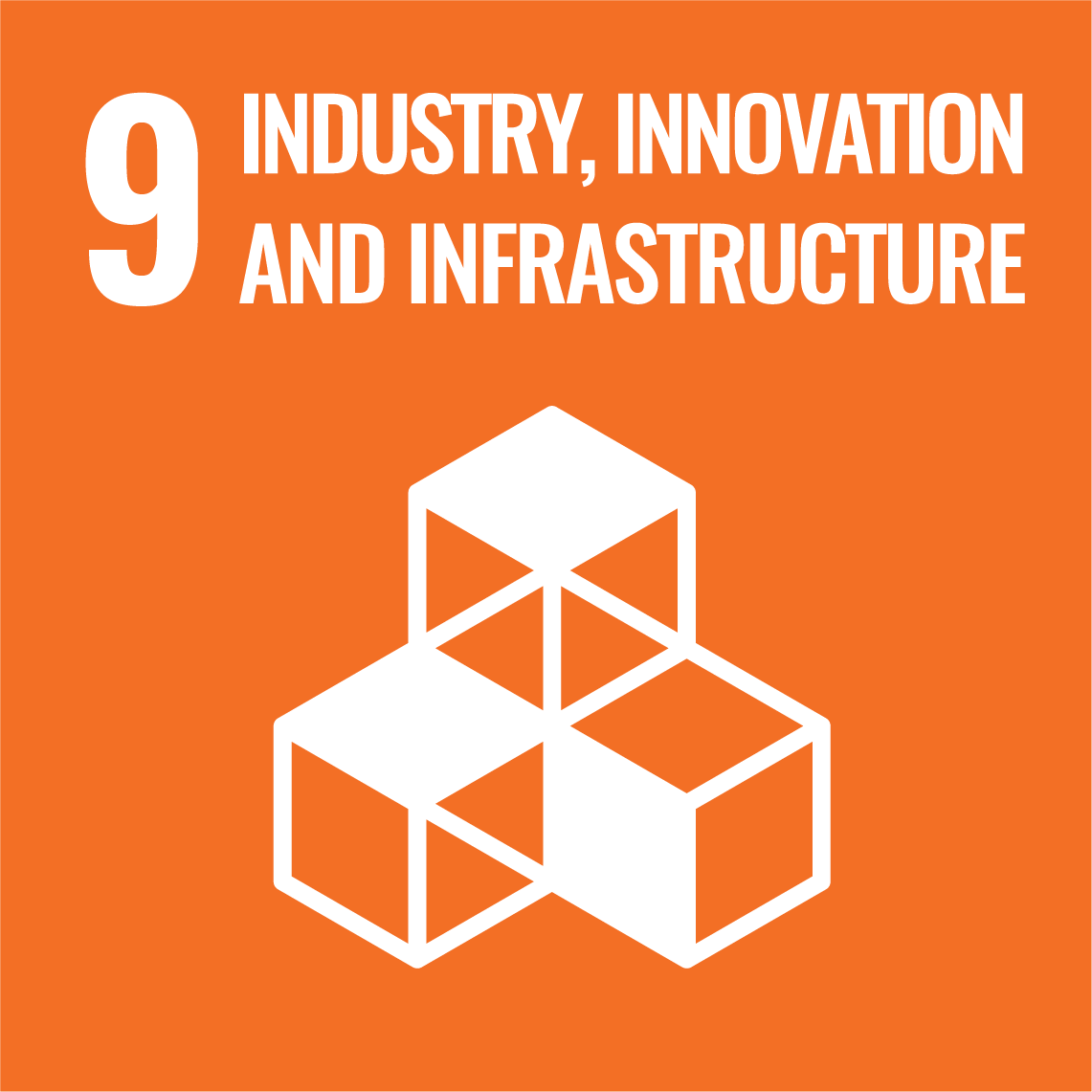
Industry, innovation and infrastructure
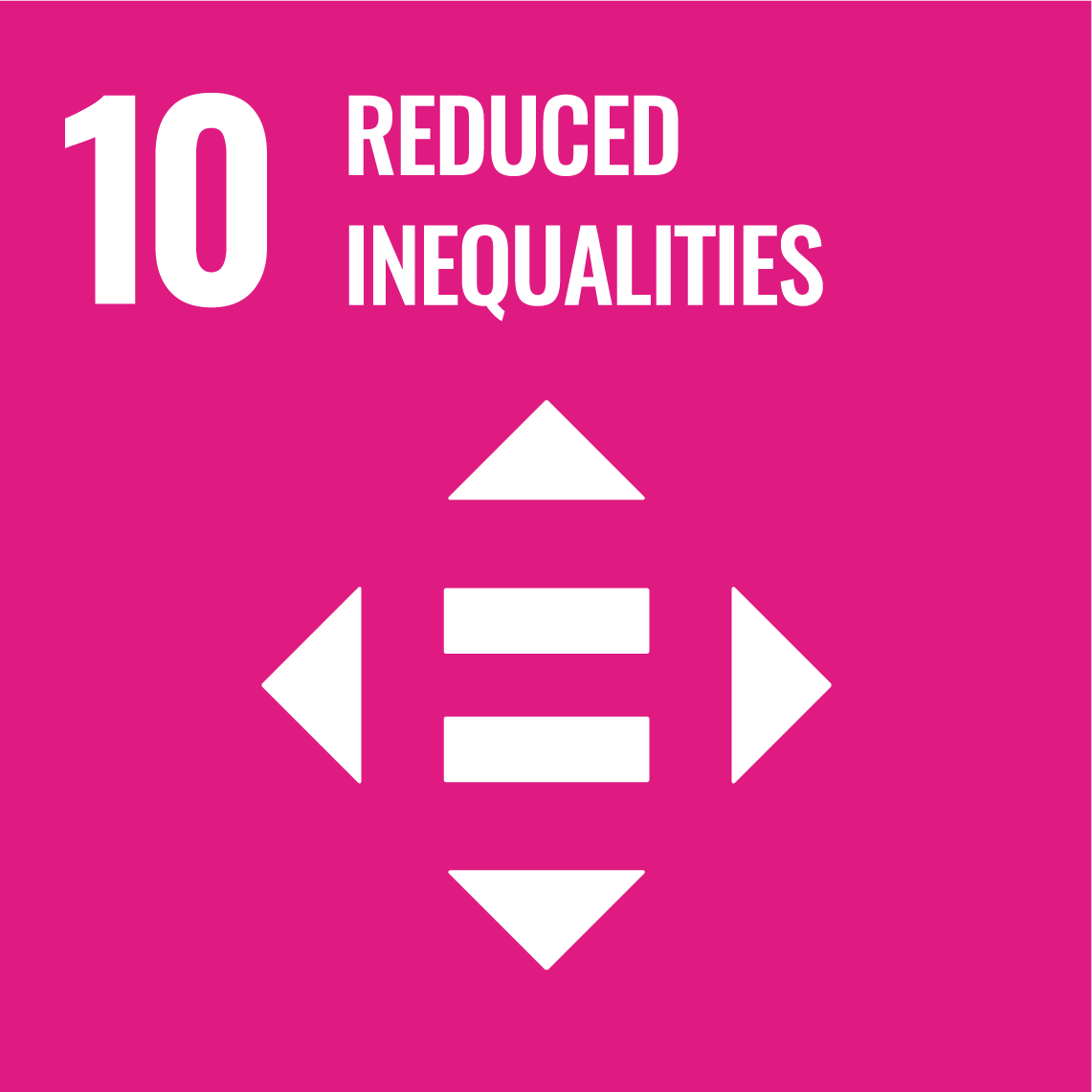
Reduced inequalities
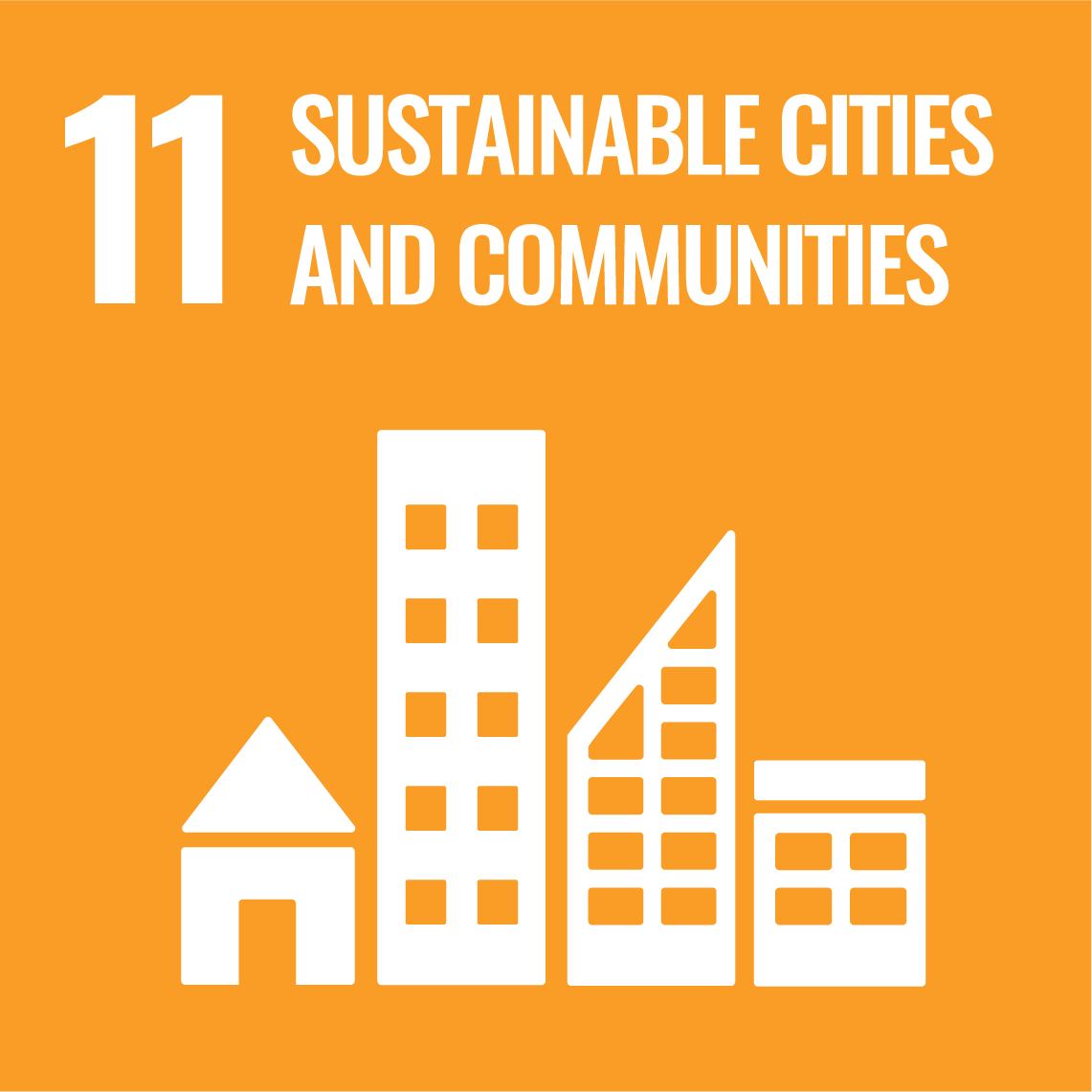
Sustainable cities and communities
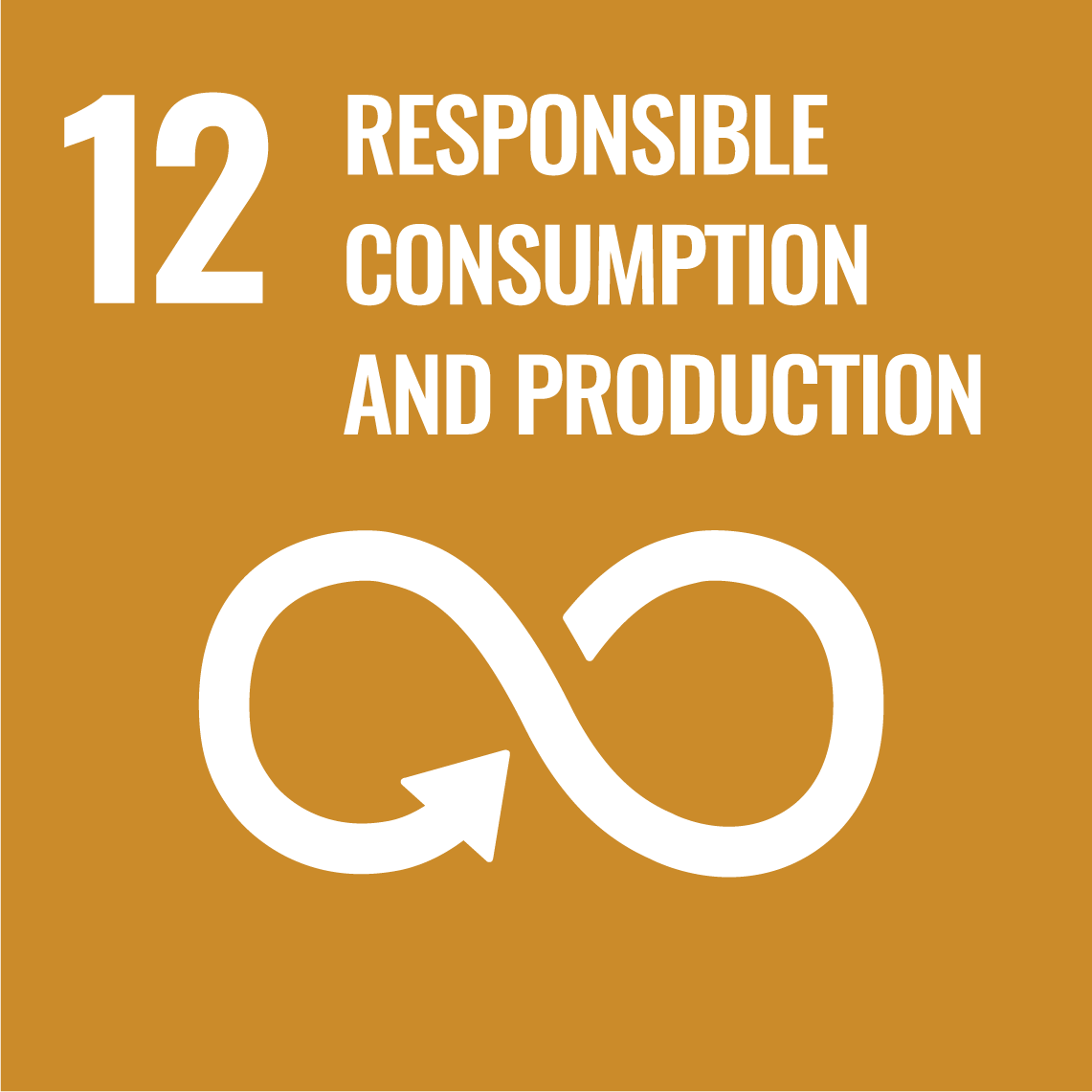
Responsible consumption and production
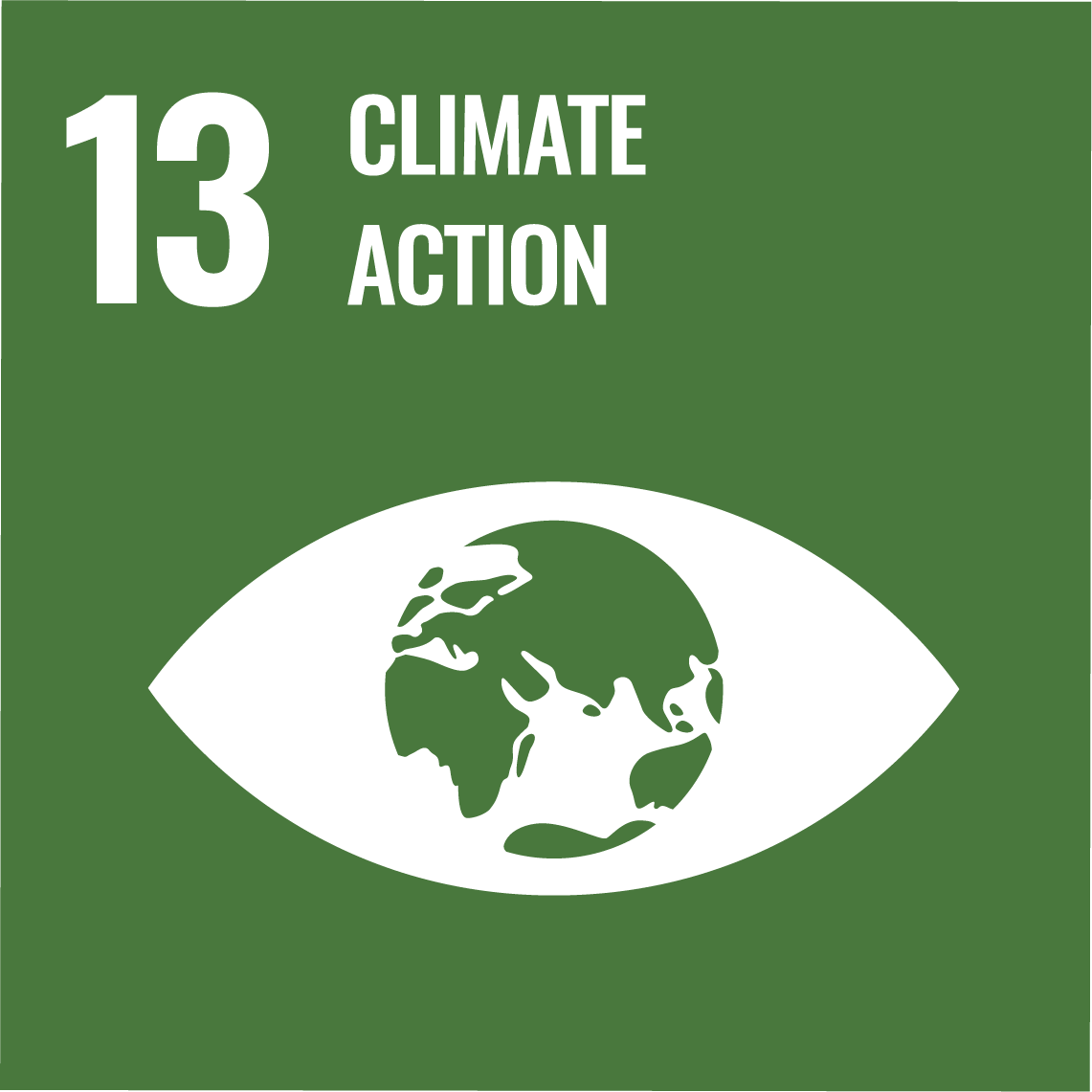
Climate action
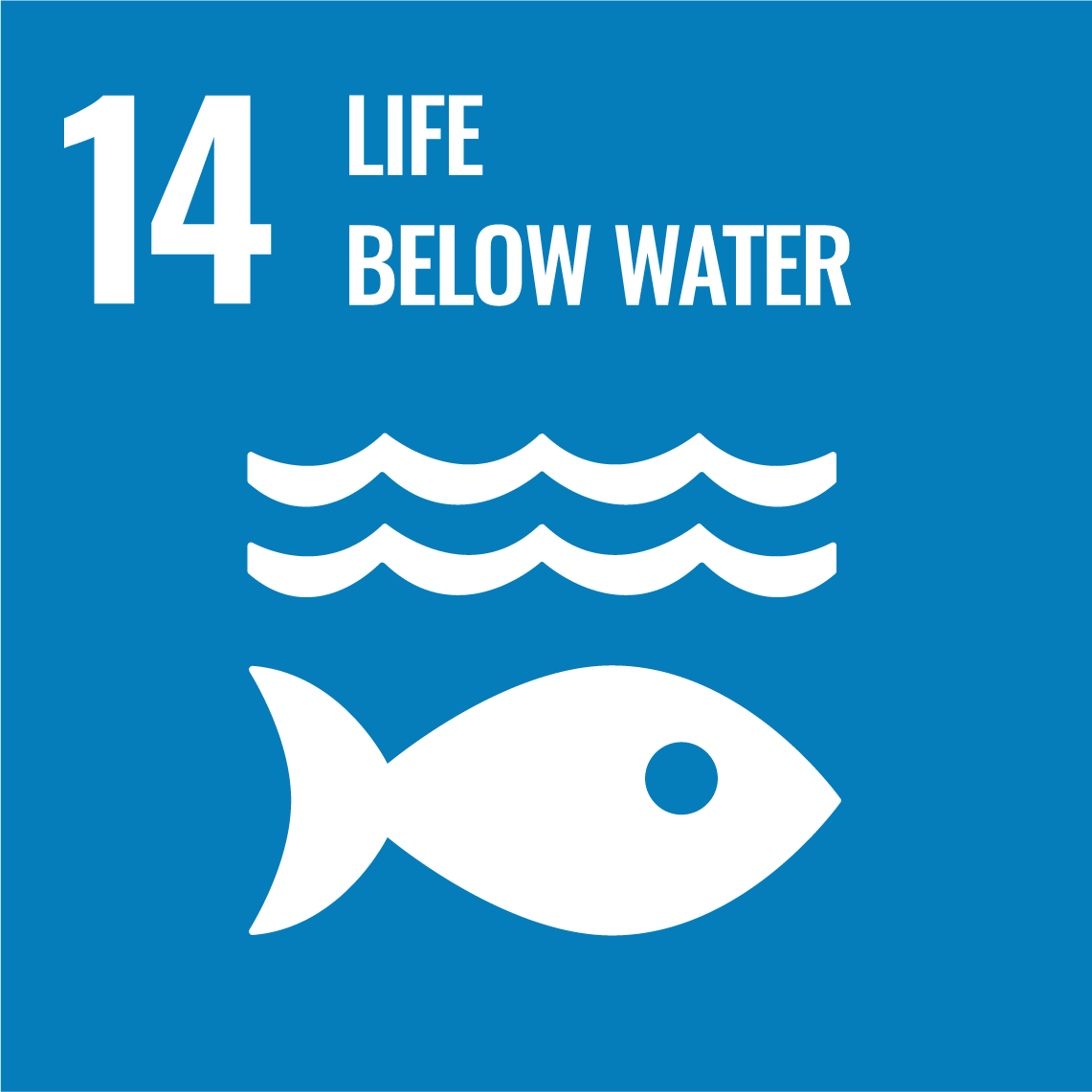
Life below water
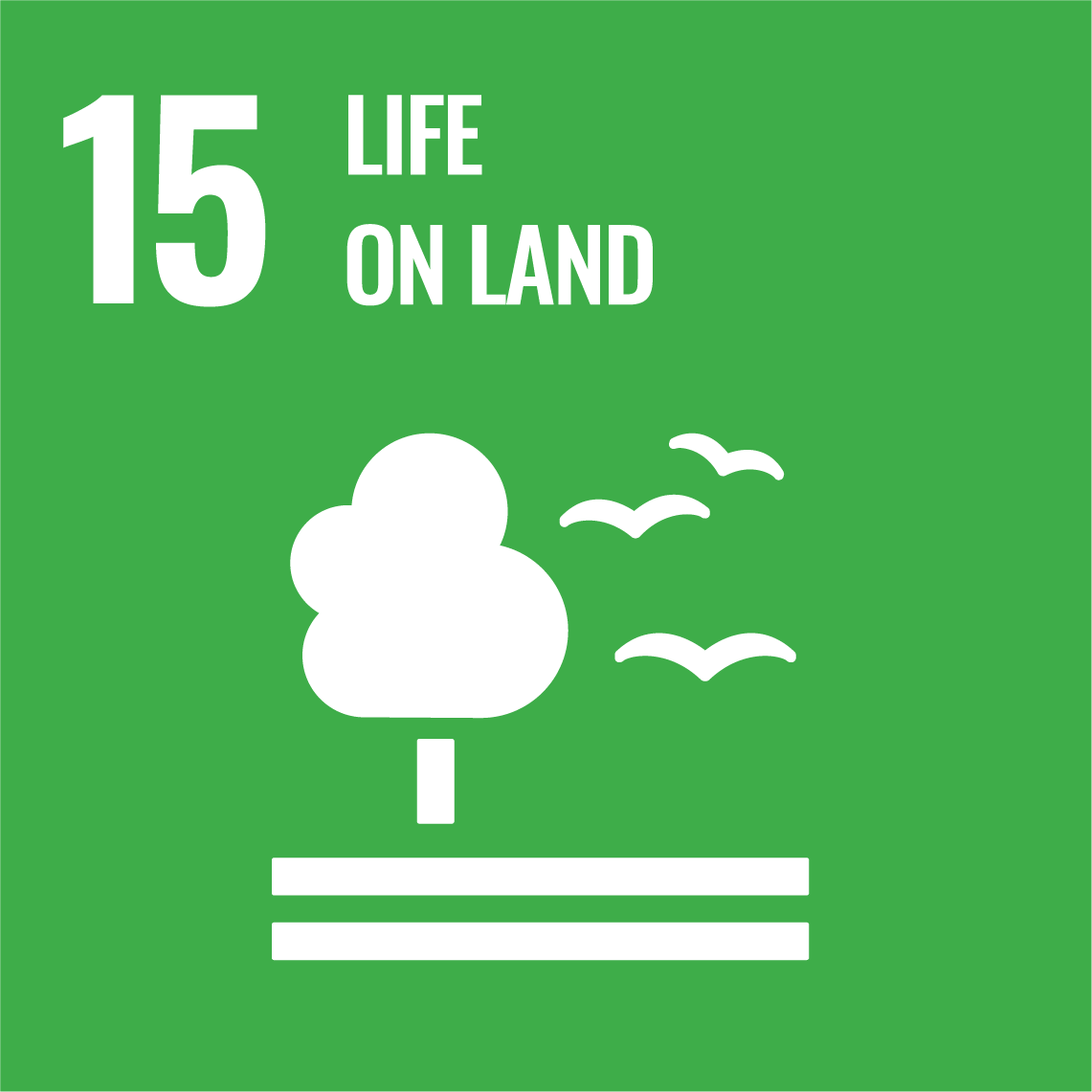
Life on land
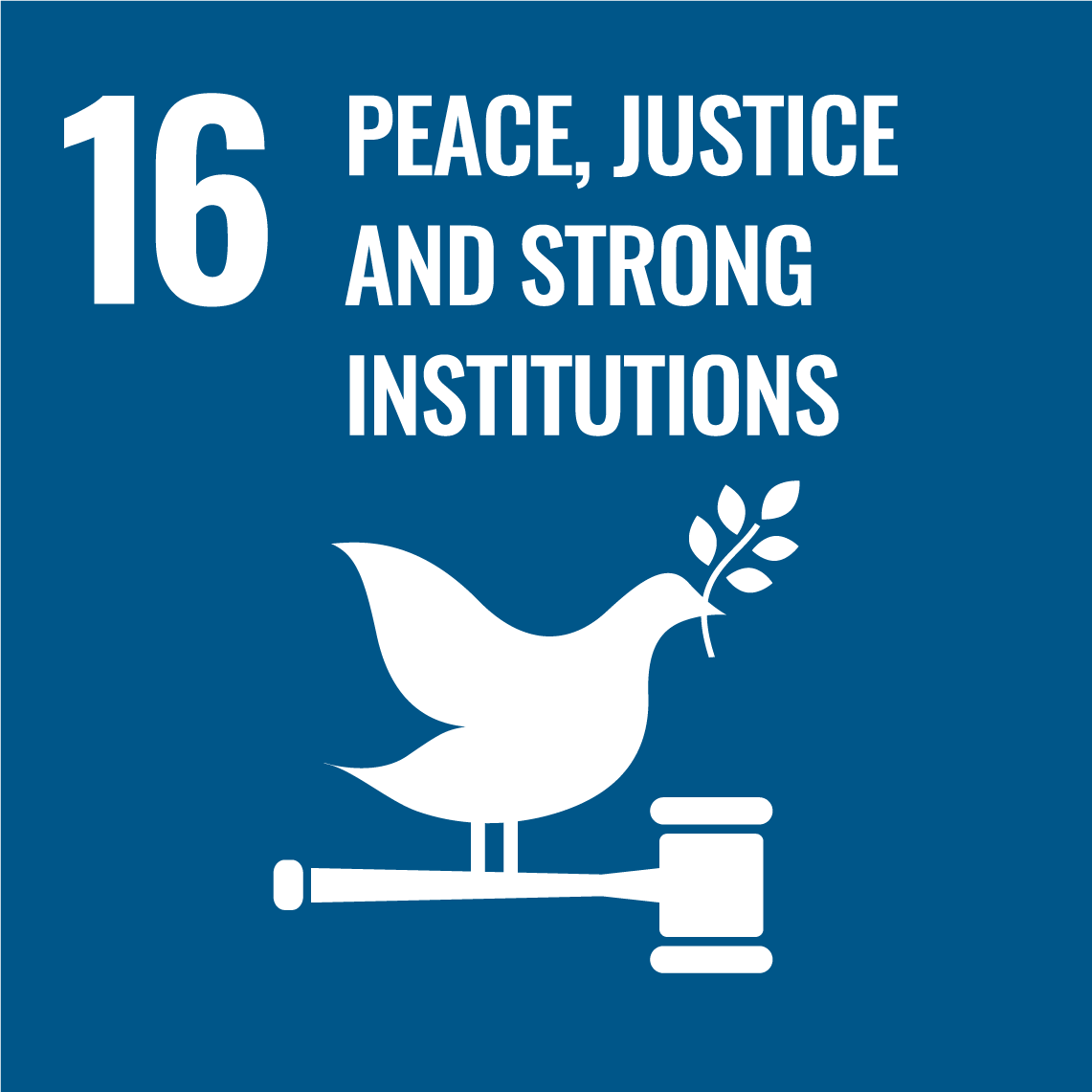
Peace, justice and strong institutions

Partnerships for the goals
© Vancouver International Airport
Meeting the moment: Canada’s leadership in times of crisis
Canada has adopted the Humanitarian-Development-Peace Nexus (Triple Nexus) approach as a way to deliver its international assistance. This approach enables Canada to more effectively meet peoples’ needs, mitigate risks and vulnerabilities, and move toward sustainable peace. It focuses on linking three pillars of Canada’s international assistance:
- humanitarian
- development
- peace
The concept, which was first introduced as part of the United Nations’ New Way of Working in 2016, has since evolved. Today, it provides a holistic understanding of conflict and fragility that points to the need for cross-pillar coordination and coherence—before, during and in the aftermath of crises.
Canada’s Triple Nexus approach: Humanitarian, Development and Peace
By addressing vulnerability at all stages of crises, Canada’s Triple Nexus approach is helping to build resilience to the complex challenges facing the world today, such as poverty, violence and environmental degradation. It focuses on forging effective partnerships among multilateral and regional organizations, as well as with international financial institutions like the World Bank. This creates shared outcomes in fragile and conflict-affected states, while considering different actors’ comparative advantages and capacity to deliver support.
In 2019, Canada joined the other members from the Organization for Economic Co-operation and Development’s Development Assistance Committee (OECD-DAC), along with 6 UN agencies, in pledging support to the OECD-DAC Recommendation on the Humanitarian-Development-Peace Nexus. It promotes the coordination of both programming and financing in fragile and conflict-affected settings.
Key commitments
In 2021-2022, Canada remained committed to the Triple Nexus approach. This helped build enhanced strategic, operational and functional capabilities in its international assistance programming and supported more coherent and effective policies and programming. Key financial commitments included:
- providing $115.4 million over 2 years to respond to the mass displacement of Venezuelans, including funding for projects tackling education, health, regularization, employment, security, border management and protection
- providing $20 million over 3 years to support the Canadian Foodgrains Bank in addressing the humanitarian and development impacts of COVID-related food insecurity in 8 countries: Pakistan, the Democratic Republic of Congo, Kenya, Madagascar, Nigeria, South Sudan, Burundi and Zimbabwe
- contributing $10 million to the UN Peacebuilding Fund to enable the Humanitarian Development Peace and Partnership Facility to deliver grants to crisis-affected settings
- allocating $10 million to the UN Peacebuilding Fund to address urgent peacebuilding needs in fragile and conflict-affected states through fast and flexible initiatives that address gender and youth inclusion
Stories of change
From conflict to economic opportunity
Through the Landmine Action in Colombia project, the Canadian-funded HALO Trust has helped communities conduct landmine surveys and clearance.
Learn more about this theme
Conflict prevention and peacebuilding
Over the past decade, violent conflict has increased around the globe. Preventing these conflicts and building sustainable peace is essential to achieving the UN’s SDGs. Although boosting economies and alleviating poverty are also critical to fulfilling the SDGs, this is not enough on its own to build lasting peace.
The 2030 Agenda highlights that there can be no sustainable development without peace, and no peace without sustainable development. This is reflected in SDG 16, which aims to promote peace, inclusive governance and justice for all.
Key commitments
Canada works with diverse local, regional, national and global partners, including civil society, to support local and national capacities for peacebuilding. Facilitating the meaningful participation of women and girls in these efforts is central to building long-term sustainable peace.
Canada is committed to addressing the drivers of conflict through gender-responsive, sensitive and integrated approaches. At the same time, it remains focused on ensuring coherent and coordinated engagement between humanitarian, development, peace and security partners. By promoting political inclusion, security, justice and respect for human rights, Canada has helped address group grievances and inequalities in situations of rising tensions, violent conflict and transitions to peace and stability.
In 2021-2022, Canada committed international assistance to support conflict prevention and peacebuilding, which included:
- targeted funding for grassroots women’s organizations, including $5 million in dedicated funding to support grassroots women peacebuilders and women in the Canadian Forces
- providing $138.9 million in international assistance to promote peace and stability in fragile and conflict-affected states, including country-specific initiatives in countries such as Cameroon, Colombia, Burkina Faso, Haiti, Iraq, Mali, Myanmar, South Sudan and Ukraine
Results in focus
As of January 2022, Canada was the eighth-largest donor in assessed contributions to the UN’s peacekeeping budget. In addition, it was one of the largest donors in voluntary funding to help improve and reform UN peace operations. This includes support for medical training, leadership development, French-language resources and gender expertise.
In 2021-2022, Canada’s other contributions to conflict prevention and peacebuilding enabled the following results:
- Training 8,473 military, police and civilian personnel (including 1,214 women) in peacekeeping competencies, which incorporated gender equality, and addressing sexual and gender-based violence as well as sexual exploitation and abuse
- Conducting a rapid needs assessment, convening experts and funding urgent programming in response to the conflict in the Tigray region of Ethiopia, including rapid funding for a joint Office of the High Commissioner for Human Rights and the Ethiopian Human Rights Commission report on human rights violations
- Deploying gender justice experts to investigate and document crimes of sexual and gender-based violence in conflict areas, such as Iraq, the Democratic Republic of Congo and Yemen, and to help bring perpetrators to justice
Key initiatives in the spotlight
Recognizing women’s role in peacebuilding
In February 2022, Canada held the inaugural Women, Peace and Security (WPS) awards ceremony. The WPS Awards Program was launched in 2020 to mark the 20th anniversary of UN Security Council Resolution 1325, the foundation of the WPS agenda.
The program has 2 components:
- A Civil Society Leadership Award, managed by Global Affairs Canada
- A Research Award, managed by the International Development Research Centre (IDRC)
The 2021 awards ceremony was hosted by Minister Joly and moderated by Canada’s Ambassador of Women, Peace and Security Jacqueline O’Neill. It brought together more than 120 participants from different regions and sectors. Under the theme of “Women Peacebuilders,” the Civil Society Leadership Award was given to two Indigenous women’s organizations: Tejido Mujer and Pauktuutit Inuit Women of Canada. Pauktuutit Inuit Women of Canada was recognized for its significant contributions in promoting and protecting the human rights and safety of Inuit women and girls in Canada. Colombia’s Tejido Mujer was recognized for its work supporting Indigenous women’s participation in decision-making processes, countering gender-based violence and providing consistent peaceful resistance to armed conflict in Colombia’s Cauca region.
The research award managed by the IDRC advances knowledge on women’s contributions to conflict prevention, conflict resolution and peacebuilding processes. The first award winners were researcher Marsin Alshamary, whose work focused on Iraqi women’s leadership in formal politics and in civil society, and two researchers, Hafsa Afailal and Muzna Dureid, who shared an award for their work on the digital security of women human-rights defenders, activists and peacebuilders in Syria and Yemen.
Preventing the spread of hatred
In Mali, the Canada-funded Search for Common Ground project reinforced community resilience against disinformation in the northern and central regions as a way to improve security and reduce the risk of conflict. In 2021-2022, the project organized 14 community forums that brought together approximately 750 people, including community leaders and local authorities. Participants discussed disinformation and how it contributes to inter-community conflicts, extremism and the erosion of social cohesion. These forums helped increase the capacity of youth, women and local authorities to engage in positive and conflict-sensitive communication to enhance peace and stability in Mali.
Building peace through reconciliation
In 2021-2022, Canada supported 66 peace and security projects through the Canada Fund for Local Initiatives program. In South Sudan, the program worked with the local NGO Voice Post to make use of Indigenous knowledge to prevent ethnic conflicts and to advocate for peace and reconciliation. This project brought together a broad range of community stakeholders to discuss how to prevent conflict and promote peace. These discussions informed peace and reconciliation messages shared by youth ambassadors in local villages as well as at 3 peace concerts.
Building counter-terrorism and anti-crime capacity
In 2021-2022, Canada’s Counter-Terrorism Capacity Building Program continued to support gender mainstreaming efforts in Jordan’s security sector. Since 2017, Canada has helped security sector agencies increase the number of uniformed women by an average of 2.2%. Women’s representation in UN peacekeeping missions has increased by more than 3% since 2018. In addition, both the Jordanian Armed Forces and the Public Security Directorate have endorsed a gender mainstreaming strategy for 2020-2025.
This past year, the program enabled the meaningful participation of women in preventing radicalization and violent extremism as well as in national and regional peacebuilding. For instance, through support to the civil society partner Madrasati, 400 students and 95 parents—more than half of whom were women and girls—and almost 900 school personnel were educated about violent extremism, gender stereotypes and strategies to prevent radicalization.COVID-19 response and recovery
Canada recognizes that the COVID-19 pandemic has exacerbated inequalities and reversed development gains, particularly for women and children.
Throughout the pandemic, Canada has remained committed to addressing its devastating health, social, economic and security impacts on people around the world.
Canada’s response has included a particular focus on the world’s poorest and most marginalized. In addition, it has considered the differentiated needs of women and girls as set out in Canada’s Feminist International Assistance Policy.
Key commitments
In 2021-2022, Canada spent more than $566 million in international assistance to respond to COVID-19. This included:
- allocating $465 million to the ACT-Accelerator to go toward vaccines, therapeutics, diagnostics and health systems response
- providing $101 million to support humanitarian and development assistance programming to respond to the immediate needs created by the pandemic
- committing to donating the equivalent of at least 200 million COVID-19 vaccines doses internationally
From the onset of the pandemic and up to March 2022, Canada committed more than $2.7 billion in international assistance to address the effects of COVID-19. This included more than $1.3 billion to the ACT Accelerator and almost $1.4 billion to support humanitarian and development assistance programming.
Results in focus
In 2021-2022, Canada’s COVID-19 response achieved significant results. These included:
- enabling the shipment of more than 1.4 billion doses of vaccines to 145 countries and territories through the COVAX Facility, of which some 1.2 billion went to the Advanced Market Commitment for low and lower-middle income participants
- donating the equivalent of more than 125 million vaccine doses to COVAX
- sharing more than 760,000 AstraZeneca doses through direct, bilateral arrangements with countries in Latin America and the Caribbean
- enabling the ACT-Accelerator to procure more than 167 million COVID-19 tests for low- and middle income countries and delivering more than 40 million dexamethasone tablets to 47 countries
- working with the Pan-American Health Organization to provide access to more than 895,000 vaccine doses for vulnerable populations in Colombia, Guyana and The Bahamas
- providing training on intercultural health and communications to 80 youth and 32 women leaders in Colombia, helping them share prevention and health promotion messages within their communities
Key initiatives in the spotlight
With the help of Canada’s funding, CODE’s Distance Learning in Crisis project in Liberia and Sierra Leone supported continuing education when schools were forced to close due to the COVID-19 crisis. The project helped reach 46,000 households since July 2020 by using the radio to promote continued literacy. These radio lessons incorporated innovative interactive components that kept children engaged and excited about learning. In addition, the project increased parental involvement, as many parents listened to the radio with their children, which in turn motivated students to stay engaged.
When COVID-19 halted most international and domestic travel, tax administrations and organizations around the world sought innovative ways to continue their tax capacity-building efforts. Through the Knowledge Sharing Platform for Tax Administrations (KSPTA), the Canada Revenue Agency (CRA) helped all participating jurisdictions and international and regional organizations quickly transition in-person events to virtual ones. Through the platform, the CRA provided virtual training to audiences around the world. In addition, the agency hosted a global network of tax officials from more than 100 countries to share emergency initiatives as well as business continuity and resumption plans in response to COVID-19.
Providing critical training and supplies during the pandemic
In 2021-2022, Canada’s support to the Paediatric Nursing Education Partnership with SickKids in Ghana helped provide COVID-19 training to more than 21,000 health workers. The project distributed almost 150,000 pieces of personal protective equipment to the Ghana College of Nurses and Midwives health facility. In addition, Canada’s public health outreach and community engagement activities to address COVID-19 misinformation in Ghana reached almost 60,000 people, with a specific focus on pregnant women and young girls.
In Bangladesh, BRAC’s Strategic Partnership Arrangement resulted in more than 21 million lower-income individuals receiving masks and improving their health. This included:
- providing 1.8 million people with comprehensive health services, including sexual and reproductive health and rights
- helping approximately 186,000 students (more than 94,800 girls and more than 2,800 learners with disabilities) enrol in primary, lower and upper secondary, and post-secondary education
- providing counselling and legal aid to more than 26,200 women survivors of gender-based violence
This year alone, Canada helped provide more than 9.2 million items of personal protective equipment to 6 member states of the Association of Southeast Asian Nations (ASEAN), the ASEAN Secretariat, and the ASEAN Coordinating Centre for Humanitarian Assistance on Disaster Management. This donation builds on the Canada-ASEAN partnership to mitigate biological threats in the region. It also aligns with Canada’s commitment to strengthen the region’s capacity to counter biological threats, including those resulting from the COVID-19 pandemic.
Jeanette Stovel, High Commissioner to Brunei Darussalam, receiving PPE shipments.
Credits: © Canada in Brunei Twitter Account
In May 2021, the Canadian Armed Forces (CAF) transported much-needed medical supplies to India in response to a devastating COVID-19 outbreak. They delivered the supplies through 2 Royal Canadian Air Force CC-150 Polaris flights. In June 2021, the CAF transported medical supplies to Nepal and Pakistan, providing Nepal with:
- 27 ventilators
- almost 1,900 gowns
- over 15,000 face shields
- personal protective equipment (PPE)
These shipments also provided Pakistan with 162 ventilators, including 3 sets of consumable kits per unit.
Supporting health systems in a time of crisis
In 2021-2022, Canada continued to work with the World Health Organization (WHO) to implement the Health Systems and Response Connector of the Access to COVID-19 Tools (ACT) Accelerator (ACT-Accelerator). Through Canadian support for this program, the ACT-Accelerator has helped 73 countries identify and address health system bottlenecks affecting the delivery of COVID-19 services. This was achieved by:
- budgeting for COVID-19 response
- deploying a surge workforce with strengthened infection prevention and control practices
- making use of integrated data management
- improving risk communication and community engagement
This past year, Canada worked with the WHO to help 10 target countries deliver essential health services and strengthen equity-oriented primary health care in the context of COVID-19 response and recovery, in addition to developing a COVID-19 strategic preparedness and response plan across Africa.
With Canada’s support, UNICEF rapidly developed the new Oxygen Plant-in-a-Box this past year. These systems will help address the urgent need for medical-grade oxygen in health care settings that currently do not meet WHO standards by allowing recipients to provide oxygen to as many as 50 COVID-19 patients at once. In 2021-2022, Canada’s funding enabled UNICEF to procure 32 Plant-in-a-Box packages for 22 countries.
In response to the pandemic, Immigration, Refugees and Citizenship Canada (IRCC) continued to provide funding to the International Organization for Migration to deliver pre-departure COVID-19 medical services to all refugees resettling in Canada. This included:
- testing
- isolation services
- pre-boarding health checks
- vaccinations, where available
Improving data collection to better understand the effect of the pandemic
In 2021-2022, Statistics Canada participated in several initiatives to improve data collection and reporting activities pertaining to inclusive data. For instance, the department participated in the United Nations Economic Commission for Europe Steering Group on Gender Statistics to develop guidance on measuring the impact of the pandemic on both men and women. This will provide a set of guidelines that will improve our understanding of the gendered impact of COVID-19.Stories of change
Helping students in rural communities in India stay in school
With Canada’s support, SOPAR-Bala Vikasa worked to keep children in rural India in school by enhancing COVID-19 safety measures.
Learn more about this theme
Canada at work in the world: International assistance in action
Canada has a proud tradition of working to create a world that is more peaceful, prosperous and inclusive—where gender equality and human rights are protected for all. One of the ways we do this is through our international assistance programming.
Canada’s Feminist International Assistance Policy (FIAP) remains at the heart of this work. We know that our world will be more prosperous, peaceful and secure when the rights of women and girls in all their diversity are respected and when women become equal actors in their communities. The following section highlights examples of projects and results that clearly align with the FIAP’s action areas.
© Raphael Mnanka, Tanzania Youth Health and Development Organisation (TAYOHADO)
Gender equality and the empowerment of women and girls
Sustainable Development Goals

Zero hunger

Reduced inequalities

Peace, justice and strong institutions
Gender inequality remains a pervasive issue in today’s society, particularly in certain parts of the world. In recent years, multiple crises and setbacks have further exacerbated the discrimination, sexual and gender-based violence and socio-economic marginalization faced by women, girls and gender-diverse individuals. For instance, the return to power of the Taliban in Afghanistan in 2021 has had a devastating impact on the rights and freedoms of women and girls.
This past year, Canada continued to work with its partners to break down barriers to achieving gender equality by:
- addressing sexual and gender-based violence and harmful practices such as child, early and forced marriage and female genital mutilation or cutting
- supporting and strengthening women’s rights organizations and movements
- supporting evidence-based policymaking and program delivery for gender equality
Key commitments
Achieving gender equality is a fundamental part of Agenda 2030, and is directly reflected in SDG 5: Achieve gender equality and empower all women and girls, as well as across all other SDGs. It is at the core of the Feminist International Assistance Policy.
In 2021-2022, Canada invested $200 million in international assistance in dedicated efforts to:
- address sexual and gender-based violence
- strengthen women’s rights organizations
- support policymaking and program delivery for gender equality
Of this amount, $198 million was official developmental assistance.
These investments contributed to the following multi-year commitments:
- providing $150 million over 5 years to the Women’s Voice and Leadership initiative to support local women’s organizations that advance women’s rights and gender equality
- allocating $700 million a year, by 2023-2024, for sexual and reproductive health and rights, including eliminating sexual and gender-based violence and harmful practices
When factoring in efforts across all action areas of the development program, nearly all (99%) of Canada’s bilateral international development assistance this reporting period either targeted or integrated gender equality.
Results in focus
Top 5 recipient countries of Federal International Assistance for gender equality and the empowerment of women and girls

Text version
| Country | Total |
|---|---|
| Ukraine | $9.79M |
| Senegal | $8.87M |
| Democratic Republic of Congo | $9.30M |
| Mali | $7.20M |
| South Sudan | $6.54M |
In 2021, Canada has been the OECD-DAC donor that has committed the greatest share of bilateral official development assistance to gender equality. In 2021-2022, these investments contributed to achieving the following resultsFootnote 1Footnote 2:
- reaching more than 42 million people (14,858,399 women; 10,568,352 men; and 16,857,202 individuals whose gender was not indicated) through projects to help prevent, respond to and end sexual and gender-based violence, including child, early and forced marriage and female genital mutilation/cutting
- providing $89 million to support and strengthen women’s rights organizations and movements
- helping more than 1,800 women’s organizations and networks strengthen their capacity to advance women’s rights and gender equality
Key initiatives in the spotlight
Demonstrating Canada’s leadership at the Generation Equality Forum
At the Generation Equality Forum in July 2021, Canada made a series of policy and financial commitments to advance gender equality and the empowerment of women and girls. The Prime Minister announced $180 million in new international assistance investments. While initiatives funded by this commitment are in their early stages, some are already yielding results. For example, the $2 million Gender Equality in Politics project implemented by the Inter-Parliamentary Union is building the capacity of women parliamentarians to contribute to legislative and political decision making in Djibouti, Mali, Mauritania, Myanmar, Sierra Leone and Tanzania. In addition, the project is helping parliaments in these countries recognize discriminatory laws.
Working with global and local partners to eliminate sexual and gender-based violence
In 2021-2022, Canada continued to work to prevent and respond to sexual and gender-based violence. This included helping partners deliver comprehensive services, advance positive social norms and strengthen accountability by ensuring the implementation of sexual and gender-based violence related laws and policies. For example, Canada’s support for the UNFPA-UNICEF Global Programme to End Child Marriage helped 865 schools provide quality, safe and gender-friendly education. In addition, the funding helped close to 16 million community members participate in dialogues and learning sessions about:
In 2021-2022, Canada supported more than 1,800 women’s rights organizations and networks, including lesbian, bisexual, transgender, queer and intersex (LBTQI+) groups.
- gender equality
- alternatives to child marriage
- the rights of adolescent girls
- the importance of addressing harmful masculinities
The Global Programme is active in 12 of the most high-prevalence countries for child marriage: Bangladesh, Burkina Faso, Ethiopia, Ghana, India, Mozambique, Nepal, Niger, Sierra Leone, Uganda, Yemen and Zambia.
In 2021-2022, CAUSE Canada and CAUSE Canada Sierra Leone, with support from the Fund for Innovation and Transformation, worked to eradicate child marriage in Sierra Leone. The project educated men seeking child brides about the negative consequences of child marriage, trained community leaders, empowered advocates and organized community events. Data was collected on the number of marriages prevented compared to the marriages that took place despite the intervention. The results indicate that 127 child marriages were cancelled in the Koinadugu and Falaba Districts in Sierra Leone’s Northern Province. In fact, child marriages in the target regions were reduced by between 92% and 95% as a result of the project.
With Canada’s support, the United Nations Trust Fund to End Violence Against Women reached 260,587 women and girls in 68 countries and territories. This included 65,718 women and girls who used specialist support services to end and prevent sexual and gender-based violence. This support allowed 19,748 women and girls to access free legal aid related to sexual and gender-based violence.
This past year, Canada continued to strengthen girls’ access to justice through its funding for the project Supporting 160 Girls: Police Training Scale-Up to End Child Rape in Kenya. Led by the Equality Effect, the project supports the effective and rights-based investigation of child rape cases. In 2021-2022, 99 instructors and over 148 senior officers from the Kenyan National Police Service were trained in the effective investigation of these cases. These trained senior officers were then able to provide training to 31,000 serving members of the Kenyan National Police. In addition, over 135 girls and boys from 9 schools participated in “Virtual Justice Clubs.” The clubs build their members’ self-confidence, leadership skills and awareness of their human rights so they are empowered to act against child rape.
Canada’s funding of the Plan for Girls project in Benin and Cameroon, implemented by Plan International Canada, empowered adolescent girls and young women to make decisions about their rights. In 2021-2022, the project organized awareness activities on forced marriage, rape, women’s rights and youth sex education. The project helped adolescent girls establish their priorities and develop action plans. Thirty-two organizations then provided new resources or programs to help the girls implement these plans. In addition, by creating “Champions of Change” groups, the project brought together more than 12,500 young girls and boys to deconstruct gender norms and inequalities.
In 2021-2022, Canada continued to support the initiative Women’s Rights and Gender-Sensitive Justice in Guatemala. This initiative contributed to 2 precedent-setting verdicts in sexual-violence cases perpetrated by teachers against Indigenous girls. By bringing media attention to the issue of sexual and gender-based violence and by encouraging policy changes in dealing with these types of crimes, the project has helped empower Indigenous women and girls to report these cases.
Making a difference through the Women’s Voice and Leadership program
Through the Women’s Voice and Leadership (WVL) program, Canada provided flexible funding and capacity building to more than 900 women’s rights organizations and networks in over 30 developing countries and regions. This helped these organizations focus on the issues that matter most to their communities.
In Ukraine, a local WVL partner effectively advocated for women’s reproductive rights by making ethical standards in medical institutions accessible, to provide appropriate assistance to women and girls with disabilities. Following Russia’s illegal and unprovoked invasion of Ukraine, the project issued rapid response sub-grants to help partner civil society organizations across Ukraine address urgent needs, such as providing shelter, psychosocial support, food, hygiene and medicine.
The WVL program in South Sudan strengthened the advocacy capacity and leadership of partner and network members in humanitarian, women, peace and security decision-making mechanisms. With Canada’s support, network members monitored policy to ensure that 35% of representatives in governance bodies, at both the state and national level, were women.
In 2021-2022, WVL Caribbean partner Women’s Empowerment-Change made a policy recommendation against the criminalization of abortion to the Jamaican Joint Select Committee on the Offences Against the Person Act. Women’s Empowerment-Change partnered with other civil society organizations to deliver COVID-19 support to affected communities in Jamaica and to establish a referral helpline for LBTQ+ women requiring solidarity and mental health supports. In Belize, WVL Caribbean supported PETAL, an organization that advocates for gender-neutral and LGBTQI-inclusive changes to the country’s Domestic Violence Act.
Supporting women’s rights organizations and movements
Since its inception in 2019, the Equality Fund initiative has directly and indirectly granted $14.5 million to approximately 150 women’s rights organizations in developing countries. This includes $8.6 million in 2021-2022 to fund 34 women’s rights organizations and 24 women’s funds.
Last year, Canada worked with and supported other women’s rights organizations through various initiatives. For example, Canada partnered with ParlAmericas and the Caribbean Women in Leadership organization to deliver the project Strengthening Women’s Organizations to Support Women’s Political Leadership in Latin America and the Caribbean. Through this project, 160 women’s rights organizations and networks benefited from capacity-building activities and institutional strengthening. After participating in the project’s Young Women in Leadership program, implemented in partnership with the Parliament of Antigua and Barbuda, 14 young women reported taking concrete actions to become leaders in their local communities.
In 2021-2022, the Support to Syrian Women’s Rights Organizations project provided organizational, technical and thematic capacity building support to 3 partner women’s rights organizations based in Lebanon and Turkey. These groups strengthened the capacity of 60 Syrian women’s rights organizations to promote women’s rights and advance women’s empowerment and gender equality in Syria. In addition, the project strengthened links, exchanges and networks between local initiatives and groups in Syria and with women’s rights organization in other conflict areas such as Iraq, the Western Balkans and the South Caucasus.Stories of change
Helping Indigenous women from Guyana protect their lands
The Women’s Voice and Leadership Caribbean project provides multi-year support to the Wapichan women’s movement in Guyana.
Empowering adolescent girls to stop child marriage in Bangladesh
Canada’s support to the Inter Pares has helped raise awareness about child marriage.
Empowering Indigenous women and girls in Nepal to advocate for their rights
Through its support for the National Indigenous Women Forum, Canada is empowering Indigenous women and girls in Nepal.
© Kennedy Musyoka/Amref Health Africa, Kenya
Global health, sexual and reproductive health and rights, and nutrition
Sustainable Development Goals

Zero hunger

Good health and well-being

Gender equality
Hundreds of millions of people around the world do not have access to essential health care services and nutritious food. The goal of the UN 2030 Agenda to “leave no one behind” as well as the goals of SDG 2: Zero Hunger and SDG 3: Good Health and Well-being highlight the importance of ensuring access to both health services and food.
The COVID-19 pandemic increased inequities in health by disrupting access to vital health services—especially for women and adolescents. In addition, the prevalence of mental health issues has increased around the world over the past 3 years. Global life expectancy has decreased during this time and progress toward ending diseases such as HIV, tuberculosis and malaria has been derailed. The pandemic highlighted the need for sexual and reproductive health and rights to be integrated into all plans in order to strengthen health systems.
Key commitments
In 2021-2022, Canada invested $1,824 million in international assistance for global health, sexual and reproductive health and rights, and nutrition initiatives, of which $1,824 million was official development assistance.
In June 2019, Canada made a 10-year commitment to increase its global health funding to reach $1.4 billion annually by 2023. This investment is improving the health of women, children and youth around the world. Half of this investment directly supports sexual and reproductive health and rights, as well as maternal, newborn and child health.
In 2021-2022, as part of the 10-year commitment to global health and rights, Canada invested close to $1.3 billion in international assistance to global health and rights initiatives, including $695 million for global health and $561 million for sexual and reproductive health and rights (SRHR). In addition to this, Canada provided $465 million to support and protect access to basic health and SRHR services as part of its COVID-19 response. This has contributed to improving the health of vulnerable populations and marginalized individuals.
Results in focus
Top 5 recipient countries of Federal International Assistance for global health, sexual and reproductive health and rights, and nutrition

Text version
| Country | Total |
|---|---|
| Bangladesh | $70.05M |
| Mozambique | $62.56M |
| Tanzania | $55.91M |
| Nigeria | $47.37M |
| Ethiopia | $41.80M |
In 2021-2022, Canada’s assistance, with the assistance of other multilateral and global partners, contributed to achieving the additional results belowFootnote 2Footnote 3.
Sexual and reproductive health and rights
- Providing safe abortions and post-abortion care to 47 185 women in 18 countries through 15 projects
- Providing family planning services to 3 354 492 million women and 177 821 men in 28 countries through 29 projects
- Preventing 5 433 562 million unintended pregnancies and saving the lives of 14 490 women and 99 987 children
Nutrition
- Providing community nutrition programs to 121 108 women 30 081 men and 242 007 adolescents in 4 countries through 7 projects
- Delivering nutrition counselling to more than 785 000 adults in 15 countries through 15 projects
- Providing two annual doses of vitamin A to more than 167 million children and preventing over 105 000 child deaths and 730 000 cases of stunting
Health services
- Providing antenatal care to 1 422 399 women in 18 countries through 23 projects
- Ensuring safer deliveries for 977 071 women in 18 countries through 21 projects
- Providing postnatal care to 1 069 100 women in 12 countries through 14 projects
Key initiatives in the spotlight
Supporting sexual reproductive health and rights for women and adolescents
The Enhancing Sexual Reproductive Health and Rights for Women and Adolescents project, led by the Canadian Physicians for Aid and Relief in Ethiopia, has increased access to and awareness of key sexual and reproductive health and rights and gender-based violence services. In 2021-2022, the project delivered gender equality and sexual and reproductive health training to 265 key community leaders. This helped address barriers faced by women and adolescent girls in accessing health services. Additionally, the project helped train 100 health workers on obstetric fistula case identification, diagnosis and referral.
In 2021-2022, the No Woman or Girl Left Behind project, led by Partners In Health Canada, provided gender-sensitive and rights-based sexual and reproductive health services to adolescents in Africa. As the result of the project, more than 1,400 adolescent girls in Malawi and more than 2,000 adolescent girls in Sierra Leone received education on family planning. This represented a 35% and 104% increase from the year before, respectively. The Adolescent and Youth Friendly Services clinic in Sierra Leone recorded more than 3,510 visits in 2021-2022, representing a 363% increase compared to the previous year.
Humanity and Inclusion Canada continued its work to improve access to sexual and reproductive health services in parts of Africa—with a focus on women and adolescent girls and people living with disabilities. In 2021-2022, the number of adolescents who used health centres for these services increased by more than 6,000 in both Côte d’Ivoire and Senegal, and by more than 3,500 in Togo. The project helped increase the number of young people coming to the centre for contraceptive services. For instance, the number of new users doubled in Côte d’Ivoire and more than quadrupled in Senegal. While in Togo, 3,000 new users received these services.
Through the project Promoting the Sexual and Reproductive Rights of Adolescents in Honduras, Canada helped 32 public health facilities provide sexual and reproductive health services to more than 280,000 adolescents this past year. The project developed strategic partnerships with key institutions such as the Ministries of Health and Education, and the Honduran Association of Municipalities. It has helped prevent adolescent pregnancies by coordinating efforts between key stakeholders at both the local and national levels.
In Bolivia, Plan International Canada continued to reduce teenage pregnancy and early marriage through its support to the ARRIBA project. The project provides young women and men with training on sexual and reproductive rights and denouncing rape or using child marriage as a way to escape poverty. To date, the project has provided more than 4,500 adolescents with peer-to-peer education and trained some 2,100 traditional leaders to promote gender equality and sexual and reproductive health and rights, as well as to protect against gender-based violence within their communities.
Developing innovative approaches during the COVID-19 pandemic
Although the pandemic created challenges in implementing development programming, it has provided opportunities to innovate. For instance, the project Better Sexual and Reproductive Health (SRH) and Rights for All in Indonesia (BERANI), in partnership with UNFPA and UNICEF, created a network of youth influencers and youth-led digital platforms that produced content related to sexual and reproductive rights. Using innovative methods, such as Instagram stories and LINE chatbots, the project reached more than 600,000 young people—three times as many as in 2020-2021. These platforms helped address key gaps for young people in accessing comprehensive sexuality education. In addition, they strengthened advocacy and community-based programming around preventing sexual and gender-based violence, female genital mutilation, and child and forced marriage.
Providing critical health, immunization and nutrition services where they are needed
Canada’s support to the Family Health Houses project continued to provide critical training and community health services in Afghanistan, despite the Taliban’s seizure of power in August 2021. In 2021-2022, the project provided 80 midwives with training on how to deliver services through community health clinics in 5 provinces. As a result, more than 1,000 births were attended by skilled midwives.
As a supporter of the Fund for Innovation and Transformation (FIT), Canada helped maximize the impact of the innovations it supports. In 2021-2022, FIT funded 24 potentially innovative solutions. This brings the total to 42 funded innovations since its launch in 2019, 18 of which completed their testing during this past year. For example, FIT-funded partners tested an innovative approach that has demonstrated that self-sampling is an effective means to increase screening for Human Papilloma Virus (HPV) and cervical cancer. Led by Toronto Metropolitan University and local partner, Tata Memorial Hospital, the HPV self-sampling method aims to decrease cervical cancer mortality rates in areas where Papanicolaou (Pap) tests are not easily accessible for women.
As well, FIT helped demonstrate that music therapy can help survivors of sexual violence and trauma better recover and reintegrate back into the community. The innovative Healing in Harmony project launched by the Canadian organization Make Music Matter, in partnership with the Panzi Hospital and Foundation in the Democratic Republic of Congo, was originally meant only for women and girls. But in 2021-2022, they tested the impact of expanding the program to men and boys. Results of the testing showed significant improvements in the participants’ mental health, such as reducing anxiety, depression and post-traumatic stress disorder symptoms.
Canada’s support for efforts to eradicate polio in Pakistan, through the World Health Organization and UNICEF, has been critical in reducing the risk of polio transmission in the country. This support is timely given the higher risk of waterborne transmission of the disease due to recent flooding. With Canada’s support, the Global Polio Eradication Program mobilized more than 300,000 community health workers to vaccinate millions of children across the country in 2021-2022.
Tuberculosis is the world’s second-deadliest infectious disease behind COVID-19, although it is preventable and curable. In 2021-2022, with support from Canada and other donors, the Global Fund to Fight AIDS, Tuberculosis and Malaria achieved significant progress in:
- finding and treating people with the disease
- improving access to quality diagnosis, treatment and care
- scaling up prevention programs
Through these efforts, 5.3 million people were treated for tuberculosis and 395,000 people exposed to the disease received medicine to prevent its development.
Canada’s support to Nutrition International (NI) provided high-impact, cost-effective nutrition interventions, including the following:
- Providing vitamin A and zinc to children under age 5
- Supporting the iodization of salt
- Administering iron and folic acid supplements to pregnant women and adolescent girls
- Working with governments to strengthen food systems to promote healthy diets for all
In 2021-2022, NI interventions reached 631 million people across 10 countries in Asia and Africa. This prevented:
- 2.6 million cases of anemia
- 730,000 cases of stunting
- 105,000 deaths among infants and young children
In addition, Canada supported a School Health and Nutrition project led by the World Food Programme in South Sudan, Somalia, Burkina Faso, Niger and the Democratic Republic of Congo. The project provides daily nutritious school meals as well as health and nutrition education for schoolchildren who are vulnerable to malnutrition and food insecurity. In 2021-2022, 168,346 schoolchildren received daily nutritious meals, micronutrient supplementation services and health and nutrition education as a result of the program.
Stories of change
Helping teachers deliver comprehensive sexuality education in Guyana
The Guyana Responsible Parenthood Association helped train workers on gender-responsive sexuality and youth-friendly sexual and reproductive health.
Saving lives in Bangladesh through diarrheal disease research
During the cholera outbreak of 2022, more than 60,000 people were treated.
Expanding the social safety net to protect vulnerable communities in Lebanon
Thanks to the assistance Mona received from Canada through the National Poverty Targeting Programme, she is now able to feed her children.
© Queen Rania Teacher Academy
Education
Sustainable Development Goals

Quality education

Gender equality
Canada is focused on achieving SDG 4—Quality education and lifelong learning opportunities for all and addressing the education crisis caused by children’s learning loss during crisis and conflict.
Education is key to ensuring that people around the globe can fully exercise their human rights and benefit from economic growth. The COVID-19 pandemic has further underscored the need for resilient education systems. It has highlighted the role that education systems play in delivering life-saving services for children, such as child protection, mental health and psychosocial support, and health and nutrition services.
The Feminist International Assistance Policy commits Canada to supporting access to quality education for people living in poverty and marginalized individuals around the world, particularly women and girls. This includes people living in crisis, and in fragile, conflict-affected and humanitarian settings.
Key commitments
In 2021-2022, Canada invested $402 million in international assistance in education, of which $401 million was official developmental assistance. Significant multi-year commitments in recent years include:
- delivering $400 million between 2018 and 2021 in support of the Charlevoix Declaration on Quality Education, including $50 million to Education Cannot Wait between 2019 and 2021
- providing $300 million to the Global Partnership for Education between 2021 and 2025
- allocating more than $67 million to projects supporting the education of children and youth experiencing forced displacement between 2021-2027, including more than $40 million to projects resulting from the Together for Learning campaign’s call for proposals and the Education for Refugee and Displaced Children and Youth in Sub-Saharan Africa
Results in focus
Top 5 recipient countries of Federal international assistance for education

Canada, along with other multilateral and global partners, contributed to achieving the following results in 2021-2022Footnote 1Footnote 2:
- Training over 27,000 teachers (12,825 women; 12,925 men; and 1,797 people whose gender was not indicated) according to national standards or approved teacher training programs, with an additional 53,053 teachers trained through Canada’s long term support to multilateral and global partnersFootnote 4
- Helping nearly 4,000 schools create welcoming spaces that respond to the specific needs of girls, with another 53,429 schools making these changes thanks to Canada’s long term support to multilateral and global partnersFootnote 3
- Training more than 20,000 people (15,540 women and 5,033 men) in demand driven technical and vocational fields, with an additional 13,236 people trained through Canada’s long term support to multilateral and global partnersFootnote 3
- Helping nearly 900,000 learners (780,488 women and girls; 73,109 men and boys; and 4,213 individuals whose gender was not indicated) enrol in both formal and non formal education, with another 30 million learners reached through Canada’s long term support to multilateral and global partnersFootnote 3
Key initiatives in the spotlight
Continuing Canada’s commitment to education in crisis and conflict settings
In 2021-2022, Canada fulfilled its pledge to contribute $400 million over 3 years as part of its commitment to the G7 Charlevoix Declaration on Quality Education. Canada’s Charlevoix Education Initiative supports 55 projects to improve access to quality education and skills training, particularly for women and girls, including refugees and displaced children and youth and children with disabilities, across Africa, Asia, Latin America and the Middle East, reaching more than 4 million women and girls.
The COVID-19 pandemic brought about the closure of schools around the globe and resulted in significant learning loss. Despite this, Canadian-funded projects successfully pivoted their activities. Where possible, they even scaled up in response to the crisis. In addition, Canada funded the development of the Charlevoix Funding Dashboard and the Mind the Gap Reports to promote transparency and accountability toward commitments made by G7 donors. They summarize progress, gaps, challenges and opportunities in improving education and training for women and girls affected by conflict and crisis.
Through the Together for Learning campaign, Canada continued to promote quality education and lifelong learning opportunities for refugees, other forcibly displaced individuals, and host community children and youth. A key deliverable of the campaign in 2021-2022 was the Together for Learning Summit, where Canada’s Minister of International Development announced $67.2 million in development assistance funding to support education for children and youth affected by forced displacement around the world. Called “Engaging Displaced Youth to Transform Education,” the youth-led summit focused on amplifying the voices of youth with lived experiences as refugees and displaced people. The summit, which was held virtually in March 2022, resulted in a Youth Manifesto that included a call to action in 5 core areas:
- inclusion
- mental health and psychosocial support
- digital learning
- gender equality
- accountability
In response to this manifesto, supporting governments, civil society, multilateral organizations and private sector partners released the Together with Youth-Summit outcome document. It identifies actions to improve access to quality education, including:
- integrating mental health and psychosocial support within education programming
- promoting approaches to advancing girls’ education
- strengthening the resilience and capacities of education systems
- eliminating gaps in access to remote learning solutions
Ensuring quality education for all children and youth
In 2021-2022, Canada worked with CARE Canada to implement the project Improving Girls’ Access to Education in Somalia. It helped 2,389 marginalized girls, including those with disabilities, access remote learning. The project reduced other barriers to education by addressing issues such as menstrual hygiene management, discriminatory social norms that favour boys’ education over girls, and child, early and forced marriage. Community members, caregivers, educators, and religious and local leaders across 70 communities received training about barriers to girls’ education and the importance of girls exercising their right to education. In addition, the project helped provide unconditional cash grants to families and scholarships to more than 2,900 ultra-marginalized, out-of-school girls to facilitate their access to education during the COVID-19 pandemic and the drought that affected the country in 2021-2022.
In 2021-2022, Canada contributed to reducing barriers and improving educational opportunities for South Sudanese girls and young women through the Healthy Bodies Healthy Minds project. For example, in partnership with the Canadian Red Cross, 7,485 girls received menstrual hygiene management support. Thirty-eight schools in 190 communities received safe water, sanitation and hygiene facilities, including gendered latrines. As a result, the number of female students who reported missing school due to their menstrual cycle decreased by 25%. In addition, the number of girls who reported being harassed during their period decreased by 20%.
In 2021-2022, the Afghan Girls’ Education in Conflict and Fragility project successfully established 698 community-based education schools in Afghanistan and hired and trained almost 700 female teachers. This provided some 5,000 students with access to education despite interruptions caused by COVID-19. All these students reported that the learning environment was safe and secure, an impressive result considering the active conflict in the country. Almost 21,000 students, 80% of whom are girls, were registered with BRAC’s community-based education program. In December 2022, the announcement that Afghan women would be banned from working for NGOs led the organization to pause its education program. However, BRAC is hopeful that recent exemptions for women teaching up to grade 6 will allow it to continue to provide schooling for some students.
In 2021-2022, Canada’s support to the Education for Jordan’s Prosperity project ensured equitable access to quality education for the more than 1.6 million children in Jordan’s public education system. The project helped almost half a million children continue learning despite the school closures during the pandemic. Through Learning Bridges, a national blended-learning program, these students received weekly printed curriculum-linked activities and other resources.
In addition, the project:
- established and equipped 2,600 new kindergarten classes
- provided 80 schools with resource materials
- equipped 37 rooms for children with learning difficulties
- established non-formal education classes at 206 schools
- expanded remedial education programmes
With Canada’s support, the Enhanced Education for Resilience of Tibetan Youth project successfully worked to enhance Parent Teacher Associations (PTAs) in Tibetan refugee schools in India and Nepal. Through the project, 132 PTA members received training on their responsibilities, positive parenting and how to support children’s education and well-being in 2021-2022. In addition, the project:
- printed and distributed a bilingual PTA Handbook
- developed a guide for PTA training facilitators
- held workshops on positive parenting for some 450 parents
More than 200 students, three quarters of whom were women, received scholarships to pursue studies at universities in India. During the pandemic, the project procured COVID-19 preventive supplies for 58 Tibetan schools, provided internet access to almost 1,000 teachers, and distributed 200 electronic tablets to vulnerable children facing barriers to participating in online classes.
Increasing employment opportunities through education
In the West Bank and Gaza, Canada’s support to the project Salalem: Prosperity and Advancement for Palestinian Women and Youth helped young women and youth with disabilities make employment decisions for themselves. In 2021-2022, over 700 participants, including 110 young women in Gaza and 88 youth with disabilities in the West Bank, completed the project’s life skills training, as part of the Leadership Institute. Eighty-four percent of participants who took part in the institute’s virtual training reported that it provided good or very good work readiness skills. Eighty-five percent of young women and youth with disabilities self-reported a high or very high sense of agency as a result of the training. As an additional measure, the Institute provided awareness sessions to male influencers to guarantee greater buy-in from men and ensure that they encourage women and youth with disabilities to achieve their potential.
In 2021-2022, Canada’s support for the project Education for Employment in Tunisia increased the economic empowerment of young adults in Tunisia. In particular, it helped women experiencing marginalization and those living in the most disadvantaged regions of the country. This was achieved by better aligning the training offered with the employment needs of young Tunisians and improving the employment opportunities for women with higher education degrees. Since the project began in 2019, it has directly benefited more than 300 people and indirectly benefited another 1,500. For instance, the project provided 41 teachers with technical training to improve their teaching skills.
Stories of change
Transforming students’ lives along the Colombia-Venezuela border
In 2021-22, the Beyond Borders project launched an initiative to overcome barriers to learning and improve children’s reading and writing skills.
Giving science teachers the tools they need in Jordan
Walaa Abu Al-Ezz learned successful strategies to inspire male students’ interest in science and improve the quality of their education.
Helping students in Bangladesh learn during the COVID-19 pandemic
With Canada’s support, the Bangladesh-based NGO BRAC helped teachers make home visits to students during the pandemic.
© Vancouver International Airport
Humanitarian action
Sustainable Development Goals

No poverty

Zero hunger

Good health and well-being

Gender equality
Canada continues to focus on providing swift, gender-responsive humanitarian action that saves lives, alleviates suffering and maintains the dignity of those affected by conflicts and natural disasters.
There is an unprecedented level of humanitarian need in the world today. This is due to increases in the number and intensity of armed conflicts as well as the scope and frequency of natural disasters as the result of climate change. Canada’s international humanitarian assistance is intended to meet the needs of people affected by these crises.
This focus ensures that we continue to address the specific needs and priorities of people in vulnerable situations, particularly women and girls. By considering pre-existing vulnerabilities and intersectional discrimination such as gender, race, ethnicity, age, ability, sexuality and refugee status, humanitarian actors can more effectively respond to those affected by the crises.
Canada’s life-saving humanitarian assistance focuses on 4 key areas:
- humanitarian principles and international humanitarian law
- sexual and gender-based violence in the context of humanitarian crises
- sexual and reproductive health during humanitarian interventions
- the empowerment of women and girls
This work addresses many of the SDGs including SDG 1: No Poverty, SDG 2: Zero Hunger, SDG 3: Good Health and Well-being, and SDG 5: Gender Equality.
Key commitments
In 2021-2022, Canada continued to provide humanitarian assistance to those affected by conflict and natural disasters around the world through UN partners, NGOs and the International Red Cross and Red Crescent Movements. Last year, Canada invested $1,045 million in international assistance toward humanitarian action, all of which was official developmental assistance.
This assistance continued to address the specific needs and priorities of people in vulnerable situations, particularly women and girls. In 2021-2022, 99% of Canada’s bilateral humanitarian assistance projects integrated gender equality considerations, with the exception of funding for humanitarian logistics operations.
Results in focus
Top 5 recipient countries of Federal International Assistance for humanitarian action

Text version
| Country | Total |
|---|---|
| Afghanistan | $155.88M |
| Yemen | $70.93M |
| Ukraine | $69.72M |
| Ethiopia | $65.93M |
| Democratic Republic of Congo | $63.01M |
Recognizing gaps in supply chains at the onset of war, Canada sent 20 cargo flights with more than 377,000 essential relief items to Ukraine and the surrounding region. In addition, it financed the deployment of humanitarian experts to support the UN and Red Cross responses in the region.
In 2021-2022, Canada, along with other donors, provided humanitarian assistance that contributed to achieving the following results:
- Reaching a record 128.2 million food insecure people through the World Food Programme and its partners (in 2021)
- Providing assistance and protection to 94.7 million refugees and internally displaced persons through the UNHCR
- Assisting more than 118 million people and engaging 779 local and national partners by providing UN Country-based Pooled Funds
- Supporting 51.5 million people in 40 countries and territories through the Central Emergency Response Fund
Key initiatives in the spotlight
Responding to humanitarian crises and conflicts around the world
In 2021-2022, Canada responded to the humanitarian impacts of wars and conflicts around the world, including in Ukraine, Jordan, Yemen, Ethiopia, Myanmar and Bangladesh. For instance, in early 2022, Canada allocated $86 million to respond to the exponential growth in humanitarian need in Ukraine and neighbouring countries. This amount was increased as the response scaled up, reaching $320 million by the end of 2022.
Last year, Canada announced more than $25 million in humanitarian assistance to address the immediate, life-saving needs of Rohingya refugees in Cox’s Bazar, as well as other displaced and vulnerable populations across Myanmar. Canada’s contribution helped provide food assistance to more than 5 million people. More than 3 million people received protection services and more than 2.8 million people received health support across both countries.
In 2021-2022, Yemen was facing one of the world’s largest humanitarian crises. Canada’s $70 million in funding to support ongoing interventions in the country allowed its multilateral partners to:
- provide reproductive services to nearly 2 million people
- provide monthly food assistance to more than 12 million people
- improve access to safe drinking water for some 8.8 million people
In 2021-2022, Canada provided more than $66 million in humanitarian assistance to Ethiopia to help address the needs of those affected by drought, conflict and insecurity. Canada’s flexible funding to the UN, the Red Cross and its NGO partners, as well as increased support to the multi-donor Ethiopia Humanitarian Fund, helped ensure that critical and timely humanitarian aid reached more than 20 million people in need across Ethiopia.
Protecting and supporting refugees and migrants around the world
This past year, Immigration, Refugees and Citizenship Canada (IRCC) began rapidly resettling some 40,000 Afghan nationals as part of a special humanitarian initiative. Canada’s commitment included resettling those who closely assisted Canada during its mission in Afghanistan as well as other vulnerable and at-risk groups. By the end of March 2022, Canada had welcomed more than 10,000 at-risk Afghans.
In 2021-2022, Canada continued to respond to the Venezuelan refugee and migrant crisis—one of the largest displacements in the world. More than 5.75 million Venezuelans are currently living in Latin American and Caribbean countries, putting significant strain on the region. To address this, IRCC and Global Affairs Canada supported targeted initiatives to reduce:
- human suffering
- food insecurity
- irregular migration
- security threats
To this end, these initiatives are working to improve the integration of Venezuelan refugees and migrants, particularly women and girls, into host communities in the region.
Canada continued to provide capacity building to select countries in Africa and Asia to strengthen border and migration governance, as well as to combat human trafficking and migrant smuggling. For example, in 2021-2022, Canada worked with the International Organization for Migration (IOM) to provide equipment and training to Nigerian authorities to install the Migration Information and Data Analysis System (MIDAS) in Lagos’ Murtala Mohammed International Airport and the Nnamdi Azikiwe International Airport in Abuja. Nigerian authorities reported that, in 2021 alone, they were able to successfully prevent the trafficking of 100 girls through the Lagos airport thanks to the MIDAS system.
Delivering emergency response assistance after natural disasters
The Canada Fund for Local Initiatives’ (CFLI) humanitarian and emergency response reserve is designed to provide quick, small-scale funding to local organizations in the immediate aftermath of natural disasters and other emergencies. In 2021-2022, the program directly provided more than $1.1 million in humanitarian assistance to almost 50,000 people in 21 countries. For example, it supported projects by providing vital assistance to those affected by:
- flooding in Guyana
- Super Typhoon Odette in the Philippines
- natural disasters such as wildfires in Argentina and Algeria
- volcano eruptions in the Democratic Republic of Congo and Saint Vincent and the Grenadines
Stories of change
Using space technology in Madagascar to better respond to natural disasters
Canada’s satellites helped mitigate disaster when Cyclone Emnati hit Madagascar. More than 30,000 people were evacuated.
Learn more about this theme
© Habitat para la Humanidad, Nicaragua
Jobs, opportunities and economic growth
Sustainable Development Goals

No poverty

Zero hunger

Gender equality

Clean water and sanitation

Decent work and economic growth

Reduced inequalities
Inclusive economic growth is central to achieving the SDGs and Canada’s broader development objectives. By focusing on growth that works for everyone, Canada’s international assistance contributes to eradicating poverty and promoting gender equality, especially for those living in poverty and marginalization. It supports economic growth that benefits all nations.
In 2021-2022, Canada continued to focus its efforts on 3 interrelated areas:
- eliminating barriers to women’s economic empowerment
- building more inclusive and sustainable economies
- strengthening economic resilience
The ongoing COVID-19 pandemic, increased conflict and climate change have forced Canada to adjust its international assistance programming. By forging new partnerships, capitalizing on socioeconomic opportunities and providing additional financial resources, Canada’s support has helped developing countries respond to these challenges and build a sustainable economic recovery.
Canada continues to focus on gender equality and empowering women and girls as the most effective means of achieving sustainable development. In particular, Canada has worked to address the inequalities surrounding unpaid and paid care work that were exacerbated during the pandemic. These inequities act as barriers to women’s economic empowerment and to their participation in education, training and public life.
Key commitments
In 2021-2022, Canada invested $1,043 million in international assistance toward initiatives that support jobs and inclusive economic growth, of which $1,043 million was official developmental assistance.
At the Generation Equality Forum in June 2021, the Prime Minister announced a 5-year commitment of $100 million in new funding to address issues relating unpaid and paid care work in low- and middle-income countries. In 2021-2022, 3 stand-alone projects were approved, accounting for almost a quarter of Canada’s commitment.
Results in focus
Top 5 recipient countries of Federal international assistance for jobs, opportunities and economic growth

Text version
| Country | Total |
|---|---|
| Sudan | $63.40M |
| Ghana | $43.06M |
| Ethiopia | $42.09M |
| Kenya | $40.78M |
| Bangladesh | $32.03M |
In 2021-2022, Canada, along with other multilateral and global partners, contributed to achieving the following resultsFootnote 1Footnote 2:
- reaching almost 6 million people (2,305,275 women; 3,149,136 men; and 168,825 individuals whose gender was not indicated) through projects that support women’s economic empowerment, with another almost 4 million people reached through projects funded through Canada’s long-term support to multilateral and global partnersFootnote 3
- providing almost 7 million entrepreneurs, farmers and smallholders (2,797,582 women; 3,510,308 men; and 483,863 individuals whose gender was not indicated) with financial or business development services, and providing 5 million others with financial or business development services through Canada’s long-term support to multilateral and global partnersFootnote 3
Key initiatives in the spotlight
Increasing economic opportunities for women and other marginalized communities
Through support for the project Women Included: Nurturing Growth and Security in Ukraine, Canada was able to improve the economic security of vulnerable women, especially those affected by Russia’s illegal invasion. In 2021-2022, the project provided employment and skills training to more than 700 women, of whom 59 received seed funding and support to launch their own businesses. In response to the invasion, a project-supported, not-for-profit organization provided meals to 190 internally displaced persons at 2 temporary shelters. In addition, the project relocated and provided shelter and psychological support to 85 children with disabilities from the Donetsk region.
In 2021-2022, the Canada-supported project Women’s Economic Empowerment in Egypt helped provide women with the support they needed to actively participate in the workforce. As part of UN Women’s collaboration with the American University in Cairo’s Center for Entrepreneurship and Innovation, some 570 early-stage women entrepreneurs, including those with disabilities, received training and access to financial and non-financial services. This was achieved through mentorship and access to legal, financial and digital service providers. Another 28 women entrepreneurs attended an incubation boot camp and were able to receive and pitch business ideas. Seven women-led enterprises were competitively selected for the incubation round and received financial awards. In 2021, 477 women job-seekers completed a program to improve their employability skills and secured placements.
This past year, the project Sustainable Colombian Opportunities for Peacebuilding and Employment, implemented by Cuso International, expanded activities to Ecuador and Peru. In 2021-2022, the project increased the participation of vulnerable population groups in the labour market by providing training and employment opportunities for:
- women
- victims of armed conflict
- at-risk youth
- venezuelan migrants
More than 1,300 participants were able to find jobs in sectors such as cleaning services, call centres, the food industry and communications. The project made progress in improving employment policies as a way to help vulnerable groups enter the labour market. In total, 42 private-sector partners made their human resource practices more inclusive and gender-sensitive as a result of the project.
In 2021-2022, the project Promoting Rural Economic Development for Women and Youth in the Lempa Region of Honduras improved the economic well-being of small entrepreneurs and coffee producers in Honduras’ Dry Corridor region. To date, the project has reached more than 14,000 people, of whom 75% are women and 98% identify as Indigenous. This past year, coffee producers increased their productivity by 41% and increased their sales by 35%. Women coffee producers were able to increase their sales by 185%, closing the income gap between men and women. Tourism entrepreneurs increased their average annual income by 60%, a significant improvement compared to the previous year. In addition, the project forged strategic partnerships with government institutions, municipalities and local partners to support long-term sustainability after its conclusion in 2022-2023.
Building more inclusive and resilient economies
In Benin, Canada helped improve the population’s socio-economic well-being through the initiative Support for the Development, Professionalization and Consolidation of Microfinance. Launched in partnership with Développement international Desjardins, the initiative provides education and training on basic financial concepts, mainly to women, youth and rural residents. To date, almost 80,000 people have been trained, including more than 30,900 in 2021-2022. Of these, more than 22,400 were women. Since the initiative launched in 2017, more than 600,000 people have opened individual accounts with financial institutions, including 99,864 last year, more than half of whom were women.
In 2021-2022, Canada’s support for the Africa Enterprise Challenge Fund helped improve the economic security of the rural poor in 11 countries in sub-Saharan Africa. The initiative acts as a catalyst for small- and medium-sized enterprises by providing technical assistance and challenge fund grants that are matched by private-sector investments. As of December 2021, the fund had directly created almost 5,000 jobs, with women filling 45% of these positions. In total, this investment has benefited 1.5 million households, half of which are headed by women.
In Haiti, Canada is working with Centre d’étude et de coopération internationale (CECI) and local partners to promote adaptation to climate change. In partnership with farmer cooperatives working in the cacao sector, the Climate Adaptation and Economic Development of Agricultural Sectors in Haiti project is also working to integrate women into businesses and build their entrepreneurial and management capacities. This includes more than 1,200 farmers who implemented climate change adaptation practices in 2021-2022. In addition, it has helped increase the number of women elected to the boards of directors of targeted cooperatives by 25%. Women now hold 29% of these positions.
With Canada’s support, the National Support to Local Investment Climates project helped develop more sustainable, equitable and competitive enterprises in Indonesia. To strengthen a gender-responsive investment climate, 29% of the project’s total recommendations were adopted by national and local governments. In addition,18 priority economic districts received Responsive Innovative Funds to ensure the sustainability of their products and links to the market. For example, industries such as white pepper, coffee, coconut derivatives and bamboo-woven handicrafts were all able to gain broader access to domestic markets through the project’s initiatives.
Canada’s support to the Modernizing Agriculture in Ghana initiative is helping to implement a comprehensive, market-oriented approach to farming and strengthening and modernizing agricultural extension services across the country. In 2021-2022, almost 5 million smallholder farmers, including close to 2 million women farmers, gained access to services, information and technologies to support agricultural production. This significantly improved productivity for several major staple crops, increasing farmers’ economic empowerment and resilience to food insecurity. For example, groundnut yields in 2021 increased by 45% over the previous year and cocoyam increased by 34%.
In Ukraine, Canada continued to support the Horticulture Business Development II project. Despite the ongoing war and frequent bombings near the project’s rural target areas, 38 groups of farmers, half of whom were women, received financing as part of the project’s COVID-19 Recovery Grant Program. This helped the farmers increase their visibility, improve their marketing and purchase environmentally friendly agricultural equipment. In 2021-2022, the project launched an e-learning platform to give farmers access to practical horticultural data online. Over the course of the project, almost 100,000 participants took part in close to 4,000 learning events and webinars. These practical workshops helped participants increase their knowledge of horticultural business models, access new markets and learn about environmentally sensitive agricultural production techniques and related topics.
Stories of change
Empowering women business owners in the Democratic Republic of Congo
Canada’s financial support helped women business owners in the Democratic Republic of Congo get the leg up they need.
Helping Indigenous families make a living in rural Bolivia
Canada has helped over 2,100 Indigenous-owned family businesses in Bolivia begin producing, industrializing and commercializing Tara pods.
Giving women entrepreneurs in the West Bank the support they need
Rawan Rajab founded a business that recycles waste and transforms it into environmentally friendly interior stones.
© Asafu Chijere, Malawi
Climate and the environment
Sustainable Development Goals

Gender equality

Clean water and sanitation

Affordable and clean energy

Climate action

Life below water

Life on land
Over the next 2 decades, climate change and biodiversity loss will reduce our collective resilience and ability to adapt, undermine long-term development gains and exacerbate pre-existing vulnerabilities, particularly for those living in poverty and in marginalization, including Least Developed Countries (LDCs) and Small Island Developing States (SIDS). Canada is committed to taking urgent action to mitigate and adapt to climate change and to protect biodiversity.
To support developing countries in their efforts to transition to a low-carbon, climate-resilient and nature-positive world, Canada continues to fund initiatives to:
- reduce global greenhouse gas emissions
- improve climate resilience
- conserve, protect and sustainably manage ecosystems and their services
Canada understands that, though important, awareness-building, adaptation and resilience measures are not alternatives to ambitious mitigation measures and responsible environmental stewardship. The two must go together if Canada is to help mitigate the risks posed by our changing climate.
Canada supports global partners to address the effects of climate change and to build resilience to the risks it poses, particularly for the poorest and most vulnerable populations. SIDS and the LDCs are often the hardest hit and the least equipped to prevent and cope with the consequences of climate-related shocks and ecosystem degradation.
In addition, Canada recognizes that women and girls can be powerful agents of change when given access to and control over environmental resources. That is why we continue to focus on ensuring that they play a leadership role in designing, developing and implementing strategic responses to climate change and other key environmental and biodiversity issues.
These efforts are aligned with the objectives of the 2030 Agenda as well as:
- the United Nations Framework Convention on Climate Change and the Paris Agreement
- the Convention to Combat Desertification
- the Convention on Biological Diversity
- the Sendai Framework for Disaster Risk Reduction
Key commitments
In 2021-2022, Canada invested $1,058 million in international assistance toward environment and climate action initiatives, of which $1,029 million was official developmental assistance.
Canada committed to doubling its international climate finance commitment in 2021 to $5.3 billion over 5 years. This will support developing countries’ transition to low-carbon, climate-resilient, nature-positive and inclusive sustainable development. This commitment builds on the successes of Canada’s previous $2.65 billion climate finance commitment. Through this commitment, Canada is increasing the proportion of its grant contributions for climate finance from 30% to 40%, for improved access by affected communities. Canada is:
- dedicating 40% of its climate finance to climate adaptation projects
- allocating a minimum of 20% of funding to projects that leverage nature-based climate solutions and contribute biodiversity co-benefits, through organization such as Partnering for Climate
- ensuring that gender equality considerations are integrated into at least 80% of climate finance projects, in line with Canada’s Feminist International Assistance Policy
Canada has already announced a number of initiatives to be funded as part of the $5.3 billion climate finance commitment. More information on our programming is available through the Environment and Climate Change Canada website.
In 2021, Canada and other G7 members adopted the G7 2030 Nature Compact and committed to work toward net zero by 2050 and to halt and reverse nature loss by 2030.
In addition, Canada continues to live up to commitments made at the G7 summit in Charlevoix, Quebec. This includes investing $100 million over 5 years in support of a marine litter mitigation fund under the Ocean Plastics Charter and $100 million to support the expansion of Climate Risk Insurance coverage in climate-vulnerable countries, including for SIDS.
Canada is exploring how its international peace and development policy and programming, as well as its climate financing, could take into account or help address the security impacts of climate change. To do so, Canada has committed to supporting calls for climate and security to be addressed as part of NATO, G7, UN, World Bank and other international agendas linking development, financial and security priorities.
Results in focus
Top 5 recipient countries of Federal international assistance for climate and the environment

Text version
| Country | Total |
|---|---|
| Indonesia | $45.41M |
| Kenya | $23.64M |
| Ethiopia | $15.16M |
| Vietnam | $12.52M |
| Costa Rica | $11.82M |
In 2021-2022, Canada, along with other multilateral and global partners, contributed to achieving the following resultsFootnote 1Footnote 3:
- delivering climate adaptation projects that benefited nearly 3 million people (1,624,576 women; 1,134,240 men; and 13,709 individuals whose gender was not indicated) and an additional 18 million people through projects funded through Canada’s long-term support to multilateral and global partnersFootnote 2
- reducing or avoiding 2.99 metric megatons of greenhouse gas emissions, with Canada’s support to multilateral and global partners contributing to reducing an additional 151.51 megatons of gas emissionsFootnote 3
- employing almost 6,000 people (229 women; 47 men; and 5,706 individuals whose gender was not indicated) in the environment sector, including in technical, supervisory and management roles.
Since 2015-2016, Canada has contributed $600 million to the Green Climate Fund (GCF) to help developing countries transition to low-carbon, climate-resilient and nature-positive economies. In 2021, the GCF approved an additional 32 projects in 67 developing countries. In addition, it provided readiness support for 96 developing countries and 11 project preparation facility applications. These projects are expected to eliminate more than 750 million tonnes of carbon dioxide (CO2) equivalent emissions and increase the resilience of more than 200 million people.
In 2021-2022, Canada was the seventh-largest donor to the Global Environment Facility (GEF). During this period, the GEF Council approved an additional 179 projects which are expected to:
- help more than 8 million people adapt to climate change
- manage more than 53 million hectares of land to become climate-resilient
- protect 129 million hectares of terrestrial and marine areas
- improve industry and local practices to protect biodiversity for almost 99 million hectares of marine habitats
- mitigate almost 338 million metric tons of CO2 in greenhouse gas emissions
Key initiatives in the spotlight
Supporting renewable energy to promote sustainable economic growth
In Burkina Faso, Canada’s support in 2021-2022 increased the adoption of adaptable, environmentally responsible technologies and practices. The Energy and Economic Growth project in the Boucle de Mouhoun region has:
- connected 16 villages to the national electrical grid
- provided 9 health and social promotion centres with solar power equipment
- supported 88 entrepreneurs and 2 women’s groups through solar installations helped approximately 560 households acquire solar kits
These initiatives, in addition to those realized since the beginning of the project, are now reducing CO2 emissions by 508 tonnes annually.
Canada’s continued support to the project Sustainable Economic Development Through Renewable Energy in Jordan is promoting sustainable and inclusive economic growth for poor and disadvantaged groups—particularly women and youth—in the Deir Alla and Ajloun regions. In 2021-2022, the project helped set up 2 solar farms and an electric vehicle charging station coupled with a photovoltaic system. Around 94% of beneficiary households in the regions have seen their disposable income increase as the result of energy savings or increases in household assets. In addition, the project helped 315 people find jobs or become self-employed.
Promoting climate adaptation and economic development in the agricultural sector
Canada continued to work with Centre d’étude et de collaboration international (CECI) and local partners to promote climate change adaptation in Haiti’s cacao sector. In 2021-2022, the project Climate Adaptation and Economic Development of Agricultural Sectors in Haiti increased awareness of the gender-differentiated impacts of climate change and promoted nature-based solutions. For instance, it set up training schools for farmers to teach more efficient nature-based methods, such as:
- mulching soil to conserve moisture
- crop rotation
- companion planting, which leads to better soil fertility management
This past year, 370 farmers improved their knowledge of environmental protection, climate resilience and good agricultural practices. Since the project began in 2019, the number of farmers who have implemented these climate-change adaptation practices has exceeded targets by 10%. This includes more than 1,200 women farmers.
Canada’s support for the Improving Bean Markets in Africa initiative has improved bean productivity, nutrition and market linkages among men and women smallholder farmers in 31 countries across Africa. By March 2022, the project had directly linked 3.5 million farmers, half of whom were women, to small and medium-sized enterprises working in the bean value chain. This facilitated access to higher-iron beans for 16 million people, the majority of whom were women and children. The initiative provided climate information services to help bean producers make sound decisions about planting practices and consider new varieties and technologies. This increased their resilience to extreme climate events such as drought, flooding, frost and heat.
Addressing water pollution within the mining sector
Through the project Improving the Environmental Management of Mining and Energy Activities in Peru, Canada continued to strengthen Peru’s environmental impact assessment and environmental enforcement system. The project has been working with central and regional governments to improve the supervision and control of small-scale and artisanal mining activities. In 2021-2022, the project:
- trained 780 public servants on gender-inclusive environmental management
- educated more than 7,000 miners about the environmental risks associated with artisanal and small-scale mining
- trained 1,100 members of civil society organizations on the importance of including women in environmental governance and other initiatives
Increasing climate resilience in Pacific Island countries
The Kiwa Initiative aims to make Pacific Island ecosystems, economies and communities, especially Indigenous women, more resilient to the impacts of climate change. As of March 2022, it has achieved the following results:
- improving the capacities of more than 60 institutions, civil society organizations and ministries, to design and implement nature-based solutions projects
- launching 4 calls for nature-based solutions project ideas that generated 60 large regional projects and 177 small- to medium-sized local projects
- identifying 6 regional and 10 local projects, with an area of 20 hectares benefiting from a Kiwa Initiative-supported project on biodiversity conservation and restoration
- mobilizing a total of $2.6 million in co-financing from other donors, and $14.6 million from existing Kiwa Initiative donors to support additional projects
The 8 regional projects in the pipeline are worth $44.83 million and will benefit 14 Pacific Island countries. Themes of the regional nature-based solutions projects include:
- biodiversity protection
- organic learning farms
- ecosystem-based adaptation to climate change
- invasive species management
- community-based fisheries management
Supporting climate change adaptation in developing countries
Through the project Empowerment of Women for Climate Action in Honduras, implemented by the Food and Agriculture Organization (FAO), Canada has helped women actively engage in climate action in the forestry industry. Since 2018, the project empowered more than 1,700 rural and Indigenous women and youth to improve conservation and sustainable management of the forest in Western Honduras. The end of the project target is 2,000 women and youth. By implementing action plans to reduce deforestation and degradation, and by developing policies for the sustainable use of natural resources, the project eliminated more than 30,000 tonnes of carbon dioxide. Another 46 tonnes of CO2 were absorbed using fireplaces that consume less firewood, and 414 tonnes of carbon dioxide were absorbed by implementing climate-smart agriculture technologies and actions, such as zero burning practices. Overall, the project’s reforestation activities have the potential to eventually absorb more than 27,000 tonnes of CO2.
In 2021-2022, Canada continued to support the International Model Forest Network (IMFN), the world’s largest network dedicated to sustainable landscapegovernance. This past year, the IMFN Secretariat at Natural Resources Canada-Canadian Forest Service joined together with 2 IMFN partners in Bolivia and Costa Rica to continue to deliver the project RESTAURacción: Wildfire Restoration in Latin America. The project aims to ensure women play a leadership role in restoring ecosystems following the devastating fires in the Amazon and promotes longer-term investments in sustainable land use. In 2021-2022, RESTAURacción supported 55 training workshops, courses and knowledge sessions to foster women’s leadership and empowerment as well as environmental governance. These activities enhanced the technical and scientific research capacities of 600 people. In addition, the project gave participants accurate information on gender gaps and the consequences of these gaps, and identified potential solutions to reduce them.
Helping to prepare and respond to natural disasters around the world
Between 2016 and 2022, Canada provided $10 million to the World Meteorological Organization (WMO) for the Climate Risk and Early Warning Systems initiative. These funds supported efforts to protect lives and property from natural disasters in Southeast Asia, the Caribbean and the Pacific. For example, the project Building Resilience to High-Impact Hydro-Meteorological Events Through Strengthening Multi-Hazard Early Warning Systems in Small Island Developing States and Southeast Asia enhanced resilience to high-impact weather and climate events. This was achieved through projects to:
- better predict severe weather in the Caribbean
- improve flash flood guidance in Fiji
- improve capacity for predicting coastal inundation in other South Pacific islands
- implement community-based early warning activities to prepare and respond to high-impact weather, water and climate events
Niue Girls and Boys Brigade educates the public using customised sign boards on cyclone alert levels in their local language in partnership with Niue Met Service
Credits: © Niue Meteorological Service, 2021
Catalyzing private sector investment in Asia to combat climate change
In Eastern Indonesia, the Canadian Climate Fund for the Private Sector in Asia contributed to a US $40 million financing package to Vena Energy from the Asian Development Bank. Funding was provided to the Eastern Indonesia Renewable Energy Project (Phase 2) to develop and operate 4 solar power plants on Lombok Island. To build its local workforce, Vena offered training and certification in solar energy systems, and supported entrepreneurial training and business advice for a women-owned cassava chip business on the island. In addition, the project supported the business’ certification to enable it to export its product to international markets.
Stories of change
Building resilience in Ghana and Kenya
The Envisioning Resilience initiative has amplified the voices of underrepresented women in adaptation planning processes in Ghana and Kenya.
Supporting a move to renewable energy in Jordan
The Sustainable Energy and Economic Development (SEED) project is working to promote sustainable and inclusive growth in Jordan.
Learn more about this theme
- Environment and climate action—FIAP
- Action Area Policy: Environment and Climate Action
- Climate Finance projects
- United Nations Framework Convention on Climate Change
- Paris Agreement
- Convention to Combat Desertification
- Convention on Biological Diversity
- Kunming-Montréal Global Biodiversity Framework
- Sendai Framework for Disaster Risk Reduction
- G7 2030 Nature Compact
- Ocean Plastics Charter
- Global Forest Finance Pledge
- Green Climate Fund—Annual Results Report
- Global Environment Facility—Scorecard
- Climate Risk and Early Warning Systems (CREWS), World Meteorological Organization
© Jurists Without Chains, Libya
Inclusive governance
Sustainable Development Goals

Gender equality

Reduced inequalities

Peace, justice and strong institutions

Partnerships for the goals
Governance affects how power is exercised, how resources are allocated in society, and what political participation, public services and justice processes are available. In addition, it affects how countries manage complex challenges such as inequality, corruption, debt, migration and violence.
Canada’s approach to inclusive governance builds on the FIAP and reflects a longstanding commitment to democracy and gender equality. It focuses on 4 areas:
- promoting and protecting human rights
- providing equitable access to justice
- enabling participation in public life
- making public services work for everyone
Key commitments
In 2021-2022, Canada invested more than $438 million in inclusive governance initiatives, of which $423 million was official developmental assistance.
This assistance focused on ensuring women and other marginalized groups, including 2SLGBTQI+ people, have a voice and are included in decisions about their communities and the policies that affect them.
In 2021-2022, Canada prioritized providing greater assistance to people with disabilities through its international assistance programming and advocacy in multilateral forums.
Results in focus
Top 5 recipient countries of Federal international assistance for inclusive governance

Text version
| Country | Total |
|---|---|
| Sudan | $35.24M |
| Ukraine | $27.09M |
| Haiti | $18.06M |
| Kenya | $17.55M |
| Nigeria | $15.48M |
In 2021-2022, Canada, along with other multilateral and global partners, contributed to achieving the following resultsFootnote 1Footnote 2:
- providing more than 200,000 individuals (172,807 women; 36,508 men; and 5,633 individuals whose gender was not indicated) with enhanced capacity to advance human rights and reaching an additional 3,400 women through Canada’s long-term support to multilateral and global partnersFootnote 3
- delivering enhanced justice or legal services to more than 20,000 individuals (7,772 women; 5,253 men; and 7,450 individuals whose gender was not indicated)
- providing more than 200,000 individuals (173,023 women; 26,626 men; and 31,533 individuals whose gender was not indicated) with improved awareness, knowledge and skills to promote women’s participation and leadership in public life
- ensuring that more than 3,000 national, regional and local institutions have the capacity to enable inclusive, responsive and sustainable public service delivery
Key initiatives in the spotlight
Protecting and promoting human rights around the globe
In 2021-2022, Canada provided institutional support to the UN Office of the High Commissioner for Human Rights (OHCHR) to help protect the human rights of citizens around the world. Canada’s funding for the project Strengthening the Rights of Indigenous and Other Discriminated Women in Guatemala helped the OHCHR to accompany human rights cases through all stages: from trial observation to advocacy and reporting. It was also able to support dignified redress. For example, the project provided more than 300 Indigenous weavers and midwives in Guatemala with strategies to support the implementation of 3 Constitutional Court decisions. As a result of this support, the work of Indigenous midwives has been legally recognized and they now receive a state-funded stipend.
In Iraq, Canada is working with Heartland Alliance International to strengthen women’s leadership and increase their ability to secure their economic rights, with the Future Forward: The Iraqi Women’s Leadership Initiative. In 2021-2022, the group’s advocacy efforts contributed to the Supreme Judicial Council’s adoption of recommendations to protect women from electoral violence and abuse. The project conducted workshops in Erbil and Baghdad on gender equality and sexual harassment exploitation and abuse policies and convinced 6 political parties to incorporate both policies in their by-laws. By approaching influential Yazidi and Shi’ite community and religious leaders to support women’s rights, the project successfully encouraged 52 religious and civic leaders to make public statements in support of women’s economic and political rights.
Canada’s support to Access Now helped advance digital security protection for civil society actors and human-rights defenders around the world. This past year, the group provided support to more than 2,000 clients through its digital security helpline.
In 2019, Canada announced the LGBTQ2I International Assistance Program. It represents $30 million in dedicated funding over 5 years, and $10 million per year thereafter, to advance human rights and improve socio-economic outcomes for LGBTQ2I people in developing countries. In 2021-2022, the program supported 6 projects that helped support human rights for LGBTQ2I persons, reaching beneficiaries in 33 countries. Engaging Canadian and international stakeholders is critical to ensuring that the program is relevant and responds to the needs, realities and priorities of LGBTQ2I communities in what is a complex area of development practice. For this reason, the program includes a formal community of practice for Canadian and international partners to share knowledge and inform program delivery. Launched in May 2021 and co-chaired by the Dignity Network Canada, this community of practice offers a structured and systematic approach for engaging stakeholders. To date, 4 meetings have been held, involving approximately 30 Canadian and international members.
Increasing access to a functioning justice system
In Haiti, Lawyers Without Borders Canada is increasing access to justice and fighting corruption and impunity. With Canada’s support through the Access to Judicial Services in Haiti project, the group has created a local law firm specializing in human rights litigation. It has helped bring about the release of 140 people who were detained arbitrarily. In 2021-2022, it provided legal aid to more than 1,100 people, half of whom were women. In addition, the firm submitted a petition to the Inter-American Commission on Human Rights concerning crimes committed under the Duvalier regime. The petition aims (available in French only) to obtain recognition of the Haitian state’s responsibility for the human rights violations committed under his dictatorship, a step that is important for victims who have never received justice.
In 2021-2022, Canada continued to work with the Justice Studies Center of the Americas to increase access to equitable and efficient civil justice in Latin America. Canada’s support has resulted in 10 specialized training programs for more than 240 legal practitioners and decision makers. These programs covered issues such as:
- gender and justice
- judicial management
- trial by jury
- evidence
- judicial independence
- litigation
Building on the past five editions of the project (2016-2020), more than 180 legal practitioners and decision makers participated in 2021-2022 in a facilitated-dialogue on gender-sensitive civil justice reform and access to justice. In Peru, the project generated a change in civil proceedings by introducing oral hearings. Of Peru’s 34 superior courts, 24 have implemented the oral procedures for civil cases in 2021-2022.
Enhancing participation in public life and elections
In Latin America and the Caribbean, Canada has partnered with the Department for Electoral Cooperation and Observation of the Organization of American States (OAS) to implement the Canadian Electoral Support Program in Latin America and the Caribbean project. In working together they are providing effective and inclusive electoral processes and reinforce oversight of civil society in electoral processes. In 2021-2022, the organization provided technical assistance to electoral management boards in Ecuador and Colombia to improve their electoral processes. In Ecuador, 87% of the board’s officials who received training reported an increase in their capacity to administer elections. In addition, the organization provided training on disinformation and electoral observation to 150 civil society representatives and electoral officials across the Americas. This has increased their knowledge regarding strategies, tools and measures to combat disinformation in future elections.
Ensuring public services work for and benefit everyone
In Mongolia, Canada helped improve the management of public services and resources through outreach and engagement with national and sub-national governments, civil society organizations and the private sector. To do this, it organized training sessions, workshops and seminars on ethics, transparency and accountability across the country. To date, the project has provided roughly 400 businesses with information about the consequences of corruption in business. In addition, Canada supported the Civil Service Council in developing Mongolia’s Public Service Gender Action Plan 2021-2023, which includes recommendations from the Mongolian civil service’s first-ever survey on sexual harassment in the workplace.
In 2021-2022, Canada’s support to human rights defenders in Myanmar enabled them to better protect the rights of vulnerable groups and individuals. Canada provided support to media and independent researchers to foster spaces for inclusive dialogue and action. For example, with Canada’s assistance through the Strengthening Federalism and Inclusive Governance in Myanmar project, the Forum of Federations trained over 1,100 decision makers and key actors on federalism and the democratic process, and how to support inclusive decision making at the local level.
Through its support to the National Languages Equality Advancement project in 2021-2022, Canada helped 74 government institutions in 5 provinces in Sri Lanka draft plans to provide government services in its 2 official languages, including in hospitals and police stations. Canada also assisted in the development and approval of the Official Languages Policy Implementation Strategy Framework, which incorporates a Gender Equality and Women’s Empowerment Strategy that formally recognizes gender focal points in all of the language departments and institutions. In addition, Canada provided financial and technical support to 24 Sri Lankan civil society organizations to promote language rights and language training.
In 2021-2022, Canada’s assistance to Ukraine helped bring about governance reform. It funded a national reform pilot program to train 4,200 government employees in the institutionalization and implementation of inclusive and citizen-oriented service approaches. Through the Supporting Ukraine Reform for Governance program, Canada supported a series of other initiatives such as improvements to correctional facilities, which involved upgrading sanitary conditions and increasing the number of psychological consultations for women inmates by 33%. The program developed a campaign to highlight the rights of children with disabilities to an inclusive education and the benefits of community-based services for these children.
The Canada Revenue Agency (CRA) provides assistance aimed at strengthening the tax capacity of recipient administrations. In 2021-2022, through Tax Inspectors Without Borders, the CRA provided expert assistance in risk assessment, audit and transfer pricing techniques related to taxation of the forestry industry in Papua New Guinea and the mining industry in Guinea. By collaborating virtually to share best practices, the agency also helped strengthen public financial management and expand public sector funding in Benin.
Addressing discrimination and promoting inclusion in employment
In 2021-2022, Canada assisted partner countries in improving respect for international labour standards through the Labour Program of Employment and Social Development Canada (ESDC). This past year, ESDC launched 6 new technical assistance projects through the International Labour Organization (ILO). For example, the ILO helped foster sustained compliance in Cambodia’s travel goods and bag factories, a rapidly growing segment of the country’s garment sector. The organization also strengthened the capacity of garment-sector unions in Indonesia to effectively organize and represent all workers and helped Jordan’s garment sector create a more inclusive and fair working environment for workers and trade unionists. In addition, two projects supported Mexico’s efforts to remove barriers and practices that prevented workers from exercising their rights to associate freely and bargain collectively in an effective manner.
Stories of change
Improving access to legal and psychosocial support services for women in refugee camps
A Canada-funded initiative provides support to women like Layla in Khanke Camp in Iraq.
Amplifying the voice of Tunisian women in public policy
A program in Tunisia aims to increase the influence of women in the management of public policy issues.
Providing justice for all in the West Bank
Canada provided funding to help build the Hebron Courthouse in the West Bank, which was completed in 2022.
Learn more about this theme
© RCMP
Peace and security
Sustainable Development Goals

Gender equality

Peace, justice and strong institutions
Canada has a long legacy of directly supporting peace, security and stability around the world. Violent conflict leads to ongoing and complex security challenges for all nations. For many countries, these challenges—which range from transnational crime and terrorism to the trafficking of people, weapons and drugs—are overwhelming.
Building and sustaining peace and security in fragile and conflict-affected settings requires rapid and flexible interventions, as well as longer-term efforts to address the root causes of conflict. Canada works to establish and maintain peace and security, both for the safety of citizens and as a precondition for sustainable development and peace. This is achieved through programs such as:
- the Peace and Stabilization Operations Program
- programming from the Office of Human Rights, Freedoms and Inclusion
- the Anti-Crime Capacity Building program and the Counter-Terrorism Capacity Building program
- the Weapons Threat Reduction program
Protecting and promoting the rights of women and girls is critical to building a more peaceful, just and inclusive world. Canada’s support of the women, peace and security agenda ensures its assistance is directed toward initiatives that advance gender equality and inclusion in fragile and conflict-affected settings. This includes support for the full, equal and meaningful participation of women and for women’s rights organizations to participate in peace processes and conflict-prevention efforts.
Canada has shifted from managing and responding to crises to proactively preventing conflict and working to ensure that existing crisis intervention is more effective and inclusive. Ultimately, Canada’s goal is to save lives and avert the costs of violence. To do this, it focuses on:
- strengthening the multilateral system to more effectively prevent the outbreak, escalation, continuation and recurrence of conflict
- supporting inclusive and gender-responsive violent conflict prevention, crisis response and sustainable peace in fragile and conflict-affected settings
- supporting gender-responsive reductions of security threats and reforms of security systems
Key commitments
In 2021-2022, Canada invested $302 million in international assistance for peace and security initiatives, of which $190 million was official developmental assistance.
Canada continued to support peace operations and peacebuilding through a range of efforts that included:
- deploying a Canadian civilian expert to help produce a new Action Plan on Women, Peace and Security that will integrate gender perspectives in all NATO activities
- supporting initiatives to improve the effectiveness, efficiency and inclusiveness of UN peace operations
- helping the Elsie Initiative for Women in Peace Operations identify and address barriers to the meaningful participation of uniformed women in UN peace operations
- strengthening the capacity of peacekeeping missions to protect children, with a focus on implementing the Vancouver Principles on Peacekeeping and the Prevention of the Recruitment and Use of Child Soldiers
- strengthening multilateral institutions that play a critical role in preventing and resolving conflict, and building and sustaining peace
To support international arms-control efforts and to address issues related to the proliferation of weapons, Canada is:
- enhancing arms control and disarmament
- supporting a rules-based international system for non-proliferation
- finding ways to address threats posed by weapons of mass destruction
This includes strengthening the foundations of international arms control and disarmament by reinforcing the Treaty on the Non-Proliferation of Nuclear Weapons.
Results in focus
Top 5 recipient countries of Federal international assistance for peace and security

Text version
| Country | Total |
|---|---|
| Ukraine | $39.38M |
| Iraq | $34.38M |
| Mali | $19.77M |
| Lebanon | $13.36M |
| South Sudan | $12.30M |
In 2021-2022, Canada, along with other multilateral and global partners, helped achieve the following results:
- supporting 120 civil society organizations, including 66 women’s organizations, through funding to increase the participation of women in peace negotiations and conflict prevention efforts
- investing $202.4 million in international assistance funds in international and national efforts to investigate and prosecute crimes committed in situations of violent conflict, including crimes involving sexual and gender-based violence
Key initiatives in the spotlight
Supporting peace and security in Ukraine
Prior to Russia’s illegal invasion of Ukraine in February 2022, Canada was providing approximately $10 million a year in programming to the country. This programming focused on several priorities, including reforms to the security sector, with a strong emphasis on advancing Ukraine’s Women, Peace and Security National Action Plan. Following Russia’s invasion, Canada adapted its programming to address the country’s changing needs. It quickly developed new initiatives that enhanced Ukrainian resilience and resistance in the face of Russian aggression.
For example, Canada helped support the project Mobile Service Delivery for Conflict-Affected Populations in Eastern Ukraine. However, frequent bombings near the project’s target areas severely impacted its results. In response to Russia’s invasion, the project provided emergency assistance for internally displaced persons. This included specialized equipment for hospitals, and furniture, appliances and mattresses for communities across the country.
In addition, Canada provided protective equipment, such as respiratory masks and dosimeters, to Ukraine to help counter chemical, biological, radiological and nuclear threats following Russia’s invasion in February 2022.
Supporting demining projects in conflict areas
Canada provided assistance to 2 projects to support demining efforts in Azerbaijan and Armenia: the Technical Assistance for Azerbaijan’s Humanitarian Mine Action Response in Nagorno Karabakh and Humanitarian Clearance of Explosive Ordnance on the Armenia-controlled territory of Nagorno-Karabakh. These projects are reducing the risk for civilians on both sides of the dividing line in the Nagorno-Karabakh region. Following the 2020 agreement between Armenia and Azerbaijan to end that round of violent conflict, the projects have helped survey, remove and dispose of explosive remnants of war as well as provide education on the risks of mines.
This past year, Canada supported the project Peacebuilding in Sri Lanka Through Mine Clearance, in partnership with the Mines Advisory Group. The project successfully cleared almost 112,000 square metres of landmines and remnants of war in northern Sri Lanka.
Protecting children in conflict regions around the world
In 2021-2022, Canada continued to work with the UN Department of Peace Operations’ (DPO) child protection team to mainstream the Vancouver Principles on Peacekeeping and the Prevention of the Recruitment and Use of Child Soldiers. With the help of Canada’s $2.2 million commitment, the DPO’s child protection team is integrating the 17 principles into training and guidance for police, military and civilian peacekeepers around the world. This will help peacekeepers identify early warning signs of recruitment and use of children as soldiers so they can act earlier to prevent it. The project will provide tools to integrate child protection throughout peacekeeping mission planning and operations, and support research on ensuring their child protection work is gender-sensitive.
Strengthening airport security in North Africa
Canada’s Counter-Terrorism Capacity Building Program supported the AIRCOP project in Morocco, Algeria and Egypt. The program was launched in partnership with the UN Office on Drugs and Crime, INTERPOL and the World Customs Organization. It provided training and modern equipment to enhance the capacity to better identify and intercept weapons, illicit drugs and suspicious passengers, including foreign terrorist fighters through:
- airport security
- customs
- civil aviation
- police
- intelligence officers
In addition to improving inter-agency cooperation, the project increased airport security for all passengers travelling within and through North Africa.
Bolstering justice systems to enhance peace and security
In 2021-2022, Canada’s Anti-Crime Capacity Building Program in partnership with Lawyers Without Borders Canada, provided specialized training to criminal justice officials and civil society actors in Central America. More than 3,500 justice and civil society actors from Guatemala, El Salvador and Honduras received training on international standards and best practices to fight against human trafficking and sexual exploitation. In addition, over 200 victims in 81 human trafficking and sexual exploitation cases received quality legal aid and judicial assistance services in Guatemala and Honduras. Of these cases, 20 resulted in criminal convictions.
Through the project Supporting the Implementation of Jordan’s National Action Plan on UNSCR 1325 (JONAP), Canada helped the Judicial Institute and Judicial Council integrate gender-sensitive communications into the national curriculum for the training of judges. In 2021-2022, the project provided specialized training on how to handle gender-based violence cases to:
- approximately 130 staff from the Public Security Directorate and the Ministry of Social Development, including police and social workers
- almost 400 judges, prosecutors and notaries
In addition, it helped increase the representation of women in the judiciary. In 2021, women judges in Jordan represented 28% of the sector, compared to just 19% in 2017.
Supporting other key initiatives to build peace and security
In Haiti, Canada’s support in 2021-2022 for the Supporting and Reinforcing the Establishment of the Haitian National Border Police project enhanced the rights of vulnerable migrants and victims of crime, human rights abuses and trafficking by increasing access to protection mechanisms. In addition, funding from the International Organization for Migration (IOM) helped secure the Haitian and Dominican border by increasing cooperation between the two countries’ border authorities.
In 2021-2022, Canada continued to lead efforts on the Signature Initiative to Mitigate Biological Threats in Africa from the Global Partnership Against the Spread of Weapons and Materials of Mass Destruction. The initiative is being implemented in very close partnership with the Africa Centres for Disease Control and Prevention. It focuses on enhancing biosafety and biosecurity across the continent. In November 2021, Canada cohosted a high-level virtual meeting on engaging public representatives in biosecurity and pandemic preparedness. This conference included a commitment by Canada’s Weapons Threat Reduction Program to provide an initial $10 million to support the initiative.
Sharing Canadian expertise to create a safer and more secure world
In 2021-2022, the Canadian Armed Forces (CAF) and the Canadian Police Arrangement (CPA) provided key support to the Office of the United States Security Coordinator (USSC) through Op PROTEUS. The USSC was established in 2005 to support Israeli-Palestinian security coordination and international assistance for reform and capacity building in the Palestinian Authority security sector. Canada currently contributes 23 CAF personnel and 3 civilian police members to the USSC. In 2021-2022, Op PROTEUS’ Task Force Jerusalem focused on enhancing the operational capabilities of the various Palestinian Authority security and emergency response forces. It focused on communications, logistics, policing and customs policing as well as their legal frameworks.
In 2021-2022, through the CPA, Canada continued to respond to the security needs of fragile and conflict-affected states to build a safer and more secure world. For instance, the RCMP rotated a total of 103 Canadian police officers through 11 international missions in 8 countries last year.
In 2021-2022, Canadian police officers in peace operations and missions supported efforts to prevent, address, investigate and prosecute sexual and gender-based violence. For example, Canadian officers deployed to the UN Integrated Office in Haiti provided mentorship and strategic advice to the Haitian National Police on gender mainstreaming and sexual and gender based violence services. The CPA, in partnership with the UN, Sweden and Tanzania, established a Specialized Police Team to combat sexual and gender-based violence among vulnerable populations in a holistic and comprehensive manner.
Stories of change
Helping women break free of violence in Jordan
In 2021, UN Women and the Jordanian Women’s Union assisted survivors of gender-based violence across Jordan.
© OWSD
Moving forward: Partnerships and innovation
Canada is always searching for innovative approaches to deliver its international assistance program. To ensure Canada’s funding provides value and has the intended impact, it is continuously strengthening its multi-stakeholder partnerships. By exploring new and better ways to invest in international assistance, and leveraging new and existing partners, Canada is committed to improving how it carries out its work. This will allow us to better meet the needs of the world’s most vulnerable and help build an inclusive world that works for everyone.
Collaborating with Canada’s partners
In 2021-2022, Canada fostered a variety of inclusive, innovative and effective partnerships through multilateral mechanisms and with Canadian, international and local organizations abroad. As this report clearly demonstrates, these partnerships play an integral role in providing the technical expertise, policy advice and guidance, logistical knowledge and awareness-raising necessary to support Canada’s partner countries and to reach those most vulnerable.
By mobilizing contributions from across Canada, these partnerships allow for a whole-of-society approach to advancing the UN’s SDGs, thereby strengthening Canada’s contribution to global development, peace and prosperity. This year, Canada was once again able to quickly and effectively respond to the multiple crises facing the world thanks to the flexibility and adaptability of our partners.
In 2021-2022, Canada’s IDRC responded to continuing challenges that threatened to halt or even reverse progress made in poverty reduction and gender equality in many parts of the world. By collaborating with partners from a range of sectors, the IDRC mobilized alliances to support gender-transformative research that tackled inequalities. This research reflects the lived experiences of women and girls and promotes sustainable solutions that reduce barriers for women. For instance, the IDRC invested in priorities such as:
- enhancing women’s economic empowerment
- contributing to more inclusive governance
- closing the gender gap in science
- addressing gender inequality in health care access
- strengthening women’s food security leadership
A core priority for the IDRC is working with partners such as local governments, NGOs and the private sector. The IDRC values research and findings from various actors to improve policy and practice.
Civil society
The Policy for Civil Society Partnerships for International Assistance: A Feminist Approach continues to guide Canada’s engagement with all civil society organizations, whether national, international or local. These organizations have valuable and unique experiences that contribute to:
- achieving effective results
- fostering new ideas
- building local capacity
- engaging with Canadians as global citizens
Canadian civil society organizations
To expand its development reach and impact, Canada leveraged the expertise and networks of Canadian civil society partners. In 2021-2022, Canada provided more than $907 million in funding to these partners and worked directly with about 200 civil society organizations.
These partnerships helped small and medium organizations (SMOs) in particular. For example, Canada provided support to 38 development projects through the initiative Small and Medium Organizations for Impact and Innovation. It supported SMO testing and experimentation, in partnership with local organizations, that advanced gender equality in the Global South through the Fund for Innovation and Transformation. The initiative also continued to improve the effectiveness of the work of Canadian SMOs through the Spur Change program, where 74% of participating SMOs increased their capacity to provide inclusive, gender-responsive, sustainable and innovative programming.
Local civil society organizations abroad
In 2021-2022, Canada continued to engage with and support local civil society organizations, including through its network of missions and various forums, as well as through programs such as the Equality Fund. This year, the Canada Fund for Local Initiatives supported 690 projects, with a total value of $23.6 million in 124 countries, as well as in the Palestinian territories. Of these projects, 88% are being implemented by local organizations. Overall, Canada provided more than $530 million to close to 1,300 international civil society organizations.
Learn more about this theme
- Canada’s Policy for Civil Society Partnerships for International Assistance: A Feminist Approach
- Digna
- Funding guidance
- Global Partnership for Effective Development Co-operation
- Inter-Council Network
- International Development Week
- International Youth Internship Program
- Spur Change
- Technical Assistance Partnership
Multilateral engagement: Organizations, summits and forums
To advance its international assistance objectives, Canada leverages of a wide network of multilateral organizations, partnerships and forums. These are critical in advancing Canada’s efforts to eradicate poverty and build a more peaceful, inclusive and prosperous world. Multilateral partners offer comparative advantage such as:
- expertise and on-the-ground presence
- convening power through their networks and stakeholders
- influence
This helps to amplify and expand the impact of Canada’s international assistance programming.
UN funds and programs
In 2021-2022, Canada continued to promote and advance Canada’s interests and values through multilateral organizations and strengthened the effectiveness of these institutions. Canada is a top-10 donor to UN funds and programs, such as UNDP, UNICEF, UNFPA and UN Women. Working with these international organizations, including actively engaging with the organizations’ respective governance boards, helps ensure that Canada’s assistance reaches the poorest and most vulnerable, thus contributing to achieving the SDGs. In 2021-2022, Canada contributed to consolidating the establishment of the Resident Coordinator system, which is responsible for coordinating the UN’s collective efforts at the country level. This is leading to more effective, efficient and coherent system-level UN support to achieve the SDGs. Moreover, Canada provided institutional support for a number of UN agencies, including humanitarian, health and environmental institutions, for which Canada continues to be a top-10 donor.
Please consult Global Affairs Canada’s summary of accomplishments for these organizations.
Development Assistance Committee of the OECD
Canada is an active member of the Development Assistance Committee (DAC) of the OECD. The committee is a global forum made up of the largest governmental international assistance donors. It serves as a platform to set standards in development cooperation with the aim of improving the effectiveness of this cooperation. In 2021-2022, with the support of Canada and other members, the OECD-DAC reported for the first time on its new Total Official Support for Sustainable Development standard. Other key accomplishments included:
- adopting a DAC declaration on aligning development efforts and climate change
- developing a work plan to foster support for nature-positive development
- publishing several guidance papers and reports for governments and civil society
- launching guidance on Improving Development Impact in Small Island Developing States: Implementing Effectiveness Principles,in partnership with the Alliance of Small Island States, Canada and the United Kingdom
This past year, the DAC adopted a new recommendation on enabling civil society in development cooperation and humanitarian assistance. In addition, the committee continued to play its stewardship role in collecting and publishing data on official developmental assistance.
Humanitarian partners
In 2021-2022, Canada provided close to $380 million in international assistance to the World Food Programme (WFP). Canada was the fourth-largest bilateral donor to the program in 2021. This support helped the WFP and its implementing partners reach a record 128 million food insecure people around the world, which represented an increase of 11% from the previous year.
In addition, Canada provided close to $155 million in funding to the International Committee of the Red Cross (ICRC). In 2021-2022, the organization’s activities in ensuring protection, assistance and international humanitarian law compliance addressed pressing humanitarian needs in countries such as Haiti, Syria, Yemen, Afghanistan, Myanmar, Central African Republic, South Sudan and Ukraine.
Through the UNHCR, Canada’s humanitarian assistance over the past year helped almost 95 million refugees in 135 countries and territories.
G7 and G20
Both the G7 and the G20 have traditionally served as platforms for Canada to advance its international assistance priorities. The United Kingdom held the G7 presidency in 2021, championing key issues such as:
- infrastructure investment
- gender equality
- girls’ education
- famine prevention
- vaccine equity
- climate action
Canada helped advance these priorities by increasing access to COVID-19 vaccines, endorsing the Declaration on Girls’ Education—which included 2 new global education targets—and agreeing to measures to fill gaps on funding for infrastructure investment. In 2022, under Germany’s G7 Presidency, Canada and the rest of the G7 stood united as Russia began its war of aggression against Ukraine. This included providing critical financial, humanitarian and military assistance to Ukraine and coordinating sanctions against Russia.
In 2021-2022, Canada worked with like-minded partners in the G20 to advance gender equality and debt treatment for countries struggling with multiple shocks, such as the COVID-19 pandemic, inflation and tightening global monetary conditions. Through the G20, Canada helped launch the Joint Finance and Health Task Force to strengthen pandemic prevention, preparedness and response. Canada also used the G20 to hold Russia to account for the negative impacts of its war against Ukraine and signed onto the Matera Declaration on Food Security. As part of the G20, Canada agreed to redouble its efforts to support funding for sustainable development and advancing the SDGs by working with civil society and local authorities to address the specific needs of different geographic areas.
The Commonwealth and La Francophonie
As a top contributor to the Commonwealth and an active participant on its governance bodies, Canada works to ensure that their programming aligns with Canada’s FIAP. In 2021-2022, Canada contributed to the 3 Commonwealth institutions:
- the Commonwealth Secretariat
- the Commonwealth of Learning
- the Commonwealth Foundation
This past year, Canada renewed its long-term institutional support to the Canada-based Commonwealth of Learning (COL), the only Commonwealth institution located outside of the United Kingdom. Canada’s support to the organization of $2.6 million a year contributes to the implementation of its strategic plan, including the GIRLS Inspire program. This program focuses on promoting gender equality and women’s empowerment through skills development for livelihoods using open learning and digital resources.
In 2021-2022, GIRLS Inspire expanded its reach to 10 countries. The program also trained more than 10,000 women and girls in vocational skills, of which more than 3,100 were mentored and linked to financial resources, community services and employment opportunities. The COL also worked with governments in Belize, Guyana, Jamaica and Tonga to address the issue of boys’ academic underperformance and high drop-out rates. It trained more than 700 teachers in Jamaica to mentor boys as part of a strategy to improve their academic achievement. Its Lifelong Learning for Farmers program trained more than 55,000 farmers in Africa, Asia and the Caribbean on table banking, banking procedures, and digital and financial literacy, in addition to facilitating access to agriculture-related learning resources.
Canada collaborated with a wide range of partners within the International Organization of La Francophonie (OIF) this past year. In 2021-2022, Canada continued to support the OIF to implement a refocused programming, for which the areas of intervention (peace, democracy and human rights; education and training; economy and digital transformation; sustainable development; gender equality) align with the key action areas of Canada’s FIAP. Overall, the OIF’s 25 signature projects reached over 2.3 million direct and indirect recipients. The OIF relies on more than 800 partners (institutional stakeholders, academic stakeholders and civil society organizations), to which it provides financial support to implement initiatives on the ground. These initiatives, which are primarily carried out in the Sub-Saharan Africa and Indian Ocean regions, significantly contributed in empowering Francophone women and youth. For example, the initiative La Francophonie avec Elles (available in French only), in 2021, supported 84 projects in 27 countries of the Francophonie countries. These projects helped women and girls access economic development, education and health, and protected them against all forms of violence. In 2021, this initiative received targeted support from Canada to benefit women in Lebanon.
International financial institutions
International financial institutions (IFIs)—which include the World Bank Group and its agencies, multilateral development banks, and the International Monetary Fund (IMF)—play a critical role in the global aid architecture. These institutions deliver financing at scale that supports work to achieve the SDGs. In this way, IFIs are key partners in promoting and advancing Canada’s interests, priorities and values, including those identified in the FIAP.
More information on Canada’s relationship with IFIs is available through the Partnerships and Organizations webpage. Volume 2 of this report provides additional information on Canada’s participation in the World Bank Group, the IMF and the European Bank for Reconstruction and Development.
In 2021-2022, multilateral development banks were key partners for Canada in delivering on climate action and demonstrated significant progress this year. As the world continues to grapple with the climate crisis, there is an urgent need to reduce greenhouse gas emissions. This includes:
- taking emissions-intensive power plants offline
- accelerating the installation of clean energy infrastructure
- building resilience to climate change
Multilateral development banks are helping to mobilize much-needed capital to meet the collective commitment to provide US$100 billion in climate finance.
Examples of the bank’s achievements in 2021-2022 include:
- the African Development Bank helping to build 72 MW of renewable energy in 2021
- Asian Development Bank operations resulting in 1,600 MW of installed renewable energy capacity, reducing greenhouse gas emissions by the equivalent of 17.8 million tons of CO₂
- the World Bank Group delivering a record US$31.7 billion for climate-related investments, representing 36% of total World Bank Group financing
Private sector
Canada recognizes the fundamental role that the private sector plays in driving innovation, productivity and inclusive economic growth. Inclusive partnerships with the private sector are also critical to achieving Canada’s development priorities. Building on the release of its Private Sector Engagement for Sustainable Development Strategy in August 2021, Canada has encouraged private sector actors to engage in international assistance initiatives in new, more efficient and scalable ways. In particular, Canada is using new innovative financing tools to work directly with private and philanthropic investors. Development assistance funding is allocated in a targeted way to “de-risk” investment opportunities and to catalyze private investments in developing countries in areas of high development impact.
For example, Canada has committed some $25 million in repayable contributions and $6.8 million in technical assistance to the UN Capital Development Fund and Bamboo Capital Partners. This funding will go toward SDG-aligned, small and medium-sized enterprises whose needs are not necessarily covered by microfinancing and traditional banking in the least-developed countries.
In addition, in 2021-2022, Canada’s contribution to the African Guarantee Fund’s initiative, Affirmative Finance Action for Women in Africa, helped established a collaboration with Melanin Kapital and ABSA Bank Kenya, which supported the Tuungane-2X’s Let’s Unite to See Her Empowered program in Kenya. With Canada’s assistance, the African Guarantee Fund will provide capacity building to improve access to guaranteed credit for 300 start-ups. This will help to empower women and address key obstacles that female entrepreneurs face in growing their businesses.
This year, through the International Assistance Innovation Program, Canada partnered with FinDev Canada to create the 2X Facility. Its first investment was a US$13 million Energy Entrepreneurs Growth Fund, which offers catalytic financing and technical assistance to early and growth-stage companies to improve access to clean, safe, dependable and affordable energy for off-grid households and businesses in sub-Saharan Africa. In particular, the fund is providing investments that are addressing the unique energy needs of African women, particularly women business owners. It also promotes inclusive practices within its portfolio companies, which are positively impacting women’s economic empowerment in the region.
Innovative development financing
In 2019, Canada launched 2 new innovative finance programs: the International Assistance Innovation Program and the Sovereign Loans Program. These programs are piloting the use of targeted investments through repayable funding in developing countries.
The aim of innovative development financing is to increase the overall level of SDG financing globally, while focusing scarce aid resources where they are needed most. It can help:
- build equitable markets
- create jobs
- support gender equality
- mobilize the expertise and innovative capacity of the private and public sectors
Along with FinDev Canada, the new International Assistance Innovation Program (IAIP) is helping to accelerate private-sector development that contributes to achieving the SDGs in developing countries. Since private investors are often reluctant to invest in developing countries, Canada’s international assistance can be strategically used to catalyze additional private funding for projects that have a high, positive impact on international development.
Through the IAIP, Canada committed $164.7 million in concessional financing this past year to catalyze additional private funding and assistance for projects that support the SDGs. To date, the IAIP program has committed almost $300 million through 6 repayable technical assistance initiatives. These initiatives support climate-smart agriculture and infrastructure, clean energy and financing for small and medium-sized enterprises.
In 2021-2022, the Sovereign Loans Program continued to assess potential loans with eligible middle-income countries but did not complete any negotiations.
Development innovation and experimentation
Innovation
Innovation in international assistance is a process, mindset and means to enable new locally driven solutions or improve existing ones. These can include:
- business models
- policy practices
- approaches
- partnerships
- technologies
- behavioural insights
- financing mechanisms
- ways of delivering products and services
Canada’s approach to international assistance innovation is anchored in the Whistler Principles to Accelerate Innovation for Development Impact. It aims to accelerate progress toward achieving the SDGs and is aligned with Canada’s Feminist International Assistance Policy.
Canada is an active member of the International Development Innovation Alliance. The Alliance’s advisory network of technical experts, thought leaders and entrepreneurs from the Global South help strengthen donor approaches to inclusive and locally led innovation that will have greater development impact. Through forums like the multi-stakeholder community of practice on innovation for development, Canada promotes data-driven approaches for assessing the progress and impact of programs with Canadian civil society organizations.
In 2021-2022, Canada provided funding to 55 new and diverse partners—including Canadian and international civil society organizations, multilateral organizations, and Canadian and international partners from the private sector. The goal of this funding was to support innovation in the delivery of international assistance. In addition, Canada supported the successful implementation of 28 innovations in 15 initiatives. This included key partnerships with organizations such as Grand Challenges Canada (GCC), which committed close to $16 million to fund 56 health-related innovations in 33 countries.
For example, Canada’s support to GCC helped South African medical device manufacturer Sinapi Biomedical Limited transition to the scale stage of development for its Ellavi Uterine Balloon Tamponade. This device was specifically designed to treat postpartum hemorrhage in low-resource health facilities. As of March 2022, the device had saved the lives of over 2,800 women and improved the lives of approximately 12,000 women in Sub-Saharan Africa. Canada’s support also contributed to more than 160 potential innovations in other projects.
Experimentation
Experimentation, or testing and comparing, is a method to help verify that projects and services are achieving the best results, both for our partners and for Canadians. Rigorously testing an approach before it is rolled out on a larger scale increases the chance that it will achieve its intended results. In addition, experimentation can reduce risk and maximize impact.
Over the past 4 years, Canada has expanded its use of experimentation and is strengthening institutional and partner capacity to support experimentation. To this end, the department is striving to increase the level of awareness and knowledge of experimentation as well as the availability of expert advice for designing and implementing experiments. In 2021-2022, Canada continued to:
- gather data on experiments that are planned or under way
- integrate experimentation into departmental governance bodies and decision-making processes
- develop an internal experimentation community of practice
- dedicate human and financial resources to experimentation
Volume 2
Introduction
Volume 2 of the Report to Parliament on the Government of Canada’s International Assistance 2021-2022 provides information on Canada’s engagement with three international financial institutions (IFIs)Footnote 5: the World Bank Group (Section A), the International Monetary Fund (Section B) and the European Bank for Reconstruction and Development (Section C). Such information responds to various reporting requirements under the Bretton Woods and Related Agreements Act and the European Bank for Reconstruction and Development Agreement (EBRD) Act. This year’s report introduces the work that these IFIs are undertaking to respond to Russia’s unjustifiable and illegal invasion of Ukraine, as well as ongoing global economic uncertainties.
IFIs provide financial and technical assistance to developing country governments, and in some cases private sector actors, to support poverty reduction and long-term economic development. These investments cover a wide array of sectors, including education, health, public administration, infrastructure, financial and private sector development, agriculture, and environmental and natural resource management. Some IFIs, including the International Monetary Fund and the World Bank Group, also support developing countries with policy advice, research and analysis, and capacity-development activities.
Canada provides core contributions to support IFI operations and activities, while also providing funds for specific projects. Canada also actively contributes to the development of IFI policies and provides oversight of IFI financial activities through membership on Boards of Governors and Boards of Directors, the latter bodies dealing with day-to-day decisions. Canada is also involved in the work of various internal committees and engages in meaningful dialogue with other shareholders.
In order to provide strategic direction for its engagement with IFIs, Canada develops key objectives that are informed by Canada’s commitment to multilateralism, foreign policy, and development priorities, and general principles of good governance.
Section A: Canada’s engagement in World Bank Group operations
The World Bank Group’s (WBG) twin goals are to eliminate extreme poverty by 2030 and boost shared prosperity through inclusive, sustainable economic growth and development. Canada is a founding member of the WBG, which has 188 member countries, and holds a permanent seat on the 25-member Board of Executive Directors. The Canadian Executive Director represents a constituency on the Board that includes Ireland and 11 Commonwealth Caribbean countries. Canada’s largest annual contribution to the World Bank is to the International Development Association (IDA), the Bank’s concessional fund, which provides low interest loans or grants to the poorest member countries. Canada is the sixth largest donor to this fund since its creation in 1960 and has contributed US$13.4 billion to IDA since its inception.
During the reporting period, the WBG provided record levels of financing (US$104 billion) to address the multiple and overlapping crises facing developing countries, from the continuing effects of the COVID-19 pandemic, to the global food and energy crisis resulting from Russia's unprovoked and unjustified invasion of Ukraine. Rising debt burdens, inflation, and the increasingly severe impacts of climate change complicate achieving objectives around growth, poverty alleviation, and shared prosperity. In April 2022, the WBG announced a $170 billion Global Crisis Response Package Footnote 6 to support low- and middle- income countries in responding to these crises, so that they can get back to sustainable progress in reducing poverty and promoting shared prosperity.
In addition, between April 2020 and June 2021, the WBG committed over US$157 billion to address the health, economic and social impacts of the pandemic, the fastest and largest crisis response in its history. The financing is helping more than 100 countries strengthen pandemic preparedness, protect the poor and jobs, and support a climate-friendly recovery. In September 2022 the WBG established the Pandemic Fund, a financial intermediary fund to finance critical investments to strengthen pandemic prevention, preparedness, and response capacities at national, regional, and global levels, with a focus on low- and middle-income countries. Canada is a founding donor of the Pandemic Fund, committing $50 million towards its establishment.
Reporting requirements
The Bretton Woods and Related Agreements Act came into force in 1985 to govern Canada’s engagement with the Bretton Woods institutions: the International Monetary Fund, and the World Bank Group (that is, the International Bank for Reconstruction and Development, the International Development Association, the International Finance Corporation, the Multilateral Investment Guarantee Agency and the International Centre for Settlement of Investment Disputes). The Bretton Woods institutions constitute important channels through which Canada delivers international assistance and supports global economic and financial stability.
As laid out in sections 13 and 14 of the Bretton Woods and Related Agreements Act, the Minister of Finance is required to table an annual report in Parliament that provides a general summary of operations under the Act and details of operations that directly affect Canada, along with communiqués issued by the institutions’ governing committees. Sections A and B meet these reporting requirements.
For more information, refer to the text of the Bretton Woods and Related Agreements Act on Justice Canada’s website: Bretton Woods and Related Agreements Act.
Governance and representation
Canada’s capital subscriptions and shareholding
The World Bank Group is governed by member countries, each of which owns shares of the agencies that make up the World Bank Group. Decision-making power is exercised primarily by countries, through their representative on the Board of Governors and their Executive Directors.
Canada is among the 10 largest shareholders at the World Bank Group. Since the World Bank’s creation in 1945, Canada has contributed a total of US$9.2 billion in capital subscriptions to the International Bank for Reconstruction and Development (IBRD), International Finance Corporation (IFC), and Multilateral Investment Guarantee Agency (MIGA), and US$13.4 billion in contributions to the International Development Association (IDA) (see Table 1).
Canada’s current voting power ranges from 2.5% to 3.45% within the Bank’s different institutions. Voting power at the Bank is a function of the shareholdings held by a country. A small share of a member’s voting power is also determined by basic votes, which are distributed equally among all members.
| Description | IBRD | IDA | IFC | MIGA |
|---|---|---|---|---|
| Capital subscriptions and contributions | 8,499.3 | 13,436.5 Footnote 7 | 796.1 Footnote 8 | 56.5 |
| Amount paid in | 619.5 | 13,436.5 | 305.73 Footnote 7 | 10.7 |
| Amount not paid in but contingent on future capital requirements | 7,879.8 | - | - | 45.8 |
| Subscription or contributions share (%) | 2.77 | 4.64 | 3.62 | 2.95 |
| Voting power (%) | 2.64 | 2.66 | 3.45 | 2.50 |
Information on the World Bank Group’s 2021-2022 fiscal year (July 1, 2021 to June 30, 2022) is provided in the financial statements of each entity. Further information on the WBG’s performance can be found on its Results webpage.
Canada at the Board of Governors
Each member appoints a Governor to represent it on the Board of Governors, the highest authority governing the World Bank Group. Governors are responsible for core institutional decisions, such as admitting or suspending members, increasing or decreasing the Bank’s authorized capital stock, determining the distribution of net income, and reviewing financial statements and budgets. Canada’s Governor at the World Bank Group during the reporting period was Deputy Prime Minister and Minister of Finance Chrystia Freeland. The position of Alternate WBG Governor was held by Leslie MacLean, Canada’s former Deputy Minister of International Development during most of the reporting period.
Canada at the Executive Board
Governors delegate responsibility for the day-to-day running of the organization to 25 full-time Executive Directors, located at the WBG’s headquarters in Washington, D.C. Executive Directors are appointed for two years. They each represent a constituency, which can include more than one country. Canada holds one of the 25 seats on the Executive Board and represents a constituency that is also composed of Ireland and 11 Caribbean countries. Representatives of the governments within the constituency provide advice to the Executive Director on issues discussed at the Executive Board. Canada’s Executive Directors to the WBG during the reporting period were Louise Levonian and Katharine Rechico, who was appointed in February 2022.
The Executive Board usually makes decisions by consensus. In the event of a formal vote, however, the relative voting power of individual Executive Directors is based on the shares held by the constituencies they represent. Further information on Canada’s Executive Director’s office can be found on the World Bank website.
To learn more about the governance of the Executive Board, please visit the World Bank Group’s Board of Directors’ webpage.
Canada at the Development Committee
By virtue of its significant shareholding, Canada’s Governor is also accorded a seat at the Development Committee of the Boards of Governors of the World Bank and IMF. The committee meets twice a year, at the Spring Meetings and the Annual Meetings (held in the Fall). The Development Committee is a ministerial-level forum of the World Bank Group and the IMF for intergovernmental consensus-building on development issues and the financial resources required to promote economic development in developing countries.
In 2021-2022, Canada’s Governor tabled two Development Committee statements on behalf of Canada’s constituency, in October 2021 and on April 2022. Among other things, the Governor highlighted some of Canada’s priorities at the WBG, including an equitable, global recovery from the COVID-19 pandemic. Statements by all Governors can be found on the Development Committee webpage.
Canada’s financial contributions to the World Bank Group in 2021-2022
Canada is an important provider of funding to the World Bank Group. In 2021-2022, Canada made the following contributions, which are reported as Canadian official development assistance:
IDA contribution: $423.24 million grant and US$287.21 million loan
IDA is one of the largest sources of assistance for the world’s 75 poorest countries, 39 of which are in Africa. Strongly aligned with Canada’s international assistance priorities, IDA-financed operations focus on issues such as primary education, basic health services and clean water and sanitation. The most recent replenishment of IDA, IDA20, will cover the period July 2022 to June 2025 and focus on areas that reflect new challenges. This involves five special themes – human capital; climate change; gender and development; fragility, conflict and violence; and jobs and economic transformation, as well as four cross-cutting issues of governance and institutions; crisis preparedness; debt; and technology. IDA provides countries with low-interest loans, interest-free loans and grants based on a country’s level of income and record of success in managing their economy and their ongoing IDA projects.
During the reporting period of July 1, 2021 to June 30, 2022, Canada provided a grant contribution of $423.24 million, as agreed under the IDA19 replenishment, along with a loan of US$287.71 million. These contributions support IDA’s efforts to enhance aid effectiveness, finance large regional projects such as infrastructure projects, and provide special assistance for fragile states, while ensuring countries do not take on unsustainable levels of debt.
IFC share purchase
On April 16, 2020, the IFC authorized a general capital increase, which allocated US$175.9 million (estimated at $224.4 million at the time) in shares to Canada, with shares valued at US$1,000 each. As part of Budget 2021, the Government decided to fully purchase the US$175.9 million in IFC shares allocated to Canada in FY2021-22. The shares were fully purchased on January 12, 2022.
Multilateral debt relief through the World Bank: $53.1 million
Under the Multilateral Debt Relief Initiative (MDRI), the World Bank, IMF and African Development Fund (ADF) agreed to cancel 100% of eligible debts owed by heavily indebted poor countries. At the G8 Summit in Gleneagles, United Kingdom, in 2005, Canada and other donor countries agreed to fully compensate the World Bank, IMF and ADF for the debts they cancelled on behalf of poor countries, so as not to undermine the ability of these institutions to provide new financial support to low-income countries. Canada’s total commitment over the 50-year lifespan of the MDRI is $2.5 billion and payments are made annually. Debt relief under the Heavily Indebted Poor Countries Initiative and the MDRI has substantially reduced debt burdens in recipient countries. During the July 1, 2021 to June 30, 2022 reporting period, Canada provided $53.1 million to the World Bank Group for the MDRI.
World Bank Group trust funds: $609.52 million
World Bank Group trust funds are an effective instrument for channeling donor funding to address key strategic development issues at the country, regional or global level. In particular, trust funds leverage bank funding for development programs, particularly in post-disaster and post-conflict situations; enable donor and private sector financiers of development activities to partner with the Bank, consistent with harmonization objectives; build capacity to work in innovative areas; and work with civil society organizations. Trust funds can either be single- or multi-donor. Canada contributes to both types, with the majority of its contributions going to multi-donor trust funds.
Canada’s engagement with the World Bank Group reflects a strong focus on:
- the Feminist International Assistance Policy, which puts the empowerment of women and girls at the centre of its development efforts;
- the poorest countries and countries in conditions of fragility and conflict through both IDA and the IBRD/IDA trust fund portfolio;
- global public goods, such as health, including maternal and child health, and climate change mitigation, through IBRD/IDA trust funds and financial intermediary funds (FIFs); and,
- country operations.
Global Affairs Canada manages Canada’s trust fund relationship at the World Bank Group. Table 2 provides a list of Global Affairs Canada trust fund disbursements in 2021-2022.
| Trust funds | Disbursements between July 1, 2021 and June 30, 2022 ($ millions) |
|---|---|
| Sources: Global Affairs Canada, Chief Financial Officer – Statistics | |
| Africa | |
| Rural Social Protection: Productive Safety Net Program 2016-2021 (Ethiopia) | 15.00 |
| Strengthening National Sexual and Reproductive Health Services in Mozambique | 14.41 |
| GIRL/Gender Innovation &Regional Learning | 5.29 |
| Resilient Landscapes and Livelihoods for Women in Ethiopia | 5.10 |
| Innovative Finance for Women Entrepreneurs in Ethiopia | 2.80 |
| Enhancing Extractive Sector Benefit Sharing | 2.00 |
| Strengthening Regional Disease Surveillance in West Africa | 1.50 |
| Supporting Renewable Energy in Africa - Africa Renewable Energy Initiative (AREI) | 0.35 |
| Americas | |
| Support to girl access to secondary education in Haiti single-donor Trust Fund (Improving Girl’s Access to Secondary Education in Haiti) | 9.50 |
| Caribbean Resilience Facility Trust Fund (Canada-Caribbean Resilience Facility) | 7.00 |
| Technical Assistance for Social Inclusion of Venezuelan Refugees and Migrants in Colombia and Peru | 2.00 |
| Jamaica Gender Assessment | 0.09 |
| Asia | |
| Bangsamoro Normalization Trust Fund (Philippines) | 2.76 |
| Gender Responsive Planning & Budgeting in Indonesia | 1.00 |
| Middle East and North Africa | |
| Support for Lebanon’s Recovery | 13.00 |
| Global Concessional Finance Facility (Jordan) | 8.30 |
| Municipal Services and Social Resilience (Jordan) | 5.68 |
| Municipal Services and Social Resilience Project – COVID (Jordan) | 1.32 |
| Support to Iraq Reform, Reconstruction and Recovery Fund | 0.07 |
| Global initiatives and strategic policy | |
| Accelerating Coal Transition Program | 400.00 |
| Support to GFF’s COVID 19 Essential Health | 50.00 |
| Global Financing Facility (GFF) Phase II | 25.00 |
| PROBLUE | 16.11 |
| Ac Women-Led Coal Transition Mechanism | 15.00 |
| Catalysing Childcare Action | 5.50 |
| LGBTQ2I: Expanding the evidence & Policy | 0.75 |
| Total Note: total may not add due to rounding. | 609.52 |
Objectives and results of Canada’s WBG trust funds
As Canada continues to engage with the World Bank Group through trust fund arrangements, the effectiveness of these partnerships is assessed to ensure that development outcomes are being achieved. Results from select trust funds include:
- Strengthening National Sexual Reproductive Health Rights in Mozambique
- PROBLUE
- Canada Caribbean Resilience Facility
In 2021-2022, Canada contributed $14.41 million to Strengthening National Sexual Reproductive Health Rights in Mozambique, a multi-donor trust fund that supports specific sexual and reproductive health and rights (SRHR) objectives within the World Bank Group’s broader Mozambique Primary Health Care Strengthening Program. This project of $75 million over 5 years focuses on 42 underserved (particularly for women and girls) primary care districts. The main objective is to improve the utilization and quality of reproductive, maternal, child and adolescent health and nutrition services. Results to date include: the number of active Community Health Workers has more than doubled from 3,380 in 2018 to 7,329 (represents 95% of the target of 7,748); the share of domestic resources spent on the health sector has increased from 7.8% (the average from 2014-2016) to 9.6% in 2020; and cumulatively, the number of clinical personnel assigned to the primary health care network is 17,319 which exceeds the target of 17,153 set for 2023 and an improvement from the 2018 baseline of 12,205.
In 2021-2022, Canada contributed $16.11 million to PROBLUE, a multi-donor trust fund housed at the World Bank, that supports the development of integrated, sustainable and healthy marine and coastal resources. PROBLUE focuses on four key areas: (1) the management of sustainable fisheries and aquaculture; (2) addressing threats posed to ocean health by marine pollution; (3) the sustainable development of key oceanic sectors such as tourism, maritime transport and off-shore renewable energy; and (4) building government capacity to manage marine resources. The number of national policy reforms in fisheries and aquaculture informed doubled from 3 in FY21 to 6 in FY22 with the final project target set for 25 in FY26. Examples of policy reforms catalyzed include Senegal’s new plastic law, Fiji’s ban on polystyrene, Fiji’s National Tourism strategy, the Vietnam Fisheries Development Strategy, Vietnam National Action Plan on Marine Debris, Organization of Eastern Caribbean States Regional Fisheries Action Plan, Maldives National Waste Management Strategy, and Myanmar National Plastic Action Partnership. Emerging regional cooperation was demonstrated in pollution prevention in the Black Sea. PROBLUE continues to support national capacity building, stakeholder involvement and coordination, and regional dialogue and cooperation by encouraging substantive stakeholder engagement at consultation events in the Black Sea countries.
Canada’s $7 million contribution to the Canada-Caribbean Resilience Facility (CRF) in 2021-22 contributed to more effective and coordinated gender-informed climate-resilient preparedness, recovery and public financial management practices in nine Caribbean countries. The CRF supports countries by deploying technical experts to collaborate, partner and provide just-in-time support to accelerate recovery projects and overall resilience-building efforts across the Caribbean. In FY22, the CRF team trained government representatives in all nine countries — over 150 participants in total — in preparing and implementing gender-based analyses of budget policies by making their policies more gender aware and socially inclusive. This included enhancing the collection of disaster-impact data - (disaggregated by sex and other important variables) and integrating gender, disaster risk management and climate-change adaptation considerations in the design and implementation of budget programs. These training sessions were designed and implemented in collaboration with Statistics Canada and the Caribbean Community (CARICOM) Secretariat. As a result, CCRF countries including Grenada, Saint Lucia and Saint Vincent and the Grenadines are beginning to apply Gender-Based Analysis Plus (GBA+) in the design and implementation of their budget policies. The number of countries with disaster-responsive or gender-sensitive budgeting guidelines has reached 5 out of 9 countries and 9 out of 9 countries have shown an improvement in the knowledge, skills and overall capacity of their Public Financial Management staff to conduct post-disaster budgetary operations. Other policy areas are being updated as well to reflect best practices. In Grenada, the CRF is helping the National Disaster Management Agency to address gender-based violence during disasters as a mandate in Grenada’s new Disaster Risk Management bill.
World Bank procurement from Canada
The Trade Commissioner Service (TCS) works closely with Canadian companies to increase awareness and pursuit of multi-sectoral procurement opportunities at the IFIs. The TCS maintains the Offices of Liaison with International Financial Institutions (OLIFIs). The Washington, D.C., OLIFI helps businesses access WBG procurement opportunities.
Due to data availabilities, this section reflects contract awards for World Bank operational procurement only, and does not include sub-contractor information. It also does not include information for contracts awarded to subsidiaries of Canadian companies which are headquartered outside of Canada.
| World Bank Fiscal Year (July 1-June 30) | Amount |
|---|---|
| Note: Based on World Bank Group figures as of January 10, 2023. | |
| 2007-2008 | 61.4 |
| 2008-2009 | 51.6 |
| 2009-2010 | 80.0 |
| 2010-2011 | 49.8 |
| 2011-2012 | 31.2 |
| 2012-2013 | 177.6 |
| 2013-2014 | 105.5 |
| 2014-2015 | 47.1 |
| 2015-2016 | 27.1 |
| 2016-2017 | 46.5 |
| 2017-2018 | 30.1 |
| 2018-2019 | 36.4 |
| 2019-2020 | 26.4 |
| 2020-2021 | 37.3 |
| 2021-2022 | 20.0 |
| Supplier | Sector | Category | Amount |
|---|---|---|---|
| Note: Based on World Bank Group figures as of January 10, 2023. The World Bank fiscal year runs from July 1, 2021 to June 30, 2022. | |||
| SOGEMA | Information and Communications Technologies; Social Protection; Public Administration | Request for Bids | 3,519,198.00 |
| K-LINE INTERNATIONAL (CANADA) LIMITED | Energy and Extractives | Direct Selection | 1,247,341.00 |
| CBCL LIMITED | Transportation; Social Protection; Water, Sanitation and Waste Management | Quality And Cost-Based Selection | 898,825.00 |
| BLEAKBURN CAPITAL L.P. | Health | Request for Bids | 779,970.00 |
| R.J. BURNSIDE INTERNATIONAL LIMITED | Water, Sanitation and Waste Management | Quality And Cost-Based Selection | 449,775.00 |
| GRPT CIERA GROUP STRATEGIAWORLDWIDE | Energy and Extractives | Quality And Cost-Based Selection | 397,906.00 |
| GROUPEMENT CPCS TRANSCOM LIMITED (CPCS) – EVOLUTIS | Information and Communications Technologies; Transportation | Quality And Cost-Based Selection | 389,299.00 |
| CONSORSIUM SDI INC/BADL | Social Protection; Agriculture, Fishing and Forestry; Public Administration | Quality And Cost-Based Selection | 382,784.00 |
| CPCS TRANSCOM | Water, Sanitation and Waste Management | Quality And Cost-Based Selection | 343,044.00 |
| CPCS TRANSCOM LIMITED | Public Administration; Industry, Trade and Services | Direct Selection | 341,083.00 |
| SETYM INTERNATIONAL | Public Administration | Quality Based Selection | 336,299 |
| SOCIÉTÉ DE DEVELOPMENT INTERNATIONAL SDI INC | Social Protection | Consultant Qualification Selection | 325,963 |
| MOUSSA TRAORÉ | Information and Communications Technologies; Public Administration | Individual Consultant Selection | 314,000 |
| CPCS TRANSCOM LIMITED | Energy and Extractives | Consultant Qualification Selection | 299,553 |
| CIMA GLOBAL | Energy and Extractives; Water, Sanitation and Waste Management | Quality And Cost-Based Selection | 296,647 |
| GROUPEMENT CPCS & AZ CONSULT | Transportation; Industry, Trade and Services | Quality And Cost-Based Selection | 295,923 |
| FREEBALANCE INC. | Information and Communications Technologies; Health; Education; Public Administration | Direct Selection | 294,048 |
| 3 EING | Energy and Extractives | Quality And Cost-Based Selection | 269,652 |
| WNLDS INTERNATIONAL | Health; Social Protection | Consultant Qualification Selection | 250,269 |
| FREEBALANCE INC. | Financial Sector; Information and Communications Technologies | Direct Selection | 229,030 |
| ECONOLER | Energy and Extractives | Quality And Cost-Based Selection | 226,073 |
| DAVID EAVES | Information and Communications Technologies; Public Administration | Direct Selection | 217,391 |
| TATYANA NYCHYPEROVYCH (AXSYN PROCUREMENT SOLUTION INC.) | Education; Health; Public Administration | Individual Consultant Selection | 196,120 |
| CPCS TRANSCOM LIMITED | Transportation; Public Administration; Industry, Trade and Services | Quality Based Selection | 194,041 |
| JOHN BROOKS | Energy and Extractives; Water, Sanitation and Waste Management; Public Administration; Industry, Trade and Services | Direct Selection | 189,000 |
| C2D SERVICES INC. | Information and Communications Technologies; Public Administration | Consultant Qualification Selection | 183,369 |
| SARA SULTAN (REDWING STRATEGIC) | Energy and Extractives | Individual Consultant Selection | 178,110 |
| MOHAMED SHEIKH OSMAN OMAR | Financial Sector; Information and Communications Technologies | Direct Selection | 174,960 |
| COWATER INTERNATIONAL | Information and Communications Technologies; Public Administration | Consultant Qualification Selection | 161,261 |
| AXSYN PROCUREMENT SOLUTIONS | Agriculture, Fishing and Forestry; Industry, Trade and Services | Individual Consultant Selection | 159,940 |
| INTERNATIONAL FINANCIAL CONSULTING | Financial Sector; Public Administration | Quality And Cost-Based Selection | 149,950 |
| HAROLD COULOMBE | Information and Communications Technologies; Education; Agriculture, Fishing and Forestry; Public Administration | Direct Selection | 146,825 |
| TANIA ANDREWS CONSULTING | Energy and Extractives | Consultant Qualification Selection | 141,027 |
| MUHAMMAD ZAMAN | Energy and Extractives | Individual Consultant Selection | 125,000 |
| TATYANA NYCHYPEROVYCH | Energy and Extractives | Direct Selection | 120,760 |
| KOGENT ADVISORY | Information and Communications Technologies; Transportation | Consultant Qualification Selection | 112,279 |
| DELTA GIS | Health | Request for Quotations | 110,000 |
| MS. ANAB SABRIYE | Health; Education; Public Administration | Direct Selection | 86,640 |
| CPCS TRANSCOM LIMITED | Transportation | Consultant Qualification Selection | 85,293 |
| C2D | Education | Quality And Cost-Based Selection | 82,260 |
| GROUPEMENT EXP.IRAF | Transportation; Social Protection | Consultant Qualification Selection | 75,288 |
| CABINET C2D | Education | Direct Selection | 74,643 |
| CPCS TRANSCOM LIMITED | Energy and Extractives; Water, Sanitation and Waste Management | Consultant Qualification Selection | 69,201 |
| SEAMAR ENGINEERING | Transportation | Direct Selection | 64,103 |
| NORDA STELO INC | Transportation | Direct Selection | 64,103 |
| GERARD VERGER | Public Administration | Direct Selection | 63,625 |
| GERARD VERGER | Public Administration | Individual Consultant Selection | 62,917 |
| CHRISTOPHER CARLSEN | Energy and Extractives | Individual Consultant Selection | 57,000 |
| UGO VELICOGNA | 0 | Individual Consultant Selection | 50,000 |
| PHILIPPE JONNAERT | Education | Direct Selection | 46,931 |
| MORIBA TOURE | Information and Communications Technologies; Social Protection; Public Administration | Individual Consultant Selection | 33,600 |
| VIAMO INC | Information and Communications Technologies; Public Administration | Direct Selection | 29,990 |
| CANCHAM | Industry, Trade and Services | Direct Selection | 29,420 |
| DELTASGIS | Information and Communications Technologies; Public Administration | Request for Quotations | 26,509 |
| TIMOTHY REID | Information and Communications Technologies; Public Administration | Individual Consultant Selection | 23,000 |
| GROUPE DE GOUVERNACE STRATÉGIQUE | Financial Sector; Public Administration; Industry, Trade and Services | Direct Selection | 17,950 |
| ROBIN MCLAY | Public Administration; Industry, Trade and Services | Individual Consultant Selection | 17,500 |
| RBR LIMITED | Water, Sanitation and Waste Management | Request for Quotations | 16,970 |
| BERNARD DUPRAT | Education | Direct Selection | 15,815 |
| KAREEN GOURZONG | Information and Communications Technologies | Direct Selection | 13,022 |
| PROFESSEUR ANNIE SAVARD | Education | Direct Selection | 12,677 |
| NT GROUP PENNASOL SARL | Social Protection; Public Administration | Request for Quotations | 5,267 |
| MARY GRACE A. AGAPITO | Social Protection | Individual Consultant Selection | 2,400 |
| JOHN E. MCNULTY | Financial Sector | Individual Consultant Selection | 950 |
Canadian Financial Institutions and the World Bank Group
Canadian financial institutions are also actively engaged with the World Bank Group as lead arrangers and financiers of bond issuances – connecting Canadian capital markets with the global development agenda. Below are several recent transactions that illustrate where Canadian financial institutions have played a major role.
- In January 2022, the World Bank issued a C$1.5 billion bond which helped to raise investor awareness of the IBRD’s work on issues like health and gender equality. This issuance was jointly led by BMO Capital Markets, National Bank Financial Markets, Scotiabank and TD Securities.
- In January 2022, the International Finance Corporation also issued a C$500 million Social Bond, its first in the Canadian market. This issuance will support underserved communities in emerging markets, including women entrepreneurs and low-income people. This transaction was jointly led by BMO Capital Markets, Scotiabank, and TD Securities.
Communiqués of the Development Committee of the Boards of Governors of the World Bank and IMF (as required under the Bretton Woods Act)
World Bank-IMF Annual Meetings 2021: Development Committee Communiqué
October 15, 2021
- The Development Committee met virtually today, October 15, 2021.
- The global economy is experiencing an uneven recovery, with uncertainty about the path of the pandemic. Low-income countries (LICs) and middle-income countries (MICs) continue to see high COVID-19 caseloads, risks of new variants, vaccine supply bottlenecks, and obstacles to vaccination. Their economies remain below pre-pandemic GDP levels and are falling further behind. Volatile commodity prices, supply chain disruptions, inflationary pressures, and constraints on fiscal space have further complicated policy options.
- We commend the World Bank Group (WBG) for its largest crisis response in history. Through fiscal year 2021, the WBG committed $157 billion to protect the poor and vulnerable, expand social protection, support businesses, and preserve and create jobs, while helping over 100 countries on emergency health response and strengthening health systems. The pandemic has reversed progress on the twin goals of ending extreme poverty and achieving shared prosperity in a sustainable manner, as well as on the SDGs. An estimated 100 million more people have fallen into extreme poverty, about 80% of them in MICs. Millions of jobs have been lost, while informality, underemployment, and food insecurity have increased. Children, especially girls, have lost schooling and educational gaps are widening, with long-term risks for human capital. Women’s economic and social situation has worsened, underscoring the importance of promoting gender equality through recovery. The pandemic has also heightened vulnerabilities in LICs, MICs, and in situations of fragility, conflict, and violence (FCV).
- Vaccines are critical to saving lives and restarting economies, and we commend the WBG for financing their purchase and distribution through COVAX, the Africa Vaccine Acquisition Trust (AVAT), and directly from manufacturers, with engagements in 55 countries to date. Yet challenges remain in ensuring timely and equitable access. We encourage the WBG, IMF, WHO, and WTO task force to leverage global partnerships; scale up production; rapidly disburse financing to facilitate deployment and delivery of COVID-19 vaccines; and finance critical testing, diagnostics, and treatment. We also support the task force’s work to promote and report on country readiness and actions to address bottlenecks. We recognize IFC’s role in boosting vaccine production and supporting medical equipment manufacturers in developing countries, including through its Global Health Platform. We also commend MIGA for increasing private sector investments. We ask the WBG to continue exploring innovative solutions that can mobilize private financing to developing countries.
- The pandemic demonstrates the importance of investing in crisis prevention, preparedness, and response. All countries face risks, including pandemics, natural disasters, and climate-related events. Countries need stronger policies, mechanisms, institutions, and resources to bolster resilience. Working with development partners, the WBG is uniquely positioned to help in key areas: including, strengthening fiscal frameworks to better implement countercyclical policies, fostering human capital, developing quality and volume of infrastructure, increasing access to energy, building robust health and social protection systems, and enabling digital infrastructure, which are essential to reinforcing country resilience. We call on the WBG to continue providing flexible, rapid financing for the most vulnerable, including in small states and FCV situations. The WBG can also harness knowledge and lessons learned, while addressing and monitoring such risks as food shortages, malnutrition, cybersecurity threats, and increased due diligence on supply chain disruptions. We call on the WBG to remain engaged in strengthening crisis prevention, preparedness, and response, and to play a role in global health architecture.
- The WBG should continue supporting a green, resilient, and inclusive recovery, in line with longer-term objectives for sustainable development. Climate change, biodiversity loss, and environmental degradation have compounded the pandemic’s effects on poverty reduction, inequality, human capital, migration, gender equality, FCV, and food security, with small states, LICs, and MICs all showing acute vulnerabilities. With resources scarce, the WBG, along with other IFIs, should advise on essential reforms, help enhance equitable domestic resource mobilization and the quality of public spending, combat illicit financial flows, foster an enabling environment for private and public investments, and work to strengthen institutions. We affirm the importance of WBG support for job creation and economic transformation as part of a broad agenda for green, resilient, and inclusive development. We support further mechanisms to increase the WBG’s climate finance, including from private sources. We ask the WBG and the IMF to deepen their diagnosis of the needs in LICs and MICs on a case-by-case basis, along with policy support and innovative financing instruments to rebuild better. We ask the WBG to assess its support to MICs, which have been hit hard by the pandemic.
- We welcome the WBG Climate Change Action Plan (CCAP), including results measurement and reporting, as well as strong support for Nationally Determined Contributions (NDCs) and National Biodiversity Strategies and Action Plans. We ask the WBG to roll out its new Country Climate and Development Reports (CCDRs) in client countries; these will strengthen the link between climate issues, development, and poverty reduction and identify gaps and actions needed. Guided by countries’ NDCs, we expect the WBG, in cooperation with other MDBs, to play a leading role in aligning with the Paris Agreement, with specific timelines, deliverables and financing mechanisms. Throughout its climate work, the WBG should give equal importance to financing for adaptation and mitigation. We are encouraged by the WBG’s commitment to increase its climate financing, in line with national objectives, to an average of 35% over the next five years. We urge the WBG to increase its impact even further by mobilizing more climate finance from the private sector and domestic resources. We ask the WBG to build on the CCAP to help protect natural capital and biodiversity. We urge it to help countries make a just transition to a low-carbon economy, adapted to each country’s mix of energy needs, capacities, and assets. We support the important role of the WBG and IMF in preparing for the upcoming biodiversity COP15 and climate COP26 meetings. We ask the WBG to continue working on options and mechanisms to increase private sector financing mobilization.
- We commit to concluding an ambitious IDA20 replenishment in December and are encouraged by the negotiations. IDA countries will face exceptionally high financing needs during the next IDA cycle. We call on the solidarity of all partners to ensure that the policy and financial package supports the post-pandemic recovery.
- We encourage the WBG and the IMF to continue coordinating efforts to strengthen debt transparency and debt management capacity, including a process to strengthen the quality and consistency of debt data and improve debt disclosure, while helping many LICs and MICs achieve debt and fiscal sustainability. As the DSSI comes to an end, we welcome WBG and IMF support, in line with their respective mandates, for implementing the G20 Common Framework, together with the Paris Club. We recall the ongoing work of the MDBs, as stated in the Common Framework, in light of debt vulnerabilities.
- We are encouraged by approval of the IMF’s new general SDR allocation, equivalent to about $650 billion, which will address long-term needs to supplement reserves, build confidence, and foster resilience and stability in the global economy. This will particularly help vulnerable countries cope with the COVID-19 crisis. We ask the IMF and the WBG to collaborate, within their mandates and comparative advantage, to help countries make the best use of their SDRs, support and coordinate voluntary SDR channeling efforts, and magnify the benefits for vulnerable countries.
- We strongly support the WBG’s commitment to the highest standards of transparency and accountability in the operations it funds. This includes the rigorous application of the Environmental and Social Framework and Performance Standards, which expand protections for people and the environment in WBG financed projects, and we welcome the WBG’s ongoing efforts to strengthen due diligence. We also welcome the implementation of recent reforms to the accountability mechanisms of the WBG.
- We also strongly support the WBG’s commitment to the highest levels of transparency and accountability in its operations and research. We expect the WBG to take additional steps to assure the integrity and credibility of data and knowledge products and to foster a culture of respect, inclusiveness, and non-discrimination, so that staff are free from retaliation and feel comfortable reporting wrongdoing. We call for stronger whistleblower protection and a zero-tolerance policy for abuse and misconduct. We applaud staff for their ongoing commitment to the WBG’s mission amid challenging circumstances.
- We thank WBG staff for their exceptional efforts to increase support to client countries during the global crisis. We remain committed to enhancing the performance and the culture of the institutions to deliver their best, through continued promotion of diversity, equity, inclusion, gender equality, and a zero-tolerance to racism.
- We also thank the WBG Executive Directors for their work on the Reviews of IDA Voting Rights and of IBRD and IFC Shareholding. We welcome the consensus around the final report on the IDA Voting Rights review. We accept its recommendation on the proposed new framework and call for its implementation in the upcoming IDA20 replenishment. We also acknowledge the concluding report on the 2020 Shareholding Review and accept its recommendations, including the timeline of technical work to prepare the next review. We look forward to the next five-yearly Shareholding Review, which will take place in 2025 in line with the Lima shareholding principles.
- We thank Ms. Mia Amor Mottley, Prime Minister and Minister of Finance of Barbados, for her guidance and leadership as Chair of the Committee during the past year. We welcome Ms. Azucena Arbeleche, Minister of Economy and Finance of Uruguay, as Chair of the Development Committee for the November 2021–October 2022 period. 16. The next meeting of the Development Committee is scheduled for April 22, 2022, in Washington, DC.
World Bank-IMF Spring Meetings 2022: Development Committee Statement by Chair
April 22, 2022
- The Development Committee (DC) recalls that on March 2, the United Nations General Assembly by a majority of 141 countries adopted the resolution ES-11/1 “Aggr ession against Ukraine”Footnote 10 that “deplores in the strongest terms the aggression by the Russian Federation against Ukraine in violation of Article 2 (4) of the Charter” and “demands that the Russian Federation immediately cease its use of force against Ukraine”. Thirty-five countries abstained from the vote; five countries voted against the resolution; some countries expressed no position. The DC recognizes that Russia’s war against Ukraine has massive humanitarian consequences and detrimental repercussions for the global economy through direct and indirect channels. The DC calls for a speedy resolution through diplomatic channels, including “political dialogue, negotiations, mediation and other peaceful means”Footnote 11, and for greater international cooperation and strengthened multilateralism to prevent fragmentation and safeguard global economic integration.
- The global economy faces tighter and more volatile financial conditions as well as compounding crises related to public health, human capital, climate change and biodiversity, food and energy insecurity, debt, refugees and internal migration, and fragility, conflict, and violence (FCV). The impacts will be felt most by low-income countries (LICs) and middle-income countries (MICs), especially their most vulnerable people, including women and children. Economic recovery is likely to remain at risk amid geopolitical tensions, with investment, trade, and global economic growth affected by commodity price shocks, supply chain bottlenecks, inflationary pressures, and disruptions in remittances. The possible emergence of new COVID-19 variants underscores the need to prepare for further risks from the pandemic and address the uneven deployment of vaccines. Tax evasion, corruption, as well as illicit financial flows, also remain concerns. We ask the WBG and the IMF to remain vigilant, coordinate actions, and orient their country engagement toward a green, resilient, and inclusive economic recovery, while remaining focused on the twin goals of ending extreme poverty and boosting shared prosperity and helping countries achieve the SDGs.
- The sharp rise in prices for food, energy, and other commodities is weakening food systems and hitting the most vulnerable the hardest, undermining poverty alleviation efforts and exacerbating inequality both in LICs and MICs. Higher costs for fertilizers and supply constraints for staple crops, combined with water scarcity, floods, droughts, and other climate change impacts especially affect small farmers and threaten global food security. We ask the WBG to use all its tools to increase its financing, policy and analytical support to help countries address immediate food security and social protection needs; we also urge it to coordinate closely with MDBs, WFP and other UN agencies, the WTO, the IMF, and other stakeholders on the global response to the crises. We call on the WBG to continue supporting countries in implementing policies to increase resilience amid reduced food supplies, while working to address the underlying vulnerabilities that have exacerbated food insecurity, and to dissuade policy makers from any actions that could negatively impact food markets.
- The war in Ukraine and other conflicts in recent years have forcibly displaced millions and spurred a rapid rise in the global refugee population, placing strain on host communities. We applaud the WBG for its commitment to address fragility, conflict, and violence; and for nearly tripling IDA financing to FCV in the last five years. We call for enhanced field presence and financial support in such situations. We call on the WBG to: continue responding to development needs during crises, so that it can help alleviate food insecurity, malnutrition, forced displacement, and gender-based violence; provide emergency income support; restore and improve inclusive access to education, health, and basic services such as water and energy; and expand economic opportunities and jobs, with emphasis on women and girls. We welcome the continued implementation of the WBG FCV strategy and the IMF recently adopted fragile and conflict affected states strategy. We encourage the WBG to continue working across the humanitarian-development-peace nexus—with governments, the UN, the IMF, and other partners, including bilateral, multilateral, and nongovernmental organizations—to analyze the drivers of FCV, with a focus on prevention and resilience, and to deliver critical services. We recognize that FCV situations are deepening, with crises emerging in both LICs and MICs. We ask the WBG to continue responding with flexible and innovative policy and financing options, and an enhanced footprint, with due attention to itssocial and fiduciary standards, so that resources may be used strategically and effectively.
- Responding to the COVID-19 crisis remains a critical priority. Though vaccination rates have risen, setbacks to development gains have hit the neediest, particularly in small states and FCV situations, necessitating tailored, country-focused interventions. We congratulate the WBG’s crisis response efforts and unprecedented financial support, delivering $204 billion in 2020-2021, including for health, education, and social protection to address the significant impact on human capital in LICs and MICs. We commend the extraordinary IDA20 replenishment, totaling $93 billion, which was agreed a year early and will be critical to support these efforts in the poorest countries and to maintain a focus on long-term goals. We thank the WBG, together with the Multilateral Leaders’ Task Force (WBG, IMF, WHO and WTO), for catalyzing international actions aimed at fast, equitable vaccine delivery. We ask the WBG to continue using its convening power and financial leverage to help deploy vaccines, increase manufacturing, invest in diagnostics and therapeutics, and strengthen health systems, all of which will help developing countries accelerate economic recovery. Based on recent experiences and lessons, and in close coordination with its international health partners, we urge the WBG to focus further financial, policy and analytical support to helping countries achieve their vaccination goals, strengthen health systems’ capacity, move toward universal health coverage, and support resilience, prevention, and preparedness for future pandemics.
- The multiple, overlapping crises will have long-term consequences. We ask the WBG to remain focused on supporting debt sustainability and transparency, including through implementation of the G20 Common Framework, together with the Paris Club to support LICs; as well as through efforts to address debt vulnerabilities in MICs. We welcome the WBG’s Climate Change Action Plan, which will help it align with the Paris Agreement and bolster its efforts to promote biodiversity, improve access to energy and clean water, and support a just transition to a low-carbon economy, adapted to each country’s circumstances. We also welcome the WBG’s $26 billion climate change financing in 2021. We also encourage the WBG to: enable private capital mobilization and job creation, including through domestic capital markets development; coordinate with the IMF on the new Resilience and Sustainability Trust and explore options to utilize Special Drawing Rights (SDRs); expand fiscal space, including through domestic resource mobilization; step up financing for the Global Public Goods (GPGs) agenda, while recognizing MICs’ key role in its implementation; lead on gender equality, with financial, policy and technical support; enhance human capital through investments in education, health, and social protection; invest in infrastructure and promote digitalization, including through the private sector; and support all clients for a green, resilient, and inclusive recovery, which will be key in reversing development losses and reducing inequalities. We look forward to fruitful discussions in these areas, with an emphasis on debt vulnerabilities, GPGs, digital transformation, climate change, and fragility.
Section B: Canada’s engagement in International Monetary Fund operations
The International Monetary Fund (IMF) is the central multilateral institution in the international financial system. Its role is to provide global economic surveillance, capacity development assistance, and financial assistance to countries experiencing unsustainable external imbalances and related economic difficulties.
Canada has been an influential member of the IMF since 1945, as one of the original 29 signatories to the IMF Articles of Agreement. Since then, the IMF has grown to include a near-global membership of 190 member countries. Canada is engaged in all aspects of IMF governance and activities, and plays a collaborative role with its international partners to ensure that the Fund is effectively fulfilling its mandate. A healthy and stable global economy creates more jobs for Canadians, promotes stable prices for goods and services, and improves our standard of living.
The IMF has taken a number of actions to support Ukraine in the face of Russia’s unjustifiable and illegal invasion, including:
- The IMF provided US$1.4 billion in emergency financing to Ukraine on March 9, 2022;
- The IMF created a new Administered Account for Ukraine in April 2022. This account – the creation of which was championed by Canada – allows IMF member countries to provide flexible bilateral financing directly to the Government of Ukraine. Canada, Germany, Belgium, and the Netherlands have all made significant contributions through this facility so far; and
- The IMF created a new Food Shock Window to permit Ukraine and other eligible countries suffering from significantly higher food prices as a result of Russia’s invasion to access additional emergency financing. Ukraine received US$1.3 billion from the IMF through this facility and other affected countries, including in Africa and the Americas such as Malawi, South Sudan, and Haiti for example, have received financing through this window as well.
This response from the IMF is a demonstration of the international community’s support for Ukraine, and helped the Government of Ukraine sustain government operations and continue to provide essential services. Canada has been, and will remain, a strong advocate for Ukraine at the IMF.
The IMF has also continued to be an integral part of the global response to the COVID-19 pandemic, providing an unprecedented volume of emergency financing to its members in order to meet urgent financing needs associated with the pandemic. On August 2, 2021, the IMF’s Board of Governors approved a general allocation of new Special Drawing Rights (SDRs) equivalent to US$650 billion—the largest in IMF history. This allocation helped supplement member countries’ foreign exchange reserves and increased global liquidity. The IMF has also provided policy advice and technical assistance to its members throughout the crisis to help them address urgent issues such as cash management, financial supervision, cybersecurity, and economic governance. These activities have helped stabilize the global economy and will promote a stronger, more sustainable, and more inclusive recovery.
Following the SDR allocation, Canada and other G7/G20 Leaders agreed to magnify the impact of the allocation by committing to channel US$100 billion to vulnerable and low-income countries. While Canada initially committed to channeling 20 percent of its SDR allocation, Deputy Prime Minister Chrystia Freeland announced in April 2022 that Canada had not only met but exceeded its channeling commitment.
Governance and representation
Canada’s voting share
Member countries’ voting shares are based largely on their relative global economic weight and openness to international trade. Canada holds a 2.22 per cent IMF voting share, making Canada the 11th-largest member during the reporting period.
| Rank | Country | Share (%) |
|---|---|---|
| 1 | United States | 16.50 |
| 2 | Japan | 6.14 |
| 3 | China | 6.08 |
| 4 | Germany | 5.31 |
| 5 | France | 4.03 |
| 6 | United Kingdom | 4.03 |
| 7 | Italy | 3.02 |
| 8 | India | 2.63 |
| 9 | Russian Federation | 2.59 |
| 10 | Brazil | 2.22 |
| 11 | Canada | 2.22 |
| 12 | Saudi Arabia | 2.01 |
| 13 | Spain | 1.92 |
| 14 | Mexico | 1.80 |
| 15 | Netherlands | 1.76 |
| 16 | Korea | 1.73 |
| 17 | Australia | 1.33 |
| 18 | Belgium | 1.30 |
| 19 | Switzerland | 1.17 |
| 20 | Turkey | 0.95 |
Canada at the Board of Governors
The IMF is accountable to its member countries through a number of mechanisms. The Board of Governors, composed of a Governor and an Alternate Governor appointed by each member country, is the IMF’s highest decision-making body. The Board of Governors is responsible for the most important institutional decisions required under the Articles of Agreement (e.g., approving quota increases, admitting new members, and amending Articles and by-laws). Canada’s Governor at the IMF during the reporting period was Deputy Prime Minister and Minister of Finance Chrystia Freeland. The position of Alternate IMF Governor is currently held by Tiff Macklem, Governor of the Bank of Canada.
Canada at the Executive Board
The Board of Governors delegates authority over the IMF’s regular business to the 24-member Executive Board, which is chaired by the IMF’s Managing Director Kristalina Georgieva. The constituency system allows the 24 Board members to represent all 190 member countries, making it easier to conduct day-to-day business.
Canada holds one of the 24 seats on the Executive Board and represents a constituency of 12 countriesFootnote 12. With all constituency members combined, the Executive Director for Canada holds a voting power of 3.37%—making it the 12th-largest constituency by voting share. Given Canada’s financial contributions and level of IMF engagement, a Canadian has always held the Executive Director position within this constituency. Canada’s Executive Director during the reporting period was Philip John Jennings. The Executive Director is supported by a staff of seconded individuals from the countries represented within our constituency.
The Executive Board usually operates on a consensus basis, so formal votes are rare. Canada contributes to the development of policy proposals before they are brought to the Board through informal discussions with staff and management, or through consultation with other members of the Executive Board.
To learn more about the governance, representation and accountability structures of the IMF, please visit the IMF’s Governance Structure website.
Canada at the International Monetary and Financial Committee (IMFC)
The IMFC advises and reports to the Board of Governors on international monetary and financial matters, and emerging issues of global importance. While it has no formal decision-making powers, it plays an important role in setting the strategic direction of the Fund. The composition of the IMFC mirrors that of the Executive Board with Canada’s Minister of Finance occupying one of the 24 seats at the IMFC table. Magdalena Andersson, Sweden’s Minister for Finance, served as IMFC Chair from the beginning of the reporting period until January 2022. Nadia Calviño, Spain’s First Vice President and Minister for Economy and Digitalization, served as IMFC Chair for the remainder of the reporting period. The IMFC usually meets twice a year, during the IMF-World Bank Annual and Spring Meetings, and produces communiqués providing strategic direction and policy guidance to the IMF Managing Director and the Executive Board. Canada's Minister of Finance also tables written statements on behalf of our constituency during the Annual and Spring Meetings that outline our collective priorities for the activities of the Fund. Our constituency’s statements for the reporting period are included below, and are also published on the IMF websiteFootnote 13.
IMF resources, lending, and capacity development
IMF financial resources
The IMF’s total financial resources are composed of both permanent and temporary resources. Members’ permanent quotaFootnote 14 subscriptions are the primary component of IMF financial resources. These resources are supplemented by the New Arrangements to Borrow, a renewable multilateral borrowing arrangement (in which Canada participates) that forms a second line of defence for the IMF. Additionally, the IMF maintains temporary bilateral borrowing arrangements with 40 members (including Canada), which serve as a third line of defence. In the event of a major global economic crisis, the Fund can draw on these multilateral and bilateral lines of credit after all other resources have been effectively depleted. Further information can be found on the IMF’s multilateral and bilateral borrowing website.
While the resources outlined above can be used to support the macroeconomic adjustment needs of any member country, the IMF also maintains a special trust fund to enable concessional lending to the poorest and most vulnerable membersFootnote 15. The Poverty Reduction and Growth Trust (PRGT) is financed through loan and grant contributions from members such as Canada, as well as through IMF investment income.
IMF financial operations are conducted in Special Drawing Rights (SDR)Footnote 16, an international reserve asset created by the IMF to supplement the existing official reserves of member countries. Table 2 summarizes the IMF’s financial resources, and Canada’s commitments to and financial position at the Fund as of April 30, 2022. For more information on IMF finances, see the IMF’s 2022 Annual Report of the Executive Board.
| Description | Total (SDR) | Canada’s Contribution (SDR) | Canada’s Contribution (CAD) | Drawn from Canada’s Contribution (SDR) |
|---|---|---|---|---|
| Sources: IMF: Canada: Financial Position in the Fund; 2022 IMF Financial Statements; Currency Units per SDR; Department of Finance Canada calculations. | ||||
| General Resources Account | ||||
| Quota | 476 | 11.0 | 19.0 | 3.1 |
| New arrangements to borrow | 361 | 7.7 | 13.3 | 0.1 |
| Bilateral borrowing agreements | 138 | 3.5 | 6.0 | 0 |
| Poverty Reduction and Growth Trust | ||||
| Active loan commitments | 1.5Footnote 17 | 2.7 | 0.8 | |
IMF lending programs
The IMF makes its resources available to help members finance temporary balance of payments problems while they implement economic policy adjustments. To provide this assistance, the IMF utilizes two types of lending arrangements: non-concessional lending that is available to all members, and concessional lending available to qualifying low-income and vulnerable member countries. Non-concessional lending is financed out of the Fund’s normal resources grouped under the General Resources Account (GRA), whereas concessional lending is financed out of the PRGT.
In March 2021, the Executive Board approved an extension through end-2021 of the temporary increases in annual and cumulative access limits that had applied since April 2020 to the Fund’s emergency financing instruments, the GRA, and the PRGT. In December 2021, the Executive Board approved a further extension through June 2023 of the temporary increases to the cumulative access limits under the emergency financing instruments, while allowing all other access limits that had been temporarily increased to return to their pre-pandemic levels as scheduled. These increased limits helped ensure that member countries had sufficient access to IMF financing facilities in order to meet their needs. Further details on the IMF lending process and instruments are available on the IMF lending website.
Lending arrangements
During its 2021-2022 fiscal year (May 1, 2021 to April 30, 2022) the IMF approved 12 new non-concessional lending arrangements, as well as two augmentations to existing arrangements, totalling SDR 77.9 billion (approximately $134.0 billion). As of the end of the IMF fiscal year on April 30, 2022, there were 21 active non-concessional arrangements with the Fund, totalling SDR 117.9 billion (approximately $202.7 billion).
The IMF also approved 14 new concessional arrangements and one augmentation of an existing arrangement under the PRGT, amounting overall to SDR 5.9 billion (approximately $10.1 billion). As of the end of the IMF fiscal year on April 30, 2022, there were 20 active PRGT arrangements totalling SDR 6.9 billion (approximately $11.9 billion).
Table 3 provides a summary of new IMF lending arrangements approved in 2021-2022.
Chart 1 provides an overview of active IMF lending arrangements as of April 30, 2022. A complete list of the IMF’s lending arrangements is available in its annual report and on the IMF Lending Arrangements website.
| Description | Number of new arrangements | Size (SDR billions) | Size ($ billions) |
|---|---|---|---|
| Source: IMF, Department of Finance Canada calculations. Notes: Arrangement counts and total program sizes may not add up due to rounding and the IMF’s use of blended programs that include both concessional and non-concessional lending. | |||
| Non-concessional lending> | 14 | 77.9 | 133.9 |
| Regular program lending | 7 | 33.5 | 57.6 |
| Emergency lending | 3 | 1.3 | 2.3 |
| Precautionary lending | 2 | 42.8 | 73.6 |
| Augmentations to existing arrangements | 2 | 0.2 | 0.4 |
| Concessional lending (PRGT) | 15 | 5.9 | 10.1 |
| Regular program lending | 10 | 5.4 | 9.3 |
| Emergency lending | 4 | 0.5 | 0.8 |
| Augmentations to existing arrangements | 1 | 0.1 | 0.1 |
| Total lending | 24 | 83.8 | 141.3 |
| Region | Size (SDR billions) |
|---|---|
| Source: IMF, Department of Finance Canada calculations. | |
| Africa | 9.5 |
| Americas | 108.7 |
| Asia | 5.9 |
| Europe | 0.7 |
| Total | 124.8 |
| Type and country | Size (SDR billions) |
|---|---|
| Source: IMF, Department of Finance Canada calculations. | |
| Non-concessional precautionary agreements | 70.1 |
| Chile | 17.4 |
| Colombia | 7.2 |
| Mexico | 35.7 |
| Panama | 1.9 |
| Peru | 8.0 |
| Non-concessional lending agreements | 47.8 |
| Kenya | 1.2 |
| Rest of Africa | 2.0 |
| Argentina | 31.9 |
| Costa Rica | 1.2 |
| Ecuador | 4.6 |
| Rest of Americas | 0.8 |
| Jordan | 1.1 |
| Pakistan | 4.3 |
| Rest of Asia | 0.0 |
| Europe | 0.6 |
| Concessional agreements | 6.9 |
Poverty Reduction and Growth Trust
The Poverty Reduction and Growth Trust (PRGT) serves as the IMF’s lending trust for low-income countries. Canada has historically been a strong supporter of the PRGT, and in 2021-2022 announced SDR 500 million in new loan commitments and a $107 million grant to the PRGT, helping Canada move towards its commitment to channel 20 per cent of its SDR allocation to vulnerable and low-income countries.
Resilience and Sustainability Trust
During the reporting period, Canada worked with other IMF members to develop the new Resilience and Sustainability Trust (RST). The RST provides financing to vulnerable low- and middle-income economies to build resilience to external shocks and ensure sustainable growth, particularly in relation to macro-critical issues such as climate change and pandemic preparedness.
Capacity development
For over 50 years, the IMF’s capacity development (CD) work has helped members strengthen the ability of domestic institutions to foster effective policies, leading to greater economic stability and growth. IMF CD activities are both internally and externally financed. They accounted for about one quarter of the IMF's budget in 2021-2022. Total spending on CD was US$242 million. For more information, see IMF Capacity Development.
Canada’s contributions to capacity development
External partnerships allow the IMF to scale up its capacity building efforts for members in need. Canada has historically been among the largest external contributors to IMF CD, providing approximately US$118.7 million (approximately $152 million) since 2012 (see Table 5 for details). This support has helped low- and middle-income countries build capacity in areas such as central bank functions, public financial management, debt management, and financial sector development and oversight. Canadian-financed CD is generally delivered in three distinct ways:
- Regional Technical Assistance Centres (RTACs): The IMF has developed a regionally tailored approach to CD delivery. In addition to the training offered at the IMF Institute for Capacity Development in Washington, D.C., the IMF operates seven regional training institutes and nine RTACs in Africa, Asia, the Caribbean, Central America, China, the Middle East, and the Pacific. Canada, as the largest donor to the Caribbean Regional Technical Assistance Centre (CARTAC), has contributed nearly US$67 million (approximately $86 million) over the last 20 years. CARTAC provides specialized capacity development that is valued by participating Caribbean countries and territories. This is in line with Canada’s commitment to support small island developing states in the Caribbean. For more information, see IMF Regional Capacity Development Centers.
- Country-directed initiatives: Member countries, other IFIs, and IMF project financing vehicles (e.g., RTACs, multi-donor trust funds, and country-specific trusts) can maintain “subaccounts” for targeted technical assistance initiatives and/or retaining a strategic reserve for rapid response to emerging priorities. Canada maintains a subaccount to support various CD activities in the Caribbean, Ukraine, the Middle East, and Africa.
- Multi-donor trust funds: The IMF manages several thematic funds. Examples include the Anti-Money Laundering/Combating the Financing of Terrorism (AML/CFT) Fund, along with others that focus on improving data availability, public debt management, and other public financial management issues. In support of the global response to the pandemic, the IMF also manages the COVID-19 Crisis Capacity Development Initiative (CCCDI) which helps countries as they steer their economies through the crisis and prepare for an inclusive recovery. In 2021, Canada contributed US$3.5 million (approximately $4.5 million) to the CCCDA to support the Strengthening Debt Management in East and Southern Africa Program. Canada is also supporting the AML/CFT Thematic Trust Fund and the IMF-Somalia Trust Fund for Capacity Development. For more information, see Thematic Funds for Capacity Development.
| Description | Total disbursed from 2011-2012 to 2020-2021 | Amount disbursed/allocated in 2021-2022 |
|---|---|---|
| Notes: IMF capacity development financing is denominated in US dollars. On April 30, 2022, 1 US dollar equaled 1.2844 Canadian dollars. Table only includes initiatives to which Canada has contributed. Source: IMF. | ||
| Regional Technical Assistance Centres | ||
| Africa Regional Technical Assistance Centres | 10.4 | 0 |
| Caribbean Regional Technical Assistance Centre | 27.1 | 0 |
| Central America, Panama and the Dominican Republic Regional Technical Assistance Centre | 9.7 | 0 |
| Pacific Financial Technical Assistance Centre | 1.1 | 0 |
| Country-directed initiatives | ||
| Canada-Caribbean Enhanced Public Financial Management Project | 15.8 | 0 |
| Canadian Global Technical Assistance Subaccount | 20.3 | (3.5) |
| Ukraine Selected Capacity Development Activities | 18.7 | 0 |
| Other Selected Fund Activities | 3.2 | 0 |
| Multi-donor thematic trust funds | ||
| AML/CFT Thematic Fund | 3.4 | 0 |
| COVID-19 Crisis Capacity Development Initiative | 0 | 3.5 |
| Somalia Trust Fund for Capacity Development | 2.5 | 0.7 |
| World Bank Subaccount for Selected Fund Activities | 5.8 | 0 |
| Total amount | 118 | 0.7 |
Communiqués of the International Monetary and Financial Committee of the Board of Governors of the IMF (as required under the Bretton Woods Act)
Communiqué of the Forty-Fourth Meeting of the International Monetary and Financial Committee (IMFC)
October 14, 2021
Chaired by Ms. Magdalena Andersson, Minister for Finance of Sweden
The global economic recovery continues. But divergences between economies persist, reflecting stark differences in vaccine access and policy support. The emergence of virus variants has increased uncertainty, and risks to the recovery are tilted to the downside. The crisis is exacerbating poverty and inequalities, while climate change and other shared challenges are becoming more pressing and require our urgent attention.
Strong international cooperation and immediate action are needed to expedite universal vaccination to stem the spread of the pandemic, limit divergences, and support an inclusive recovery everywhere. In this regard, we thank the Multilateral Leaders Task Force for its efforts and encourage it to work to accelerate access to and on-the-ground delivery of COVID-19 tools. To help advance toward the global goals of vaccinating at least 40 percent of the population in all countries by the end of 2021 and 70 percent by mid-2022, we will take steps to help boost the supply of vaccines and essential medical products and inputs in developing countries and remove relevant supply and financing constraints.
Against a complex environment, we will carefully calibrate our domestic policies to the evolving pandemic and available policy space. We will continue to prioritize health spending and protecting the most vulnerable, while shifting focus, as appropriate, from crisis response to promoting growth and preserving long-term fiscal sustainability, including, where applicable, by bolstering medium-term fiscal frameworks. Central banks are monitoring price dynamics closely and can look through inflation pressures that are transitory. They will act appropriately if risks of inflation expectations de-anchoring become concrete. Clear communication of policy stances can help limit negative cross-country spillovers. We will continue to monitor and, as necessary, tackle financial vulnerabilities and risks to financial stability, including through targeted macroprudential policies. We are also taking comprehensive action to extend financial assistance to countries in need, while supporting countries’ efforts to restore debt sustainability and strengthening debt transparency practices by both debtors and creditors, public and private.
We will work together to accelerate transformational reforms to help build a more resilient and sustainable global economy. We look forward to the outcomes of COP26 and commit strongly to further accelerate climate action in line with the Paris Agreement, taking into account country specific factors. In this context, we will utilize policy mixes based on all effective tools, ranging from fiscal, market, and regulatory actions, including efficient policy instruments to reduce greenhouse gas emissions, while protecting the most vulnerable. We will also collaborate to unlock the potential of the digital economy aiming at benefits reaching all countries, while managing associated risks. We will implement a more robust international tax architecture. We reaffirm our commitments on exchange rates, excessive global imbalances, and governance, and our statement on the rules-based trading system, as made in April 2021.
We welcome the Managing Director’s Global Policy Agenda.
We welcome the IMF’s continued support to members to achieve a sustained recovery from the pandemic and address other challenges through cutting-edge, tailored bilateral and multilateral surveillance, and targeted capacity development. We support the continued refinement of surveillance activities, including by better integrating risks and uncertainties, improving forecasting and monitoring frameworks, deepening the Fund’s engagement on macro-financial issues, and working on data provision and standards. We look forward to the review of the IMF’s Institutional View on capital flows, informed by the Integrated Policy Framework, among others. We also support strengthening the effectiveness of the IMF’s engagement with vulnerable members, including fragile and conflict-affected states.
We welcome the historic SDR allocation. We support the IMF’s efforts to seek options for voluntary channeling of SDRs from members with strong external positions, according to their domestic processes, to the benefit of low-income and vulnerable middle income countries. We commit to significantly scaling up the Poverty Reduction and Growth Trust (PRGT) while preserving its long-term financial soundness. We welcome new pledges to the PRGT received so far and call for broader participation from members for further loan and subsidy contributions. We support establishing a Resilience and Sustainability Trust (RST) at the IMF, to provide affordable long-term financing to support countries undertaking macro-critical reforms to reduce risks to prospective balance of payment stability, including those related to climate change and pandemics. The RST should preserve the reserve asset characteristics of the SDRs. We call upon the IMF to develop and implement the RST and collaborate closely with the World Bank in this process, and to provide technical support in exploring viable options for channeling SDRs through multilateral development banks. We call for additional IMF members to sign voluntary SDR trading arrangements to enhance market capacity.
We welcome the IMF’s continued support to members experiencing balance of payments needs, increasingly through upper-credit tranche arrangements. We welcome the G20’s commitment to step up efforts to implement the Common Framework for debt treatment, which is also agreed by the Paris Club, in a timely, orderly, and coordinated manner, jointly supported by the IMF and the World Bank, as well as the IMF’s broad agenda on debt sustainability, transparency, and restructuring. We support the IMF in securing donor contributions to the Catastrophe Containment and Relief Trust (CCRT) to provide debt service relief for COVID-19 and future shocks. We thank the IMF for its update on the surcharge policy and look forward to further related analysis at the IMF Executive Board in the context of the interim review of precautionary balances.
We ask the IMF to help member countries achieve a durable and inclusive structural transformation. We highlight the IMF’s important role in responding to members’ diverse needs for guidance on the macroeconomic and financial implications of climate change issues and on effective policy responses. We support the IMF stepping up its work—in line with its mandate—to identify and manage macro-financial risks and the macro-critical implications of climate change, digitalization including digital money, fragility, and inequality, while ensuring continued effective collaboration with partners. We ask the Executive Board to consider the appropriate budget resources to ensure that the IMF has the staff and skills required to carry out its mandate. We support ongoing modernization projects and call for further progress on diversity.
We reaffirm our commitment to a strong, quota-based, and adequately resourced IMF at the center of the global financial safety net. We remain committed to revisiting the adequacy of quotas and will continue the process of IMF governance reform under the 16th General Review of Quotas, including a new quota formula as a guide, by December 15, 2023. We welcome the first progress report to the Board of Governors and look forward to further progress by the time of our next meeting.
We welcome the Statement by the IMF Executive Board on Its Review on the Investigation of the World Bank’s Doing Business 2018 Report.
Our next meeting is expected to be held on April 21, 2022.
Chair’s Statement of the Forty-Fifth Meeting of the International Monetary and Financial Committee (IMFC)
April 21, 2022
Chaired by Ms. Nadia Calviño, First Vice President of Spain and Minister for Economy and Digitalization
The IMFC recalls that on March 2, the United Nations General Assembly by a majority of 141 countries adopted the resolution ES-11/1 “Aggression against Ukraine” 1 that “deplores in the strongest terms the aggression by the Russian Federation against Ukraine in violation of Article 2 (4) of the Charter” and “demands that the Russian Federation immediately cease its use of force against Ukraine”. Thirty-five countries abstained from the vote; five countries voted against the resolution; some countries expressed no position.
The IMFC recognizes that Russia’s war against Ukraine has massive humanitarian consequences and detrimental repercussions for the global economy through direct and indirect channels. The IMFC calls for a speedy resolution through diplomatic channels, including “political dialogue, negotiations, mediation and other peaceful means”,2 and for greater international cooperation and strengthened multilateralism to prevent fragmentation and safeguard global economic integration.
The IMFC expresses its deep appreciation to Prime Minister Magdalena Andersson for her leadership as IMFC Chair and welcomes Vice President Nadia Calviño as the new Chair.
The recovery of the global economy continues but has slowed down owing to new COVID-19 variants and is now facing a major setback from the war against Ukraine and its ramifications, which will amplify existing challenges. The resulting surge in energy and food prices has added to inflationary pressures, while supply disruptions have further intensified, and financial markets and capital flows are exhibiting increased volatility. Against the background of unprecedented uncertainties, rising interest rates, and record high global debt, the spillovers through commodity markets, trade, and financial channels could exacerbate existing vulnerabilities. Potential risks of debt distress, together with refugee flows, increased food insecurity, and inequality could add to social pressures. At the same time, climate change, together with other shared challenges—such as energy security, affordability, and sustainability—are becoming more pressing and require urgent attention.
In this context, strong domestic policies and international cooperation are needed more than ever to preserve the global economic recovery and safeguard macroeconomic stability, while battling the pandemic and, where necessary, mitigating the impact of energy and food price increases on the most vulnerable groups. We welcome the Managing Director’s call for urgent action on food security, in collaboration with multilateral and bilateral donors, to avert a food crisis by supporting the most vulnerable countries. We will continue to prioritize health spending and we will provide well-targeted support for vulnerable groups, including refugees and those affected by energy and food price spikes, while preserving long-term fiscal sustainability, including, where applicable, by bolstering medium-term fiscal frameworks. Central banks are closely monitoring the impact of price pressures on inflation expectations and will continue to appropriately calibrate the pace of monetary policy tightening in a data-dependent and clearly communicated manner, ensuring that inflation expectations remain well anchored, while being mindful to safeguard the recovery and limit negative cross-country spillovers. We will also continue to monitor and, if necessary, tackle financial vulnerabilities and risks to financial stability, including through targeted macroprudential measures and, if needed, other complementary policies. We will intensify our joint efforts to boost equitable access to a comprehensive COVID-19 toolkit, including vaccines, tests, treatments, and enhanced in-country delivery in developing countries, and remove relevant supply and financing constraints to overcome the pandemic, including by boosting local production of vaccines. We will take action to provide financial assistance to countries in need, particularly those affected by the current circumstances, while supporting their efforts to address heightened debt challenges, and strengthening debt transparency practices by both debtors and creditors, public and private.
Against the backdrop of current uncertainties, we will intensify our efforts to achieve the goal of a more resilient, sustainable, and inclusive global economy, while remaining fully committed to fostering multilateral cooperation. We will strengthen pandemic prevention, preparedness and response to future infectious diseases. We also reiterate our strong commitment to further accelerate climate action in line with the Paris Agreement, taking into account country specific factors, and look forward to strong ambition for COP27, including enhanced action on adaptation and resilience. We recognize that timely, smooth, and just transitions to net zero will be critical for efforts towards increasing energy security and global resilience to current instability and future shocks. We will utilize policy mixes based on all effective tools, ranging from fiscal, market, and regulatory actions, including efficient policy instruments to reduce greenhouse gas emissions, while protecting the most vulnerable groups. We will ensure that the digital transformation process plays a key role in making our economies more resilient and inclusive, being mindful of data protection, data sharing, and interoperability and portability. We will ensure that the design of legal and regulatory frameworks for crypto assets can better protect against financial stability and integrity risks, while fostering innovation. We reaffirm our commitments on exchange rates, excessive global imbalances, and governance, and our statement on the rules-based trading system, as made in April 2021.
We welcome the Managing Director’s Global Policy Agenda. In the context of current stress in the macroeconomic circumstances and outlook, we look forward to the IMF’s swift and vital real-time and granular support to members through its tailored cutting-edge policy advice, timely financial support, and targeted capacity development in close and effective collaboration with international partners.
We support the IMF’s increased surveillance focus on risk analysis and contingent policy advice; and its efforts to continue strengthening multilateral surveillance and analytical work on pressing policy issues, including on inflation and its drivers, policy mixes and international spillovers, financial, external, and corporate sector vulnerabilities, fiscal adjustment, scarring from the pandemic, and inequality. We welcome the IMF’s recently completed Review of the Institutional View on capital flows and look forward to continued collaboration with other international organizations on capital flow issues and continued work on the Integrated Policy Framework. We look forward to the IMF’s guidelines on strengthening the assessment of debt vulnerabilities and risks with the new debt sustainability framework for market-access countries and the work on the Multi-Pronged Approach. We look forward to the upcoming review of the IMF’s Framework for Enhanced Fund Engagement on Governance.
The IMF has an important role in providing continued financial support with adequate safeguards through its facilities to members experiencing balance of payments needs, including countries that are particularly affected by the current circumstances, such as those that are at high risk from energy price increases and food insecurity. We welcome the progress on voluntary channeling of SDRs and call for further contributions. In particular, we welcome the recent decision to establish the Resilience and Sustainability Trust (RST). The Trust aims to help low-income and eligible small states and middle-income countries address longer-term structural challenges that pose macroeconomic risks, including climate change and pandemics. We reaffirm our support for broad-based voluntary contributions in SDR or freely usable currencies, particularly from members with strong external positions according to their domestic processes, to enable the RST’s full operationalization later this year, while furthering IMF collaboration with the World Bank and other relevant multilateral institutions. We welcome our members’ commitment to treat the RST as a preferred creditor, consistent with all IMF lending. We also urge members, including through broader voluntary participation, to cover the remaining resources to meet the total amount being sought for loans and subsidies for the PRGT, helping ensure its self-sustainability, as well as to replenish the Catastrophe Containment and Relief Trust to provide debt service relief in the event of further shocks. We welcome the establishment of the IMF’s Multi-Donor Administered Account to facilitate bilateral financial assistance to Ukraine and will continue to work closely, in coordination with international partners, to support Ukraine in meeting its external financing needs, both immediate and for the post-war reconstruction. We welcome the G20’s commitment to step up efforts to implement the Common Framework for debt treatments, which is also agreed by the Paris Club, in a timely, orderly, and coordinated manner, giving more certainty to debtor countries, jointly supported by the IMF and the World Bank. We encourage efforts to make progress in the cases of those countries that have requested a debt treatment under the Common Framework. More generally, we also support the IMF’s broad agenda on debt sustainability, transparency, and restructuring. We also highlight the IMF’s work to help address high and rising debt vulnerabilities.
We welcome the IMF stepping up its work as described—in line with its mandate and in continued effective collaboration with partners—in the new strategies on climate, on digital money and its implications for policies and the international monetary system, and on fragile and conflict-affected states, as well as the deepening of its macro-financial bilateral surveillance, mainstreaming of gender issues, and its enhanced engagement on policy issues affecting inequality. We reiterate the IMF’s important role in responding to members’ diverse needs for guidance on the macroeconomic and financial implications of climate change issues and on effective policy responses, including as a forum for dialogue.
We support the IMF’s efforts to further integrate its capacity development with its surveillance and lending activities, while remaining agile to support members in implementing crisis-related responses, addressing vulnerabilities, and strengthening institutional capacity. We welcome the Fund’s country-tailored approach to capacity development and support it in securing appropriate financing.
We reaffirm our commitment to a strong, quota-based, and adequately resourced IMF at the center of the global financial safety net. We remain committed to revisiting the adequacy of quotas and will continue the process of IMF governance reform under the 16th General Review of Quotas, including a new quota formula as a guide, by December 15, 2023. We welcome the second progress report to the Board of Governors and will build on recent constructive discussions to make further progress by the time of our next meeting.
We support ongoing modernization projects in the IMF and call for further progress on diversity. We support increasing gender diversity in the Executive Board. We agree on the importance of strong institutional safeguards and look forward to the outcome and the next steps of the review by the Executive Board and management on Institutional Safeguards.
Our next meeting is expected to be held on October 13, 2022.
Section C: Canada’s engagement in European Bank for Reconstruction and Development operations
Reporting requirements
Created in 1991, the European Bank for Reconstruction and Development (EBRD) fosters the transition toward democratic, market-oriented economies and promotes private and entrepreneurial initiatives in Central and Eastern Europe, Central Asia, and the Southern and Eastern Mediterranean region. The EBRD recognizes that successful market economies should be inclusive as well as competitive, environmentally friendly, integrated, resilient and well governed. In 2021, the EBRD made €10.4 billion in investments – their second-highest level of investment to date – supporting 413 projects across 38 economies. Canada has been a member of the EBRD since its creation and is the bank’s 8th largest shareholder.
The EBRD was the first international financial institution to approve a comprehensive package to respond to the war in Ukraine and support the resilience of Ukraine and other affected countries. The “Resilience Package,” announced in March 2022, committed €2 billion in financing over calendar years 2022 and 2023 (of which 50 per cent will be enabled through donor guarantees and grants) to help the citizens, companies, and countries affected by the war in Ukraine. In particular, the support will focus on energy security, municipal services and livelihoods for displaced persons, trade finance, and the provision of liquidity for small and medium-sized enterprises.
The European Bank for Reconstruction and Development Act (EBRD Act) came into force in 1991 and provides the legal framework for Canada’s membership in the EBRD. As a founding member and the eighth-largest shareholder in the Bank, Canada actively contributes to the development of EBRD policies while providing oversight of the Bank’s financial activities. This is primarily achieved through Canada’s seats on the Board of Governors and Board of Directors.
As laid out in section 7 of the EBRD Act, the Minister of Finance is required to provide to Parliament an annual report of operations containing a general summary of all actions taken under the Act, including their sustainable development and human rights aspects. This section meets these reporting requirements.
For more information, refer to the text of the EBRD Act on Justice Canada’s website: European Bank for Reconstruction and Development Agreement Act.
Governance and representation
Canada’s capital subscriptions and shareholding
As of December 31, 2021, the EBRD had 71 shareholders: 69 countries, as well as the European Union and the European Investment Bank. The EBRD is active in 38 economies in Central and Eastern Europe, Central Asia, and the southern and eastern Mediterranean region.
The EBRD’s share capital is provided by member countries that hold proportional voting rights. Decision-making power is primarily exercised by member countries through their representatives on the Board of Governors and the Board of Directors.
Canada is the eighth-largest shareholder of the EBRD, with its shares representing 3.4% or €1.02 billion of the institution’s capital. Of Canada’s total share, €213 million is paid-in capital and the remaining is callable capitalFootnote 18.| Description | Total |
|---|---|
| Note: Figures are from the 2021 financial report for the EBRD. | |
| Capital subscriptions and contributions | 1,020.49 |
| Amount paid in | 212.85 |
| Amount not paid in but contingent on future capital requirements | 807.64 |
| Subscription or contributions share (%) | 3.43 |
| Voting power (%) | 3.43 |
Information on the EBRD’s 2021 fiscal year (January 1, 2021 to December 31, 2021) is provided in its Annual Review and Financial Report. Further information on the EBRD’s performance can be found in the Sustainability Report and Transition Report. The Bank releases considerable information on its various activities. Bank publications include information guides (such as the Guide to EBRD Financing), evaluation reports, special reports, country strategies, and assorted fact sheets. Information can be obtained on the Bank’s website.
Requests for EBRD information can be addressed to:
Attention: Access to Information Function
European Bank for Reconstruction and Development
One Exchange Square
London, EC2A 2JN
United Kingdom
Or submitted online to accessinfo@ebrd.com, or through the Bank’s Information Request Form.
Canada at the Board of Governors
The highest authority in the EBRD is the Board of Governors. The Board meets annually and approves the EBRD’s Annual Review, net income allocation and financial statements, the independent auditor’s report, the election of the chair and vice-chair for the next Annual Meeting, as well as other items requiring governors’ approval. Governors provide a written statement at the EBRD annual meetings. Canada’s statement outlines its priorities at the Bank.
A Governor and an Alternate Governor represent each of the 71 shareholders. Canada’s Governor during the reporting period was Deputy Prime Minister and Minister of Finance Chrystia Freeland. David Morrison, Deputy Minister of Foreign Affairs, is Canada’s Alternate Governor.
To learn more about the governance of the Board of Governors, please visit the EBRD’s Board of Governors webpage.
Canada at the Executive Board
The Board of Directors is responsible for the general operations of the Bank. It comprises 23 members, with each representing either one member or a constituency of member countries. The Board helps to set the strategic and financial course for the Bank, in consultation with the Bank’s management. As of November 2020, Canada is represented on the EBRD Board of Directors by Sarah Fountain Smith. The Director for Canada also represents Morocco, Jordan and Tunisia at the EBRD Board of Directors.
To learn more about the governance of the Executive Board, please visit the EBRD’s website. The office of the Director for Canada, Morocco, Jordan, and Tunisia, can be reached by email at canadaoffice@ebrd.com.
Canada at board committees
The Board of Directors has established four committees to oversee Bank activities: the Board Steering Group, the Audit Committee, the Budget and Administrative Affairs Committee, and the Financial and Operations Policies Committee. This division of labour is consistent with good corporate governance practices and provides an appropriate system of checks, balances and incentives. In addition, the structure ensures a more effective discussion by the Board, once initiatives are ready for approval.
The Board Steering Group is responsible for the coordination of the committees’ work programs to avoid overlap and ensure timely completion. In addition to some administrative duties, the Group’s chair is the main liaison between the Board of Directors and management. In 2021, the Group was chaired by the Director for the Netherlands, China, Mongolia, North Macedonia, and Armenia.
The Audit Committee’s primary objective is to ensure that the financial information reported by the Bank is complete, accurate, relevant and timely. The Committee oversees the integrity of the Bank’s financial statements, and the compliance of its accounting and reporting policies with the requirements set out in the International Financial Reporting System. It also reviews the EBRD’s system of internal controls and its implementation, as well as the functions of the internal audit, evaluation, compliance and risk management teams. In 2021, the Committee was chaired by the Director for Belgium, Luxembourg, and Slovenia.
The Budget and Administrative Affairs Committee is responsible for ensuring that the Bank’s budgetary, staff and administrative resources are aligned with its strategic priorities. To this end, the Committee reviews the medium-term resource framework, annual budgets and the business plan. It also oversees the Bank’s human resources policies, the Shareholder Special Fund, and the uses of Donor funding. In 2021, the Committee was chaired by the Director for Poland, Bulgaria, and Albania.
The Financial and Operations Policies Committee oversees the Bank’s financial and operational policies, including the annual borrowing plan and the liquidity policy prepared by the Treasury Department. The committee plays a key role in taking forward implementation of the Bank’s Strategic and Capital Framework; policy coherence and coordination; discussions on projects under the early warning system; and substantive preparations for the EBRD’s Annual Meeting. Since 2007, the Committee has also been charged with overseeing the net income allocation process. As well, it is responsible for the Bank’s Environmental and Social Policy and EBRD country and sector strategies. In 2021, the Committee was chaired by the Director for Canada, Morocco, Jordan, and Tunisia.
Benefits of EBRD membership
Canada’s membership in the EBRD, and its active participation in the discussion of policy and operational issues, is an important means to help shape economic and social development in the EBRD’s countries of operation. Canada strongly supports the overriding objective of developing a strong private sector in its countries of operation by mobilizing financing for projects with a high transition impact and by providing advice and technical assistance to businesses and governments. The Bank provides Canada with a vehicle to contribute to development in transition countries that are not currently part of Canada’s bilateral development assistance programs. This year, Canada has worked closely with the EBRD to respond to Russia’s war in Ukraine, and provide critical financial and policy support as Ukraine navigates this crisis. As Ukraine’s largest institutional investor, EBRD will also have an important role to play in supporting Ukraine’s reconstruction, once conditions in the country allow.
Finally, Canada’s engagement helps to raise awareness among Canadian companies of opportunities presented by the EBRD. Canadian companies can seek financing for projects undertaken in the Bank’s countries of operations. The Bank often relies on the procurement of goods and services from the private sector to implement transition projects. The Executive Director’s office works diligently with Bank management to increase awareness amongst Canadian companies of the opportunities presented at EBRD, with a view to increasing the participation of Canadian companies. Canadian financial institutions also play an active role in managing EBRD global bond issuances. Furthermore, Canadians are well represented on EBRD staff. At the end of 2021, there were 30 Canadians on the staff of the EBRD, representing 0.73% of total positions.
- Date modified:
